






uly 3 to August 11 are this year’s “dog days” in Texas. The flowers that bloomed in spring are beginning to wither in the summer heat. The big turkeys that gobbled their mating calls in March and April are silent. Cold blooded animals such as snakes, alligators, lizards and frogs may be the only critters in Texas that enjoy the hot weather. As a kid, I always looked forward to summer because we all took off our shoes until school started in September.
Many Texans enjoy early summer by celebrating Independence Day, which was declared a non-paid holiday in 1870, along with Christmas and New Year’s Day. In today’s world, a lot of holiday revelers don’t know why they celebrate July 4, so a brief history may be in order.
The 13 British Colonies of 1607, on the Atlantic Coast of North America, had gotten away from Henry VIII’s Church of England and heavy taxation, but were still burdened with British rules and new taxes. The colonies decided to break away from King George III and Parliament and form their own government as the 13 United Colonies, later to be known as the 13 United States.
In June 1776, Thomas Jefferson drafted a Declaration of Independence, and presented it to the Second Continental Congress for approval. The American Revolution against England had already started, and on July 2, 1776, the Declaration of Independence was adopted, but was not officially signed by the 56 delegates until Thursday, July 4. The British Parliament received the Declaration in November 1776, but the Revolutionary War was not over until 1783.
Thomas Jefferson and John Adams, important signers of the Declaration, both died on July 4. In 1870, a non-paid holiday was declared for Independence Day, along with Christmas Day and New Year’s Day. All of these dates were made national holidays by the U.S. Congress in 1939 and 1941. Another note: The “Star Spangled Banner,” which was the American flag with 15 stars and stripes that flew over Fort McHenry in 1814 to signal victory over the British, was the basis for Francis Scott Key’s poem, inspired by the Battle of Baltimore. The poem, in song, was adopted as the National Anthem of the United States in 1931.
So, when you celebrate July 4 this year, or sing the National Anthem, think of the history of the dates—the end of control by the British Empire, and the beginning of the United States of America.
We’ve come a long way since July 4, 1776. We’ve had war with the British in 1812; the Alamo in 1836; the Mexican-American War in 1846; and the war between the North and South over cotton and slavery in 1861. Then there were the Plains Indian wars; the Spanish American War; World War I; World War II; Korean War; Vietnam War; Iraq; and Afghanistan. Now, we are facing a possible conflict with China over the sovereignty of Taiwan. It appears wars will continue to be a part of the price we pay for freedom in America.
Meanwhile, the “dog days” are coming, but a shade tree will give some relief. Some say the wheel was our greatest invention, but air conditioning might be a close second! For sure, we must endure two hot months, so go fishing or shoot a few clay birds and get ready for dove season. Think of the cooler days of autumn when hunting seasons begin. Hallelujah!
July/August
www.ttha.com 700 E. Sonterra Blvd, Suite 1206 San Antonio, TX 78258 210-523-8500 • info@ttha.com
Founder Jerry Johnston
Publisher
Texas Trophy Hunters Association
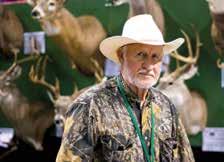

President and Chief Executive Officer Christina Pittman 210-729-0993 • christina@ttha.com
Editor Horace Gore • editor@ttha.com
Executive Editor Deborah Keene
Associate/Online Editor Martin Malacara
North Texas Field Editor Brandon Ray
East Texas Field Editor Dr. James C. Kroll
Hill Country Field Editor Gary Roberson
South Texas Field Editor Jason Shipman
Coastal Plains Field Editor Will Leschper
Southwest Field Editor Jim Heffelfinger
Field Editor At Large Ted Nugent
Graphic Designers Faith Peña
Dust Devil Publishing/Todd & Tracey Woodard
Contributing Writers
Jason Barrett, Bob Bauml, Jason Clayton, John Geiger, Clinton Goodpaster, John Goodspeed, Judy Jurek, Lee Leschper, Megan Luna, Andy Stephenson, Ralph Winingham
Sales Representative Emily Lilie 713-389-0706 emily@ttha.com
Advertising Production
Deborah Keene 210-288-9491 deborah@ttha.com
Membership Manager Kirby Monroe 210-809-6060 kirby@ttha.com
Director of Media Relations Lauren Conklin 210-910-6344 lauren@ttha.com
Assistant Manager of Events Jennifer Beaman 210-640-9554 jenn@ttha.com
To carry our magazine in your store, please call 210-288-9491 • deborah@ttha.com
TTHA protects, promotes and preserves Texas wildlife resources and hunting heritage for future generations. Founded in 1975, TTHA is a membership-based organization. Its bimonthly magazine, The Journal of the Texas Trophy Hunters®, is available via membership and newsstands. TTHA hosts the Hunters Extravaganza® outdoor expositions, renowned as the largest whitetail hunting shows in the South. For membership information, please join at www.ttha.com or contact TTHA Membership Services at (877) 261-2541.
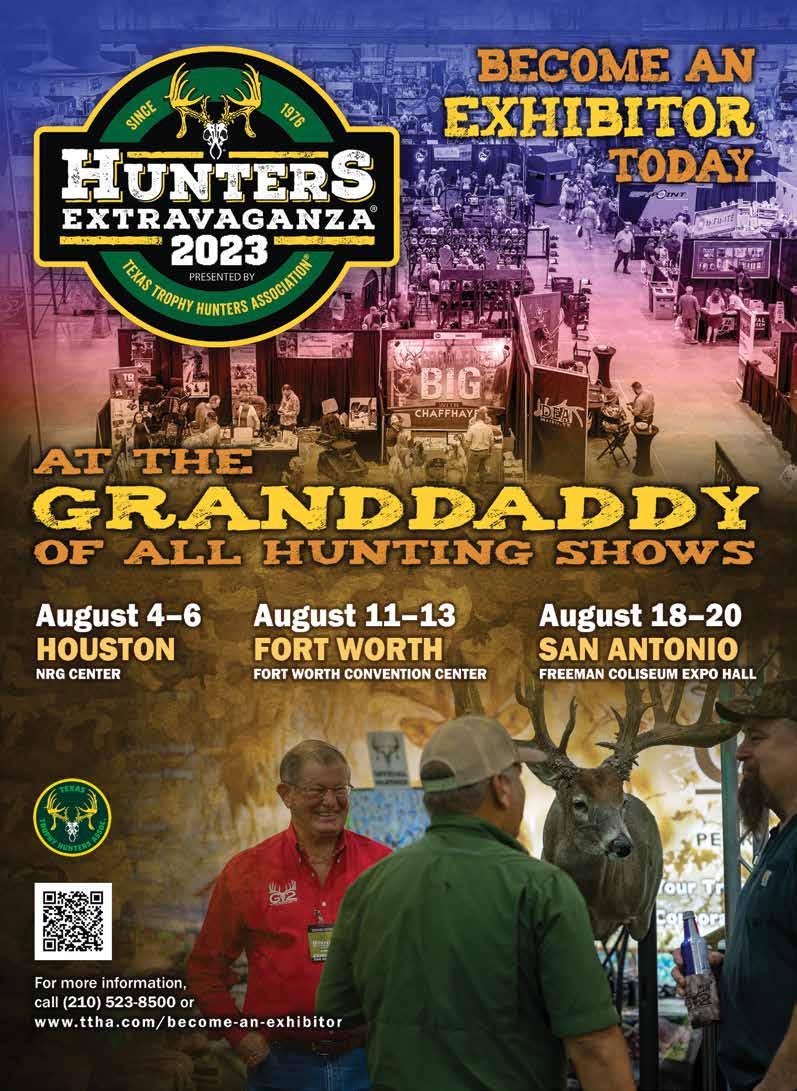


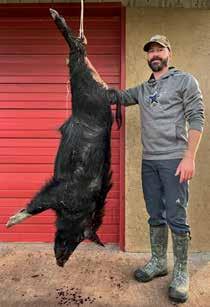


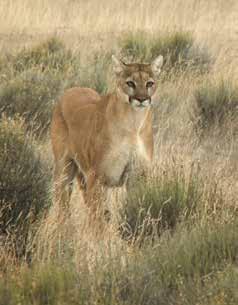



| By Jason Clayton




| By Clinton Goodpaster
| By Bob Bauml
| By Andy Stephenson
accompanied by a self-addressed stamped envelope or return postage, and the publisher assumes no responsibility for loss or damage to unsolicited materials. Any material accepted is subject to revision as is necessary in our sole discretion to meet the requirements of our publication. The act of mailing a manuscript and/or material shall constitute an express warranty by the contributor that the material is original and in no way an infringement upon the rights of others. Photographs can either be RAW, TIFF, or JPEG formats, and should be high resolution and at least 300 dpi. All photographs submitted for publication in “Hunt’s End” become the sole property of the Texas Trophy Hunters Association Ltd. Moving? Please send notice of address change (new and old address) 6 weeks in advance to Texas Trophy Hunters Association, P.O. Box 3000, Big Sandy, TX 75755-9918. POSTMASTER: Please send change of address to The Journal of the Texas Trophy Hunters, Texas Trophy Hunters Association, P.O. Box 3000, Big Sandy, TX 75755-9918.
TTHA member Natalia Reyes competed in her first national Archery Shooters Association Pro AM 3D tournament in Minden, Louisiana. The 10-year-old placed 4th in her class. She will compete in another national tournament in August. Meanwhile, she’s preparing for the 2023 Texas ASA State Championship in July. We wish her the best!
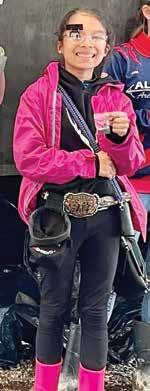



Lee Leschper (left) and Ralph Winingham participated at the annual Shoot for the Heart fundraiser for August Heart, a San Antonio nonprofit that has provided free cardiac screening for more than 62,000 high school athletes, to identify potential fatal and undiagnosed heart conditions. They have found more than 400 kids with potential heart issues, and undoubtedly saved some. Doré and Bart Koontz, the parents of 18-year-old athlete, August Koontz, who died in his sleep from an undiagnosed heart condition, founded the organization. Visit augustheart.org/ story/ to learn more.
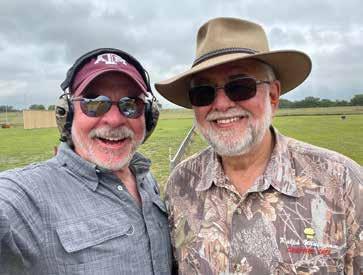


Judy Bishop Jurek is a pioneer of our hunting heritage. A longtime huntress and outdoor writer, Judy was raised in a hunting atmosphere, with her father and mother hunting deer, doves, and other Texas game. One of Judy’s first rifles was a .300 Savage with iron sights, handed down from her mother.

Judy was born in a farm family at Bay City, Texas, and raised prize cattle and showed appaloosa and quarter horses. “I had a sister, but I was daddy’s “tomboy” helper in raising livestock and in the shop,” she said. “I was always outdoors doing chores or helping where I could.”
Judy graduated from Bay City high school, and before long was married to a local farm boy, John Jurek. John is a hunter, and soon Judy was in deer camps or shagging doves. She loved the outdoors, and was soon hunting right alongside John. I have known both Jureks for over 30 years, and hunted with them on several occasions.
Back in the day, ladies were not so welcome in deer camps as they are today. John and Judy had to hunt by themselves, or be on a husband-wife lease. “I couldn’t find hunting clothes that fit me, but I managed to find appropriate outfits and boots,” Judy recalled. “Us [sic] gals were out of place at most hunting camps.”
Judy had several jobs around Bay City, but worked at Williams Energy for 26 years. After her long stint with Williams, Judy kept busy through the years, taking care of the house, cattle, and writing for newspapers and magazines. She became a member of Texas Outdoor Writers Association and eventually became a regular writer for The Journal of the Texas Trophy Hunters. In the meantime, She and John hunted South Texas for big whitetails, and Judy hunted axis deer and nilgai on occasion. Both Judy and John sported .300 Weatherby rifles, and were

hunting almost year-round for whatever was in season.
“I think I have written for every magazine with ‘Texas’ in their name,” Judy said. “I first wrote for The Journal in 1996, after John and I both killed 12-point bucks. Those were my first two stories as a Staff Writer.” Since then, Judy has been a regular contributor to The Journal
Judy is primarily a deer-hogdove hunter, but she got into exotics when she was asked to take an axis buck for the Texas Trophy Hunters TV show. After the axis hunt, she took a couple of nilgai on the King Ranch. Of course, the .300 Weatherby came in handy on the tough nilgai. Another unusual hunt was an invitation to bear hunt in Manitoba, Canada. “I like to eat what I kill, and I was not into bear hunting,” Judy recalled. “I turned down the hunt two times, but finally gave in.” The bear hunt on a concession in Manitoba was free, and Judy killed a black bear. “I didn’t care that much about killing a bear,” she said. “But I was hunting and I knew people back in Texas would ask about the hunt. So, I borrowed a 7mm-08 and brought back a bear cape and skull for mounting.”
Judy has had a .223 AR-15 platform rifle for many years. When she and John lived at Markham, and had a big herd of cattle, they carried the .223 for coyotes and hogs in the cow pastures. After hunting for years with the .300 Weatherby, Judy has now turned to the .223 for close range shots at deer and hogs.
In 2022, she took a big buck from her Mills County backyard with a neck shot from the little rifle. “That was my best buck in several years,” said Judy. The 10-point buck was old—one side of the

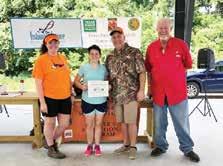
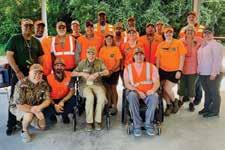

jaw showed 6½ and the other showed 7½. He had been injured on one hind leg, and the left antlers were slightly better than the right, but he was an excellent trophy buck.
Judy and I reminisced about the many years we both have hunted, and she remarked, “Things have changed so much since I started hunting. I remember going to the Houston Extravaganza in about 1978, and there were only four or five women at the whole show. Now, the crowd may include one-quarter or onehalf women at a given time.” Yes, many more females—old and young—hunt today. For women who have learned to shoot a shotgun, doves and turkey are exciting hunts. Today’s deer hunters include a lot of females, as shown by the big and little girls who bring bucks to the Hunters Extravaganza deer contests.

The hunting years have been good to Judy. She has promoted all manner of hunting through her writings in newspapers, various magazines, and especially The Journal. I know a lot of women in Texas who are expert hunters, and Judy is one of them. Her contributions to the sport of hunting and getting outdoors to enjoy the wilds of Texas makes Judy a pioneer of our hunting heritage.
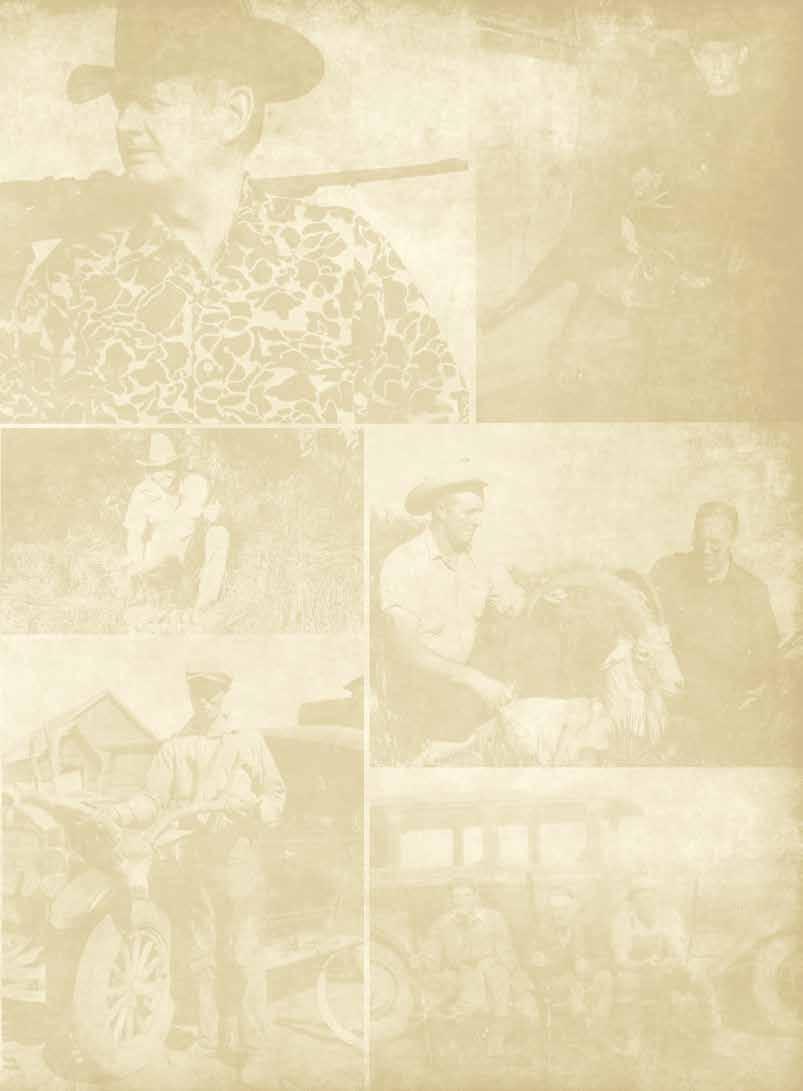


Due to an unfortunate error from the printing press, page 108 in the May/ June issue of The Journal of the Texas Trophy Hunters has an incomplete photo of Eric Stanosheck’s Coues deer. We strive to produce a quality magazine for everyone to enjoy. But sometimes due to circumstances beyond our control, the high mark gets missed. We apologize to our readers, our members, and Mr. Stanosheck.

Even though it’s the middle of summer, it’s not too late to partake in the 100th anniversary of Texas State Parks. Events at state parks will occur throughout the year to help celebrate. Visit tpwd.texas. gov/state-parks to find listings of events hosted at state parks.

According to the Texas Parks and Wildlife website, Texas State Parks began in 1923, and has been dedicated to protecting the best parts of Texas’ vast natural and cultural beauty. Originally envisioned as a series of roadside stops for highway travelers, the Texas State Park system has grown to a network of parks, historic sites and natural areas that welcome millions of visitors every year. In 1923, Gov. Pat Neff appointed a Texas State Parks Board to begin locating sites for the establishment of a state parks system. In 1933, President Roosevelt charged the National Park Service to lend their services as part of his New Deal program.
The Civilian Conservation Corps (CCC) built Texas’ park infrastructure, putting out-of-work Americans back on
the job. Texas State Parks transformed from a handful of undeveloped properties into a robust system of over 50 parks. Texans added camping, fishing, and hiking to their family traditions. Popular parks like Palo Duro Canyon, Garner, and Balmorhea were built by the CCC. While soldiers fought in World War II, Texas women kept parks operating. This opened the doors of change, elevating the roles of women in the workforce as leaders. Before the Civil Rights Act of 1964, African American citizens near Tyler and Bastrop State Parks successfully advocated for access to parks, regardless of the color of someone’s skin.
By the 1980s, parks were stretched to capacity. Thanks to significant public support for additional parks, the legislature expanded the system dramatically. Texans were becoming aware of the importance public lands played in maintaining a healthy environment. Parkland was acquired and managed to protect their habitat, uniqueness, and geological forms in order to preserve the land and the experience. Over 30 parks opened during this time, many protected for their unique resources, including Big Bend Ranch, Seminole Canyon, and Enchanted Rock.
Today over 630,000+ acres are devoted to Texas State Parks. Although Texas’ park system has expanded significantly in the last 100 years, 95% of Texas is still privately owned. This makes public land in Texas a precious resource for people and wildlife. Every inch of Texas public land is a seed of hope for future generations. —courtesy TPWD
The bipartisan Recovering America’s Wildlife Act (S. 1149) was reintroduced in the Senate by Congressional Sportsmen’s Caucus Members Sens. Martin Heinrich of New Mexico and Thom Tillis of North Carolina in late March. This legislation is a longstanding priority for the Congressional Sportsmen’s Foundation (CSF), which has served as a driving force behind Recovering America’s Wildlife Act since its conceptual stages in 2015.
Through their State Wildlife Action Plans, which serve as unique roadmaps to each state’s conservation needs, state fish and wildlife agencies have identified nearly 12,000 species identified as Species of Greatest Conservation Need (SGCN). These 12,000 Species of Greatest Conservation Need include many iconic species ranging from bobwhite quail, big horn sheep, monarch butterflies, to brook trout and arctic grayling. To address the conservation challenge facing these 12,000 species, the Recover-
ing America’s Wildlife Act seeks to provide approximately $1.4 billion annually to state, territorial, and tribal fish and wildlife agencies to proactively conserve SGCN before more costly and regulatory measures, such as listing under the Endangered Species Act may be necessary. Combined with a 25% non-federal match, Recovering America’s Wildlife Act would empower states to fully implement their State Wildlife Action Plans.
The Recovering America’s Wildlife Act was first envisioned in 2015 by the Blue Ribbon Panel on Sustaining America’s Fish and Wildlife Resources, which CSF served on as a leading group. Today, the Blue Ribbon Panel is represented by the Alliance for America’s Wildlife Act – a broad coalition working to advance Recovering America’s Wildlife Act. CSF President and CEO, Jeff Crane, has served as the legislative co-chair of the Alliance and the Blue Ribbon Panel since the concept of Recovering America’s Wildlife Act was first developed.
CSF thanks Senators Heinrich and Tillis for their continued support of fish and wildlife conservation as well as sportsmen and women through the reintroduction of Recovering America’s Wildlife Act. CSF looks forward to working with members of the Congressional Sportsmen’s Caucus, including Senators Heinrich and Tillis, to see a bipartisan, bicameral Recovering America’s Wildlife Act signed into law. —courtesy Congressional Sportsmen’s Foundation
Attendees of the 88th North American Wildlife and Natural Resources Conference, which wrapped up in April in St. Louis, got the first look at the results of the Hunting License Sales 2021-2022 report that documented a 3.1% decline in hunting license sales in 2022.
“We continued to track hunting license sales as one indicator of participation, and our results indicate that the impacts of COVID on getting people outdoors may be waning,” said the Council’s Director of Research and Partnerships, Swanny Evans, as he addressed the Hunting and Shooting Sports Committee
in St. Louis. “Hunting license sales are settling back to pre-pandemic levels.”
The study was a follow-up to the past two years’ Council to Advance Hunting and the Shooting Sports studies that documented a 4.9% increase in hunting license sales from 2019 to 2020 (otherwise known as the COVID-Bump) and a 1.9% decrease the following year from 2020 to 2021.
To continue monitoring sales trends in the wake of the pandemic impact, the Council revisited this study in early 2023 to identify ongoing changes and emerging trends in hunters’ rates of license purchases. Working with Southwick Associates, the Council collected monthly resident and nonresident hunting license sales data from 46 state wildlife agencies to quantify and compare 2022 to 2021 sales.
Among the 46 reporting states:
• Overall, hunting license sales decreased by approximately 3.1% in 2022 compared to 2021. Coincidentally, resident and nonresident license sales each were also down 3.1%.
• Just six of 46 states saw an overall increase in the number of licenses sold in 2022 compared to 2021.
• License sales were down overall in each of the four geographical regions (Northeast, Southeast, Midwest and West), with percentages ranging from -2.4 to -4.8%.
• The only months that saw overall increases in license sales – and slight ones at that – were February, and September.
• The surge in nonresident license sales seen in 2021 receded in three of the four geographical regions, with the only increase seen in the Northeast.
The report, which provides the most representative data on the current state of hunting license sales nationally and regionally, can be accessed on the Council’s website: cahss.org/our-research/ hunting-license-sales-2021-2022.
— courtesy Council to Advance Hunting and the Shooting Sports
Sen. Steve Daines
In late April, Congressional Sports -
men’s Caucus Member Sen. Steve Daines (R-Montana) reintroduced the Protecting Access for Hunters and Anglers Act, a bill to support the use of traditional ammo and tackle by sportsmen and women. This legislation is strongly supported by the Congressional Sportsmen’s Foundation (CSF).

Specifically, the Protecting Access for Hunters and Anglers Act prohibits federal land management agencies such as the U.S. Fish and Wildlife Service, Bureau of Land Management, and the U.S. Forest Service from instituting any restrictions on lead ammunition and tackle unless three triggers are met. First, any claims indicating a decline in wildlife populations at a specific unit of land where lead ammo and tackle is being restricted must be substantiated through field data from that unit. Additionally, the Protecting Access for Hunters and Anglers Act requires that any restrictions on lead ammo and tackle be consistent with the regulations of the impacted state fish and wildlife agency. Finally, the respective state fish and wildlife agency must concur with the need for regulation.
CSF maintains that any decision that seeks to limit the use of traditional ammo and tackle must be rooted in a scientific process, rather than emotional perception. The use of lead ammunition and fishing tackle should not be restricted by any arbitrary decisions that lack scientific justification. Additionally, non-lead ammunition and tackle options are often cost-prohibitive and not widely available, and as the markets have shown (primarily for ammunition), supply is still struggling to meet demand. Lastly, the inability to locate non-lead options, especially those that are reasonably affordable, has the potential to stave off participation, which in-turn may result in a loss of revenue for state fish and wildlife agencies through the American System of Conservation Funding.
CSF will continue to work to protect the use of traditional ammo and tackle for sportsmen and women. CSF will ensure that any efforts to restrict the use of lead ammo and tackle follow a science-driven process and have the sup -
port of the impacted state fish and wildlife agency, the entity best positioned to manage fish and wildlife. —courtesy Congressional Sportsmen’s Foundation
The Sables Education Programs are changing, but the mission remains the same. SCI Foundation and the Sables are committed to reaching educators, wildlife professionals, federal and state elected officials and others to educate them about the North American Model of Wildlife Conservation and the impor tance of hunting as a socially and culturally acceptable activity. To do this, we are developing new programs that build upon the tradition of excellence established by the American Wilderness Leadership School in Wyoming. These programs include:
Inform educators, non-governmental organizations, corporations, state agency personnel and others about the role of hunting in conservation and society by bringing our message to them wherever they are. We will rely on partners and sponsors to implement custom programs that meet their needs. This can include American Wilderness Leadership School programming and more.
Working with SCI Government Affairs staff, provide educational programming and outdoor activities for federal and state legislators and their staff so that they are familiar with the North American Model and the economic, cultural and management importance of hunting in the United States. The first iteration of this program was successfully implemented in August with six U.S. representatives and 24 staffers in Montana.
More and more Americans now get their news and information from social media sources, including social media personalities (influencers and brand ambassadors). SCI Foundation will use the platforms and experiences of these
individuals to build social acceptance of hunting among young people.
Colleges and universities are key places to access younger generations and educate them about the role of hunting within the North American Model of Conservation. SCI Foundation will partner with university programs to bring our message to tomorrow’s leaders.
As the programs listed above are implemented, we will be monitoring their impact and costs. This gives us a chance to assess interest in this new approach, evaluate our curricula’s impact and reach, and determine the real cost. As with any program, we will be monitoring the results and adjusting, if needed, to reach the younger generations and pass on the importance of conservation and how hunting benefits land and wildlife conservation.
Opportunities to sponsor or partner with SCIF are available and critical to continuing to have an impact through these programs. SCIF staff will work with partners and sponsors to develop curricula specific to your location and important issues. Program length and content can vary, depending on your needs. We will also work with partner organizations to find suitable locations to host various events.
Please contact SCIF or Assistant Education Director Todd Roggenkamp at (520) 954-0664 or troggenkamp@ scifirstforhunters.org to learn more about these programs. All of our education programs rely on the interest and support of individuals, foundations, corporations and other conservation organizations.
—courtesy Vicky Swan, Sables president
SCI has been busy around the nation advocating issues important to its members, as well as all outdoor enthusiasts. Here’s a quick list:
Colorado: SCI joined two comment letters in support of Senate Bills 255 and 256. SB 255 would create a wolf depredation compensation account and SB 256 would prevent the reintroduction of gray wolves without a federal Endangered
Species Action Section 10(j) designation.
Florida: SCI encourages support of Senate Joint Resolution 1234 and House Joint Resolution 1157 propose to preserve in perpetuity hunting and fishing as a public right and preferred means of responsibly managing and controlling fish and wildlife.
Montana: SCI issued an action alert to Montana members regarding supporting HB 372, the constitutional right to hunt, fish and trap amendments.
New York: New York chapters signed onto letter supporting the “Make the Youth Deer Hunting Program Permanent” in the budget which builds off of a precedent set by the 2021 budget that expanded opportunities for junior hunters and would permanently authorize 12- and 13-year-old hunters to pursue deer with a firearm or crossbow when supervised by an experienced adult hunter.

Oregon: SCI joined a coalition letter in opposition to Senate Bill 348, regarding legislation that would require an expensive and exhaustive permitting process for the lawful transfer or firearms, impose a 3-day waiting period on firearm purchases, impose training requirements on Oregon’s law-abiding hunters and recreational shooters, restrict firearm purchases for Oregon’s youth hunters under 21 years of age, and restrict standard capacity magazines commonly found in the hands of hunters and recreational shooters.
SCI also joined a coalition comment letter in opposition to House Bill 2006, regarding restricting persons under the age of 21 from possession firearms and creating an obvious barrier to recruiting new hunters.
SCI issued an action alert to Oregon members regarding supporting House Bill 3086 with the -4 amendment, which would change the membership of the Fish and Wildlife Commission from a congressional district representation model to a watershed representation model.
Washington: SCI joined a coalition letter in opposition to House Bill 1143. HB 1143 would require a 10-day waiting period for firearms purchases and create new training requirements on Washington’s law-abiding hunters and recreational shooters. —courtesy SCI

In my first article (March-April 2023 Journal) I discussed how a growing movement exists for management of wildlife on private lands, spearheaded by families returning to either family land or acquiring new land on which to develop a family heritage of wildlife conservation through management. The real future of game conservation lies squarely in the hands of the private landowner, since government lacks neither adequate funding, nor the interest in land management. You do not have to be part of the “landed gentry” to become a wildlife manager, rather just willing to invest what you can in making a piece of land of any size better than you found it.
My second article (May-June 2023 Journal) highlighted what Jason and Stephany Woods and their family do to turn a leased property into a white-tailed deer factory and wildlife paradise. Working closely with a landowner who fully understands the commitment they are willing to make on another person’s land has indeed created a place where generations will reap the benefits of their hard work.
To quote Aldo Leopold: “Actually, game administration in this country has so far concerned itself almost entirely with two things: regulating abuses by the exercise of its police powers, and attempting to practice management on private lands without the co-operation of the owner. The latter attempt is bound to fail in the long run, because government cannot control environment on lands which it does not own.”
In this article, I will present an example of a family who purchased land in an area not yet thought of as a deer hunting mecca. Oklahoma is experiencing a modern-day land rush by families wanting to work a small piece of the Lord’s country.
Todd Waddle’s family recently purchased a half section—320 acres—of land in eastern Oklahoma, for the sole purpose of developing a family heritage focused on land stewardship, hunting and outdoor recreation. On the surface, their new land did not have the trappings of a game-rich property. Lying in a rural area of Oklahoma, the property had been managed for cattle, rather than deer. The
official ecological regionis the


In this area, Todd Waddle is planting brush species such as red cedar, Chickasaw plum, blackberry and sumac, with an outer edge of switchgrass.


northern extension of the Cross Timbers running north to south out of Texas. About a third of the area was “useless” because it is seasonally flooded. The woodlands in the uplands were mostly dominated by young, extremely dense stands of non-mast producing hardwoods that provided little in the way of wildlife food. The upland portions of the property consisted of over-grazed pastures, intersected by hardwood drainages and young stands of eastern red cedar. Remember, the Waddle family were faced with converting a cattle operation to wildlife habitat. Another challenge was the property was bordered on two sides by a public road that, shall we dare to say, encouraged visits by the hunting “night crowd.”
We began working with them here at the Institute after they attended one of the Dr. Deer’s Whitetail World Field Days a couple of years ago. Todd asked us to come to Oklahoma, and see what could be done. As with many of the new landowners we meet, there was no doubt he and the family had the will and enthusiasm to invest money and “sweat equity” in carrying
out our recommendations. Their “wildlife management staff” included the parents, the kids, some family relations and good friends—all dedicated the cause.
The first step was to take advantage of the wooded drainages which, if improved, could provide the main travel corridor across and around the property. As is traditional with the area, cattle were allowed in woodlands, devastated understory shrubs and herbaceous plants. Once cattle were removed, we
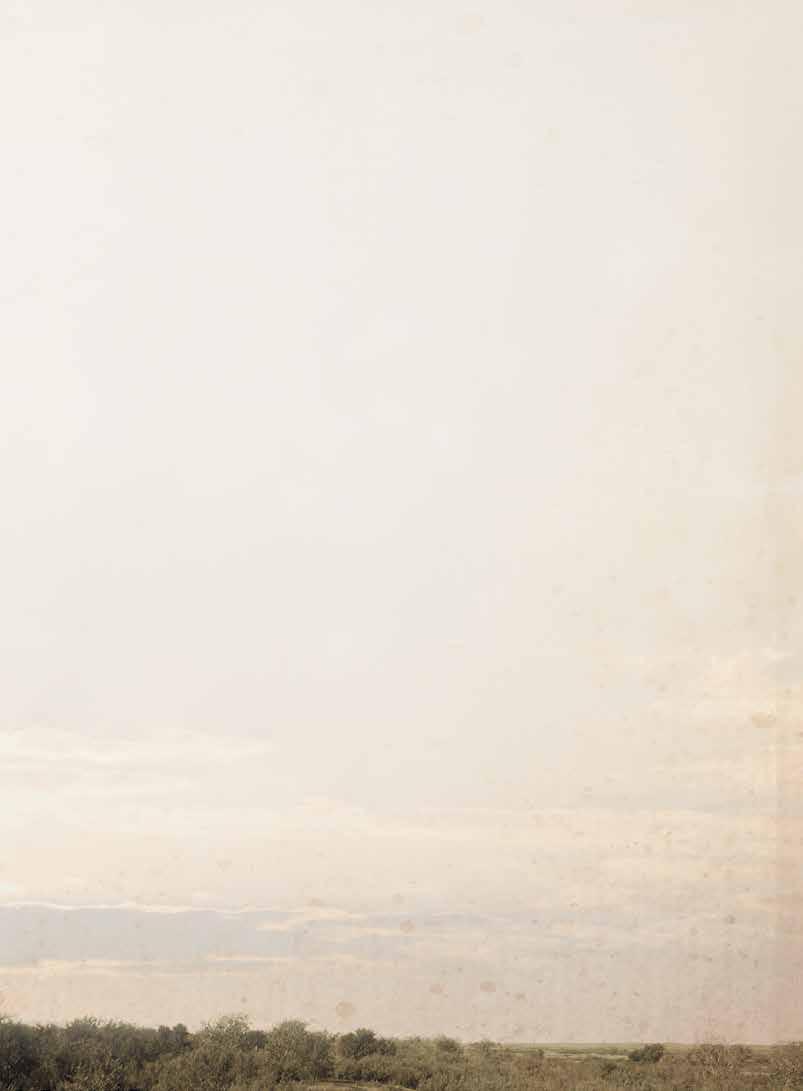
started thinning the drainage woodlands to allow sunlight to reach the understory. We also added edge species such as blackberry, dewberry, wild plum, sumac, honeysuckle and greenbriar; with an outer layer of switchgrass and gama grass.
Water is critical to deer management, and we recommended developing water in at least 80 acres of the property—including small ponds and artificial water. Food plots, both cool and warm season, were developed for at least 5% of the property. The original food plots were poorly developed and not planted to the most useful species and varieties. They also were underfertilized, so we recommended a soil analysis. Our standard for that part of the world is a cereal grain such as cold-hardy oats in the uplands and clover, chicory and oats in the lowlands.
Cover is critical for deer management, and a well-placed summer and winter thermal component helps hold deer on the property. We plant or encourage eastern red cedar for winter thermal and thinning hardwoods in the bottoms for summer thermal. The Waddles use both bulldozers and mulchers to create summer thermal cover and native foods in small patches in the bottomlands. The best way to deter folks seeing into the property from the roads is to plant layered, fast growing trees (red cedar), sumac, switchgrass as perennials and annuals such
as Egyptian wheat or sorghum/sudan grass a width of 25 or so feet from the road edge. The annuals will “hold the line” until the perennials develop.
Deer herd management relies on year-round trail cameras at a density of one per 80 acres. We published an article some time ago on how to use trail camera photographs to obtain an accurate estimate of the deer population, demographics and density. As often happens, the owners were surprised to discover they had an estimated 84 deer, including 21 bucks, 42 does and 21 fawns, which is not a bad start for being in the early years. The family plans on signing up for the Oklahoma White-tailed Deer Management Assistance Program. It allows increased doe harvest eliminating antlerless days, including December.
In three years, the family are way into an ambitious management program that will pay off over the years in providing quality hunting, as well as the family heritage they seek for generations to come. Leopold was right when he expressed optimism about private landowners and game management. That is not to imply that public wildlife management does not have a place at the table; rather, that the role of the private landowner is critical in conservation in the 21st century.


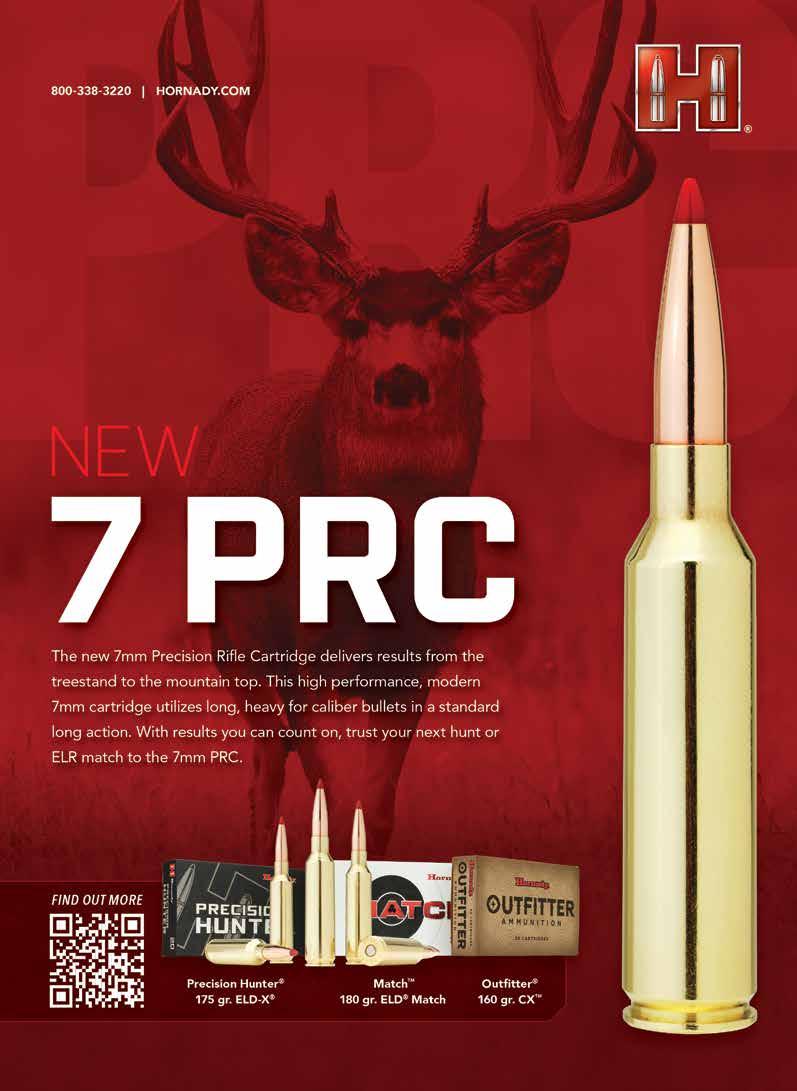
Brittain Griffith had to endure a long wait in order to get this wide trophy buck.

Brittain Griffith started out hunting deer with his granddad, “Dandy,” along the Neches river bottom in East Texas. While in high school and college, his interest shifted to duck hunting. Years later, his attention reverted back to his love of deer hunting and his efforts have since fueled his passion for chasing mule deer in the western states along with big whitetails in Texas. When it comes to hunting, you could say that Brittain’s path completed a full circle back to deer hunting.
Brittain is a self-professed mule deer fanatic, and as such, begins every hunting season out west in search of long-eared mulies. When mule deer season is behind him, he focuses on whitetails in the South Texas brush country. “I’ve hunted in South Texas for over 10 years, and have forged some great relationships and taken some exceptional trophy bucks during that time,” he said.

Last season, after striking out on a giant mule deer, Brittain returned to Texas dejected, but optimistic about hunting
whitetails with friends. “I knew it was going to be a tough year after the drought, but after taking care of things at home and work, I couldn’t wait to be hunting whitetails again,” he said.
A few weeks later, Brittain went hunting with some friends when a good buck caught his eye. “We were watching a real trophy buck—a massive 6x7—when we noticed another buck at the edge of the brush. He had a big, wide frame and really caught my attention. The buck was a standout and that’s saying a lot considering the company he was keeping,” Brittain said.
The old, wide buck stood motionless and partially concealed for what seemed forever. “The buck was impressive, and I was ready to shoot. Several times I considered trying to weave a shot through the scrub tree limbs. I envisioned dropping the huge buck in his tracks,” Brittain added.
Not wanting to take a chance, Brittain decided to play it safe and opted to wait and see if the buck would come out and join the other feeding deer. Being a wary adversary of sorts, the wise old buck surveyed his surroundings before simply turning around and walking straight away. “I just about lost it, watching
helplessly as the buck faded back into the brush,” said Brittain about his dilemma.
They hunted the next morning but to no avail, and the wide buck went unseen. Family and work commitments required Brittain to return home empty handed. “I had a sick feeling to my stomach and it was hard to leave without that buck,” Brittain said. It would be several days before a busy schedule would allow him to continue his pursuit of the buck.
“The wait was agonizing and the buck consumed my thoughts,” Brittain said. “I was going through all the what-if scenarios. What if I would’ve squeezed the trigger? What if he breaks his antlers in a fight? What if we can’t find him again? I rationalized that it was meant to be and could still possibly work out. Either way, I was going to try, and I couldn’t wait to get back to hunt.”
After a several days, and what seemed like a perpetual delay of game, Brittain finally went hunting again, in search of the wide buck. “The rut was in full swing, and we were on our way to a blind for an afternoon hunt, when we saw a big-framed buck with a doe in the brush and thought it could be him,” Brittain said.
“We quickly got into the blind and watched as deer began to filter out to feed. When the buck did not show, we began to glass the brush thinking maybe he was hiding with the doe,” he said. “We were finally able to find them in the thick cover, and the doe started to come out to feed, but the buck kept cutting her off. As they moved in and out of the brush it was then that we were able to determine it was indeed the wide buck I was after.”
Unsure exactly where the buck might step out, Brittain repositioned several times in an effort to prepare for a potential shot opportunity. “He had me guessing. I wasn’t sure where he was coming from and at one point I thought history was going to repeat itself, and he was going to slip out the back again,” Brittain said. This scenario played out for about an hour, with only brief sightings of the deer as the light began to fade.
Finally, the doe trotted out of the thick brush at about 150 yards with the big buck in tow. “He stepped out and was
everything I remembered, but I didn’t want to spend too much time looking at him,” Brittain quipped. Quickly, he focused on getting the rifle up. He wouldn’t miss an opportunity for a good shot. The rifle roared, and the .30-06 bullet went on its way, instantly dropping the huge buck.
“I was so excited, and it was such a relief to see him down,” Brittain said. A celebration began, as Brittain made his way to the fallen trophy. “He just kept getting bigger and bigger as I walked up and finally got my hands on him. I was actually a
little speechless and just in awe,” Brittain said.
The buck had a huge typical 6x6 frame, with good width, mass, and long, swooping main beams. “I reveled in the moment, as I had never killed a deer that wide,” Brittain said. “He’s had the look and was put together the way I’d envision a trophy whitetail. He was well worth the wait, and I couldn’t have been happier!”


Iwas the kid from Alpine, the cadet who traveled the farthest. In the summer of 2022, I had the opportunity to attend the 1st Battalion of South Texas Ranch Brigade at the Duval County Ranch in Freer, Texas. It was a fantastic program that provided hands-on education about ranch life, resource management, and proper cattle care. The camp was a delightful experience.
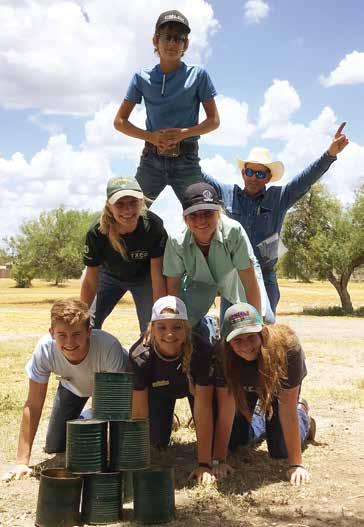
Throughout the five-day event, cadets learned the process of cattle marketing, beginning from a calf being born to when the beef is fabricated and sent to markets. The manager of the Duval County Ranch allowed us to vaccinate, deworm, ear tag, and castrate calves on the ranch. We also had the chance to observe a necropsy and ascertain knowledge of the fabrication process. Along with looking at the cow as a whole, we studied the necessary natural resources for the cow to be healthy. One day, cadets were taken to different locations on the ranch to obtain four grass species (either introduced or native) per herd. Herds are teams of four to five cadets that work together throughout the week to complete various competitions. After each herd had acquired the assigned plants, we then did calculations to determine how many acres of grazing land were needed per cow, based on the grass quantity and quality. We reviewed 21 different native and introduced plants during camp.
One of the main goals of the Texas Brigades camps is to turn us into conservation leaders through the analogy of turning coals into diamonds. We worked towards this through various leadership and team building games. These included activities like the human knot, making a pyramid out of cans with ropes, and discussing what develops a good leader. Being a good leader also requires good sportsmanship, which we exercised during the ranch competitions. The competitions entailed ranch chores, goat sorting, roping, and fence building. Another way that we competed together throughout the week was through daily trivia sessions, plant quizzes, and presentation etiquette. The summer camp was packed full of activities and education covering much of what is needed to be a land steward.
Cadets had an amazing opportunity to learn and make new friends that were interested in a lot of the same things. Every cadet was required to write a thank you note to two of our tuition
sponsors or donors, make an educational poster to present to their community, and assist in the making of their herd’s plant collection. Not only were we fed astounding information, but we also had some amazing experiences with the food provided. The first couple of days, there were some chuck-wagon folks that showed us original dutch oven cooking and some of their
favorite foods. Another day, the Texas Beef Council visited and provided burgers for us, and the day of ranch competitions, the Beef Loving Texans demonstrated how to grill a steak. As we were about to begin grilling our own steaks, it started raining and that ended our steak cooking.
One of the speakers gave a communications boot camp that not only taught us the benefits of proper communication, but taught us the proper way to communicate with people. We

reviewed the correct way to shake someone’s hand, methods to ask open-ended questions to keep a conversation going, the follow-up procedures of your presentation, and we were reminded to always enunciate and make eye contact. After the main portion of the communications boot camp, we did some interviews with another one of the presenters who asked us about our experience at camp. We were instructed on how to do a successful interview, and we then practiced a couple of improv interviews about ourselves.
Overall, South Texas Ranch Brigade provided a fantastic experience for teens wanting to learn more about ranch management and land stewardship. The week was extremely fun and exhausting. From writing about the sunsets and sunrises to getting a bucket of cold water dumped on your head after a leadership activity, South Texas Ranch Brigade never failed to amaze me with the amount of dedication each instructor and cadet gave to the camp. All of the staff and volunteers were energetic, excited to teach, and learn a little bit about each of the cadets. While it was a very activity-packed week, we had laughs and so many stories to be told about each and every one of us. This experience will always be a joy to look back on, and I look forward to next year to experience another Brigade camp all over again.
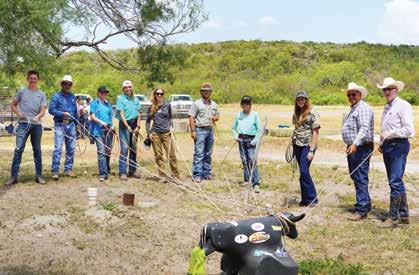
Texas Brigades is a conservation-based leadership organization which organizes wildlife and natural resource-based leadership camps for participants ranging in age from 13-17. Its mission is to educate and empower youths with leadership skills and knowledge in wildlife, fisheries, and land stewardship to become conservation ambassadors for a sustained natural resource legacy. There are multiple camps scheduled in the summers, focusing on different animal species while incorporating leadership development. Summer camps include Rolling Plains and South Texas Bobwhite Brigade, South and North Texas Buckskin Brigade, Bass Brigade, Waterfowl Brigade, Coastal Brigade, and Ranch Brigade. Visit texasbrigades.org or call 210-556-1391 for more information.
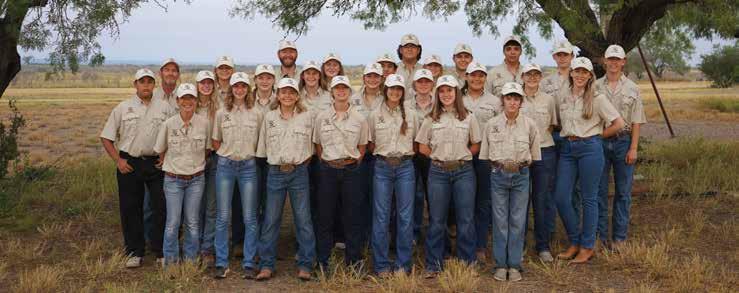


My son Cash was fortunate enough to have taken a gold medal class axis buck at our family farm. The buck’s exceptionally long secondary tines, called caudal tines, are unique. One side is even longer than the main beam, which isn’t common for this species.
One Sunday evening, my boys told us about a really nice axis buck they had seen while they were driving back to the house from feeding the livestock. Yes, these two drive and have been driving at the farm since they were about 6 years old. We’ve seen a few nice ones over the last few months, and taken some monsters in the past, but we had not seen this one before. The boys were very excited to show him to me, so later that evening we headed out to look for the buck.
We found a nice herd in a large thicket of cedar trees where we’ve seen others hanging out in the past. My oldest boy, Case, saw him first and was trying to point him out to me. Daylight was fading fast, and they have better eyes than I do. I had to reach for the binoculars.
Once we got a good look at him, I told the boys the buck was a good one. We also needed to work on a game plan for trying another day to see when we could try to catch him moving around ASAP. Axis like this one don’t hang around too long, sometimes by the deer’s choice, or because of other hunters. Cash had already staked a claim on him because Case had shot the last deer. Between my work schedule, school, and 4-H,
we were limited on how soon we would get the next chance to hunt for the buck. We had a few evenings the next week that would be the earliest opportunity for us, but unfortunately the weekday mornings are when the boys are “supposed” to get ready for school and I get ready for work.
While hunting one evening, we spotted the axis herd that the buck had been seen with. But he was not participating in their evening feeding, which wasn’t surprising because he was the herd bull. Those are typically the last to appear.
The next morning, I had to go to town for work and the boys were off to school. While Mom was heading down the road taking them to school, they saw the big axis buck we were looking for, walking across the hay field about 300 yards away. I got a call from the boys letting me know the buck was still around and how frustrated they felt because they had to go to school instead of hunting for him.
The next day we were eager to try and take this buck. I figured it wouldn’t hurt if Cash was a little late to school, but his mom didn’t feel the same, so we decided to see if we could get
Cash with his dad, Jason. During one previous attempt at this buck, Jason allowed Cash to be late for school in order to take the axis. Cash’s mom wasn’t happy, but Jason said it was worth the attempt.
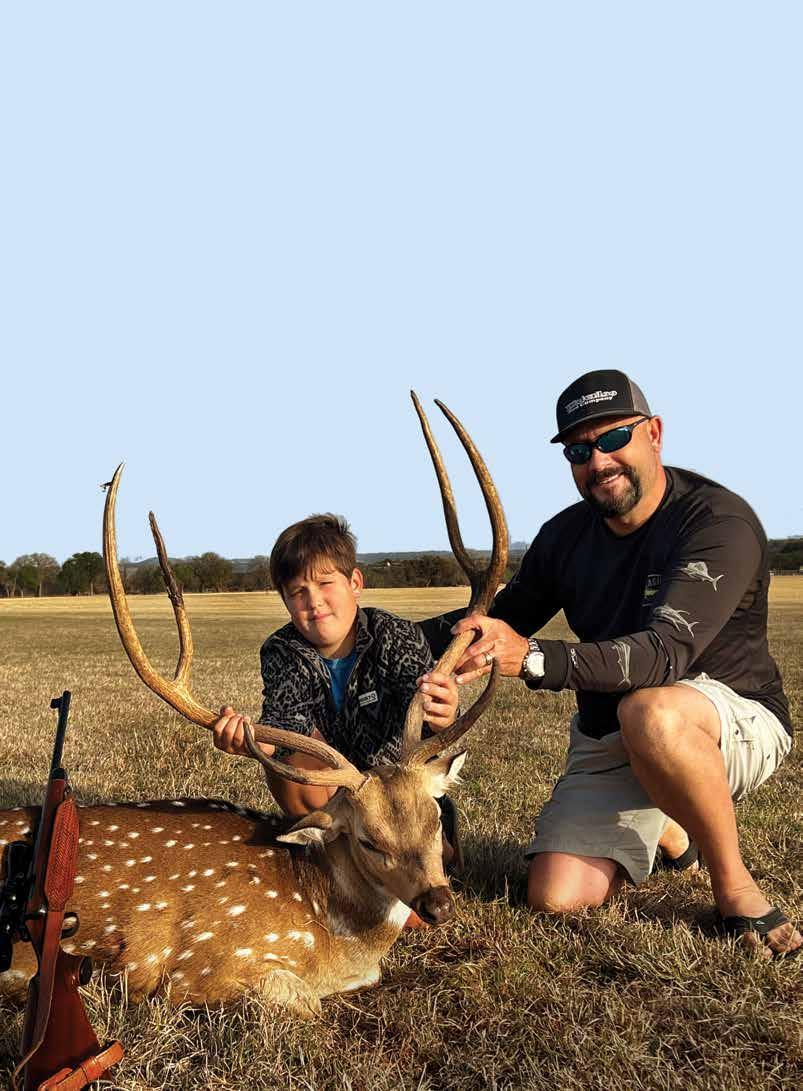
lucky and catch him first thing at daylight. Needless to say, he was a no-show, and the boys were late to school. It was worth the try!
We hunted that evening and had two different axis herds come out to graze. As luck would have it, the buck came out last with one of the herds and managed to stay in the middle of them all. He didn’t present a clear shot. When he decided to walk off, he went in the opposite direction chasing a doe that caught his interest, which did not present a good, ethical shot for a youngster.
The weekend arrived and Cash and I grew more anxious. We planned to get an early start Saturday morning, in hopes the buck would cooperate. Around 7:30 we had an axis herd step out of the tree line about 200 yards away, and they were moving our way. One after another they kept walking out of the trees in a line following right behind each other.
The last one to walk out with the main herd was a mature doe. Knowing the bucks are the last to show, we were both excited and worried the buck may not show. I started scanning the brush for any movement, and standing in the cedars watching was the big axis buck with his head tilted back and nose in the air. Once we saw him, we knew he was glued to the doe and would follow. When he stepped out and started
his way towards the group to catch up, Cash caught buck fever. What made it even worse, Cash had to watch the buck slowly make his way up the field till he was in range and broadside to present a good shot. Once he was in range, I told Cash I would get the buck to stop and reminded him to relax, get a good rest for the rifle, and squeeze the trigger. Within a split second of me stopping the buck, the gun went off. I guess Cash was afraid he’d get away. I could tell Cash made a good shot and that the buck was hit hard by the way he lunged and ran about 20 yards before stopping and lowering his head. But I still had Cash chamber another round and told him to hold it on him in case he needed a follow-up shot. After about a 10-minute wait, we walked over to pay respect and admire the beautiful animal he has just taken, followed by some nice field pictures with the family.
As most who hunt know all too well, this is where the fun stops and the work starts. I can’t say Cash doesn’t complain, but he sticks with it. Cash and Case have been fortunate enough to have been brought up around hunting and have been taught the process of field dressing, as well as being fortunate enough to say their family processes their own animals for sausage, jerky, and more. There’s a greater level of appreciation for wildlife when someone is able to experience the full circle of stewardship and hunting. Job well done, son!
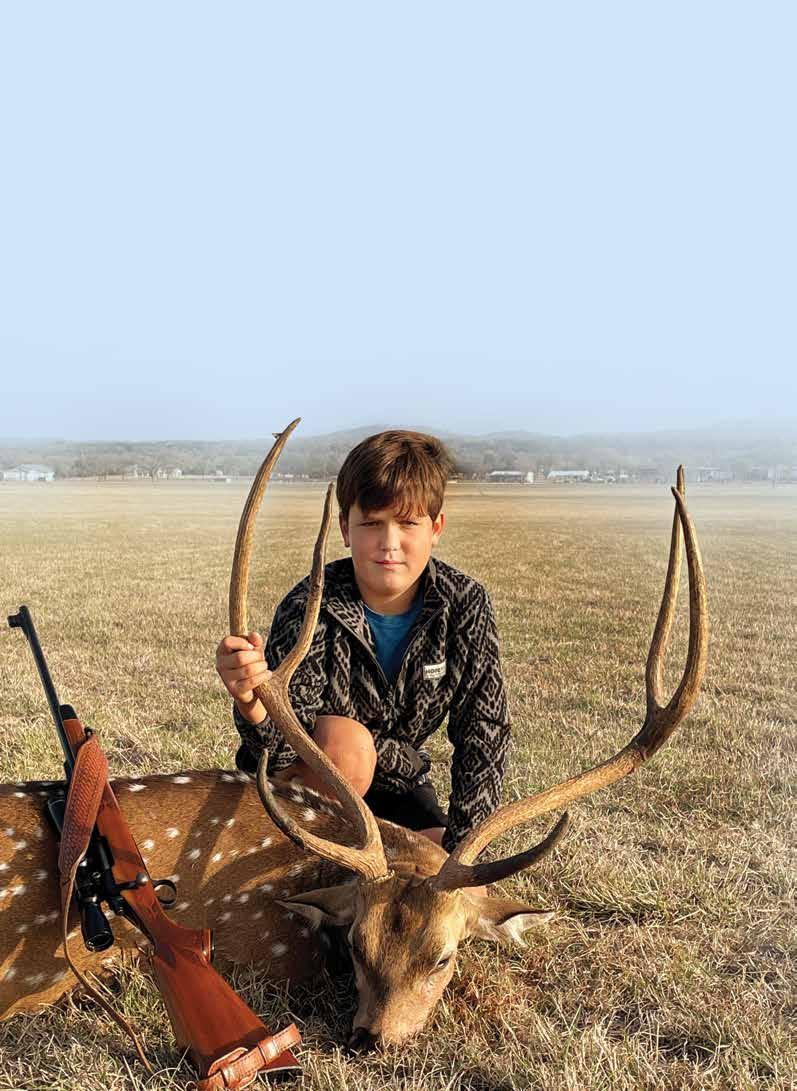







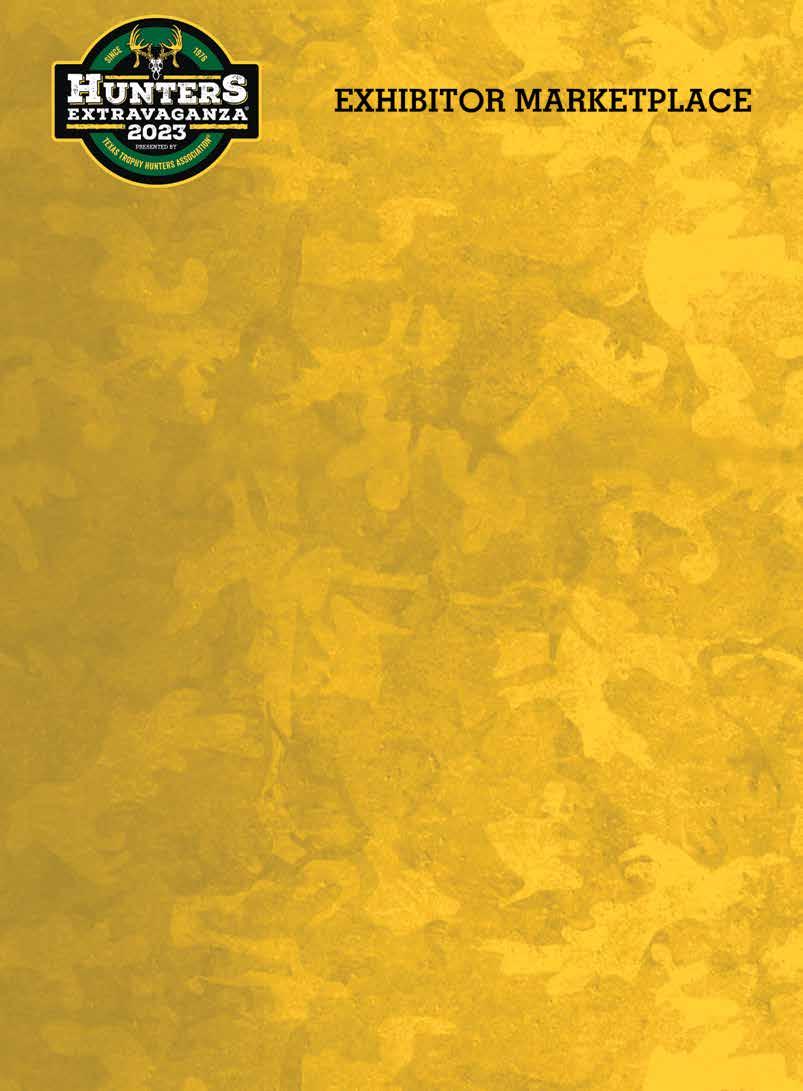


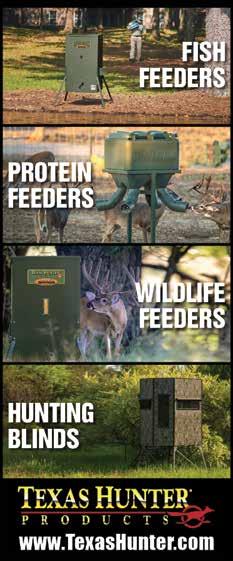
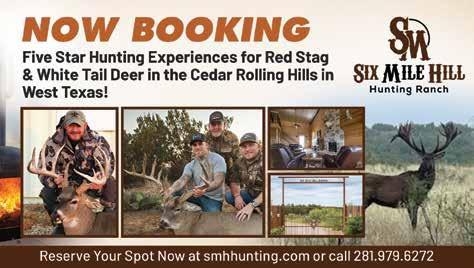

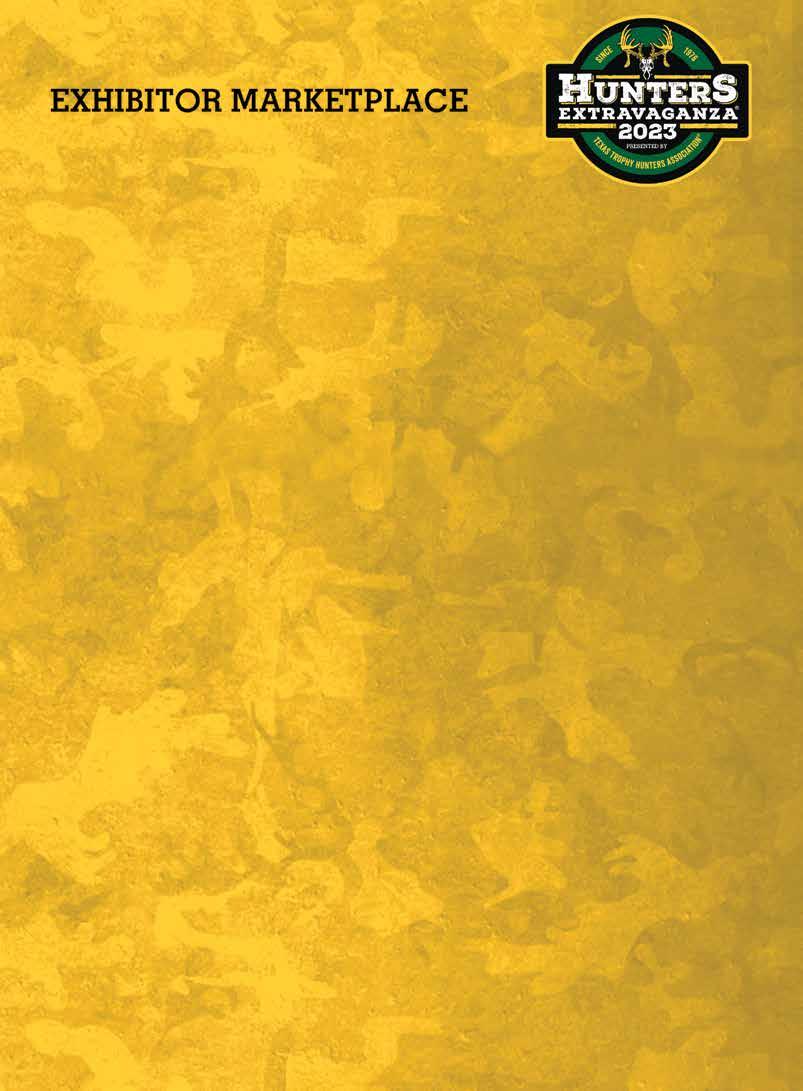





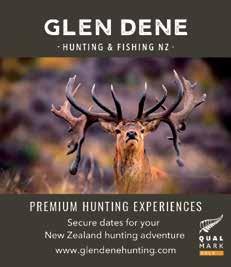
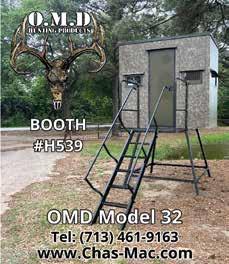





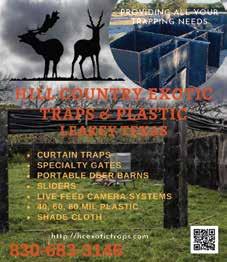




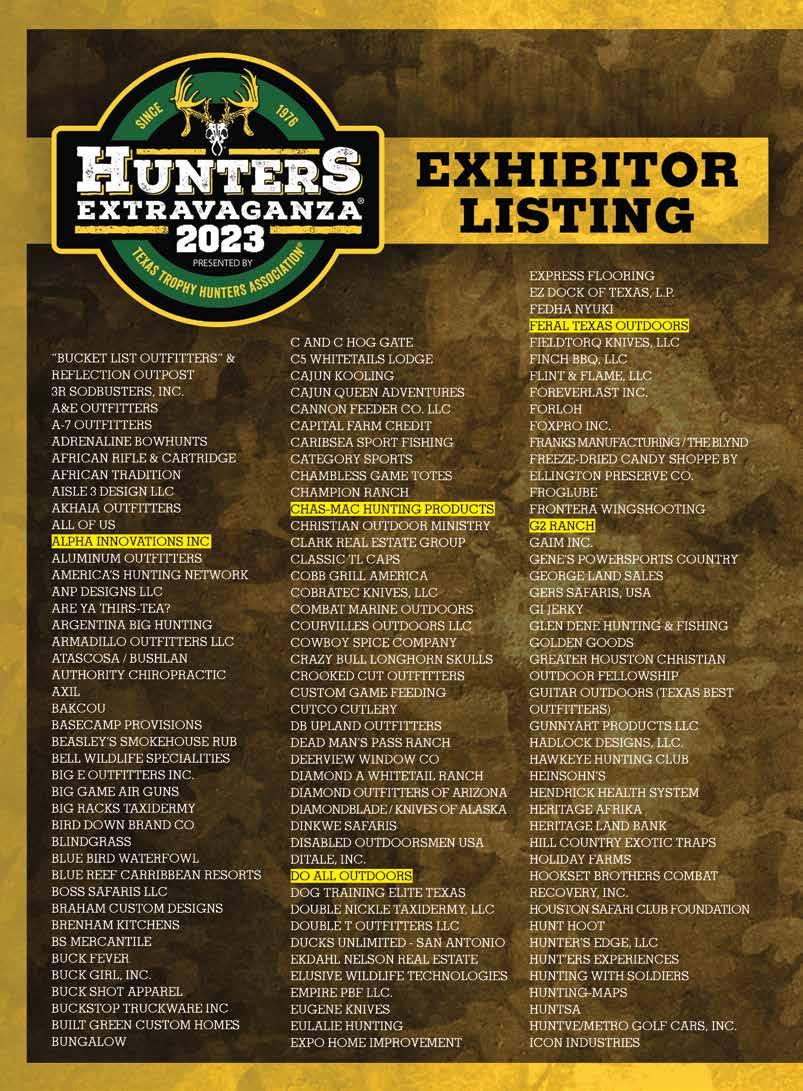
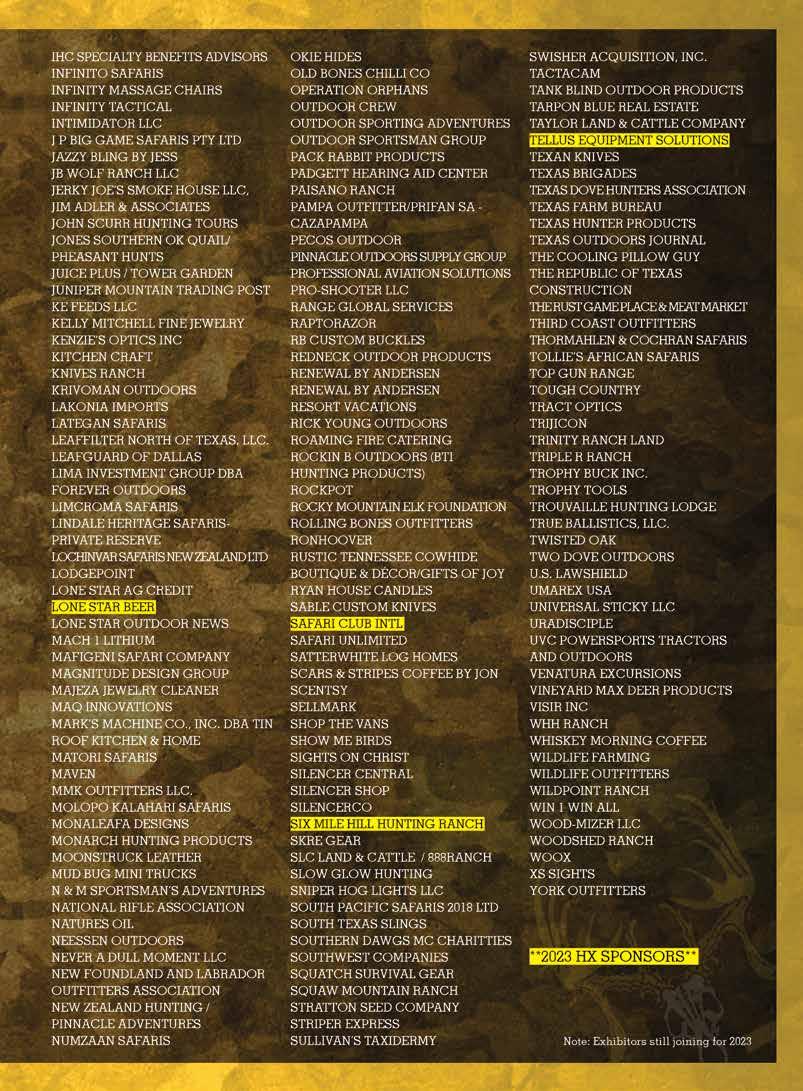


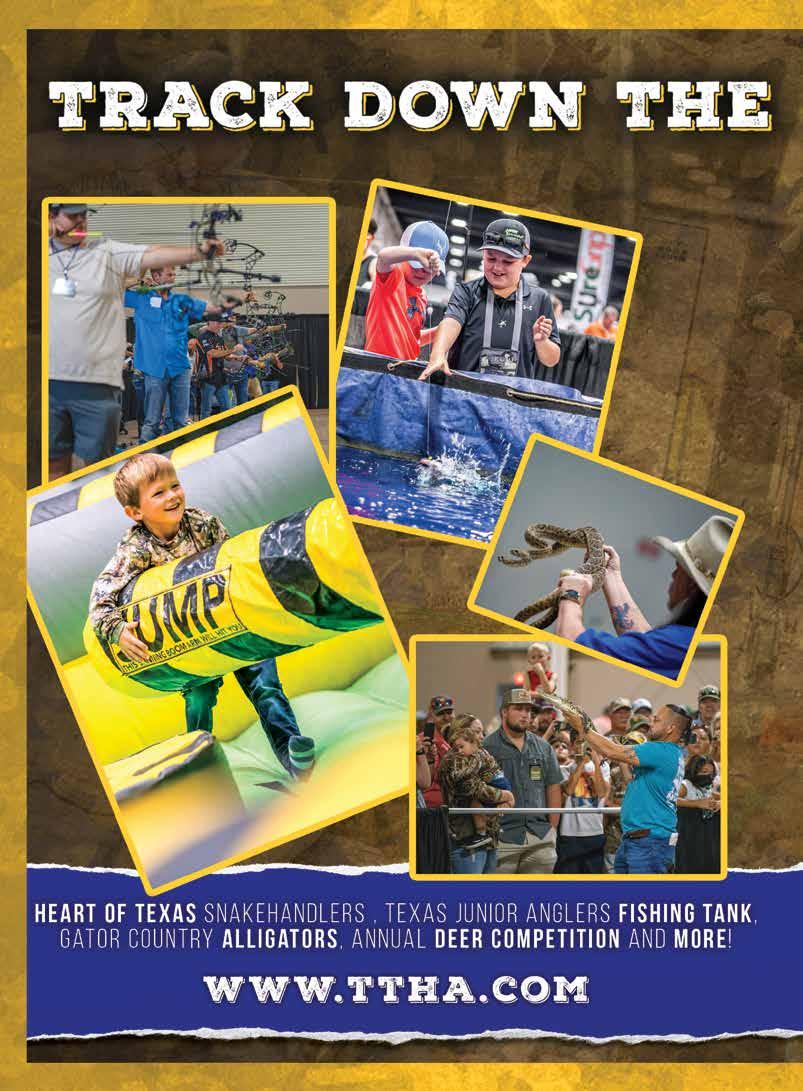
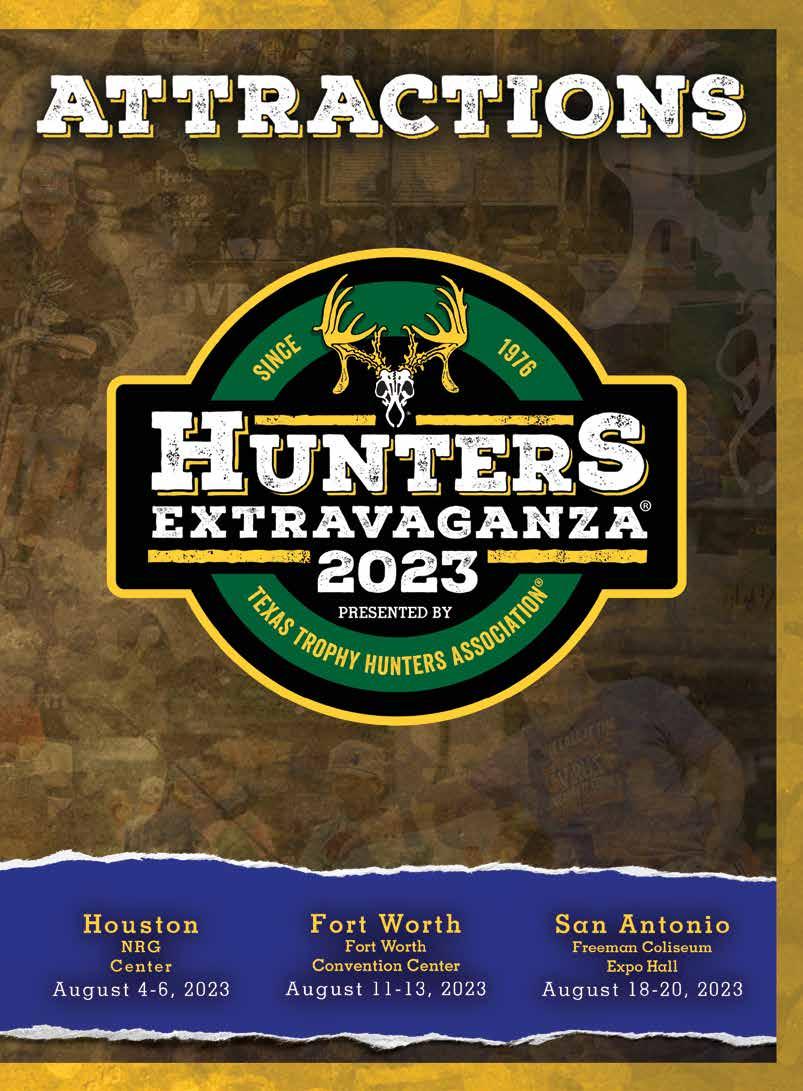





Members of Safari Club International, as well as Texas Trophy Hunters Association CEO Christina Pittman, traveled to Washington, D.C. to lobby on behalf of both organizations to ensure hunting and conservation maintain a vital role in our nation and abroad. Outdoors enthusiasts should be keenly aware of who is looking out for you and defending your freedoms to enjoy the great outdoors whether as a hunter, fisherman, hiker, biker, etc.
“Safari Club International raises monies for wildlife conservation, education, advocacy and humanitarian services not just internationally, but right here at home in the US,” said Jimmy Fontenot, past president of the SCI San Angelo, Texas, chapter.

“Our team of specialists within SCI are constantly researching, litigating, and literally fighting for YOU every day against the constant onslaught of anti-gun, anti-hunting agendas. I’m proud of our presence on Capitol Hill. I invite all of you to stand up for what you believe in and help protect our freedoms from the radical left. We can make a difference, but it will take all of us joining as one to make it happen.”
Here in Texas, you can participate by directly contacting your congressional representative, as well as Senators Ted Cruz and John Cornyn.



Ihave dreamed of Africa for my entire life. A magical place and land known for its vast country and incredible animals that inhabit the area. Watching so many different shows on TV throughout my childhood and life that depicted this part of the world like National Geographic, Jack Hannah’s Animal World, Animal Kingdom, and so many more, made me dream of one day exploring this amazing country.
The stories over the years from other hunters and a few dear friends able to go to Africa and hunt were extraordinary. The game animal pictures I saw and the stories I heard were hard to comprehend as a mere guy from Texas. Everyone I talked to that went to Africa to hunt had a great journey. Later on, I had the chance to watch Chuck Adams, Tom Miranda, and more extraordinary hunters bowhunt in Africa and take many beautiful, trophy African game.
I had the chance to visit with several outfitters from Africa at the 2021 Texas Trophy Hunter’s Extravaganza in San Antonio and came across Limcroma Safaris out of South Africa. After learning about their hunting safari and the way they operated and catered to the bowhunter, I booked my hunt for September 2022. Hans and his entire team truly had an experience for couples, small groups or individuals like me. Many of the professional hunters are avid bowhunters themselves. Al was great to explain his experience and why this is the place for me.

The day finally came for me to leave for Africa. I had spent
months planning my trip with last minute gear, new camo for the area that would help me blend in, tuning my bow and shooting to ensure I was accurate, getting new heavier cutting on impact broadheads, and even switching up my arrows to shoot a heavier arrow with forward weight for better penetration. I packed and left DFW on Sept. 18 and landed in Johannesburg, South Africa, on Sept. 19. After a good night’s sleep at Africa Sky Hotel, the Limcroma Safari van picked me up to take
me and four other hunters on a four- to five-hour drive to the hunting safari ranch and lodge.
We arrived at the hunting safari lodge and saw a gorgeous place that had all the old-style Africa I was looking for. I settled into my own private hunting hut, unpacked, and prepared my hunting gear for one week of Africa hunting.
We headed out that afternoon to hunt a waterhole. My guide,
Hardus, and tracker, Frances, were incredibly welcoming to their homeland. We hunted that evening out of a ground blind about 5 feet underground with a concrete shell that looked like a termite mound. We saw massive water buffalo, elands, wart hogs, and more, but nothing I wanted.

We finished the first hunt and came out to a glorious and striking sunset in Africa. I have never seen such a magnificent sunset in my life. It looked like an artist’s canvas and the colors were extraordinary. Hardus let me know how blessed they all were to have this every evening due to their location in the hemisphere. Sunsets are world renowned in Africa. We both opened a cold African beer from the cooler and headed back to camp. That evening our cook, James, made an amazing gemsbok stew with fresh vegetables and homemade cheesecake along with delicious South African red wine.
The next day we hunted a new area and another ground blind. Lots of animals came to the waterhole, but the wind would shift, and all animals would run off. Many young, great looking animals not old enough to shoot would come in, too. After a full day of hunting, I had my opportunity to shoot my first animal. A trophy blesbok came into with a herd and gave me a 20-yard broadside shot. I came to draw, shot, and nailed the animal! But it was a low shot like the ones I take while Texas whitetail
hunting. Even though the shot was a pass-through, we did not recover the blesbok. I shot 8 inches too low. You must shoot African game much higher in the shoulder because their vitals sit much higher than a Texas whitetail. I was very upset with
myself, but Hardus was supportive, and we went to shoot in camp more but practiced shooting higher.

We had a number of hunts over the next few days, hunting 10-12 hours a day. They were filled with African wind, heat, long days of hunting, and missed shots at gemsbok. African game herds would all come to a waterhole at the same time, so many times the desired trophy animal would be blocked by the younger animals or females and create zero-shot opportunity. Africa is hard hunting, and I had learned many first-time lessons.
I had a trophy impala come in at 18 yards and drew my bow but could not see my pin! Even though it was 1 in the afternoon with great sun, it was darker in the blind and my sight pin would not light up. I realized I would have to shimmy up to the window to get light on my pin. The impala had run off at that point.
I also learned an adjustable single pin bow was not appropriate for Africa. My Texas whitetail deer setup would not work because animals were at all different distances. It was difficult to keep adjusting my pins to draw and then need to let down
draw and re-adjust. Please learn from me and ensure you have a different bow setup for Africa with multiple pins to allow for a quicker shot.
Finally, towards the end of my week in Africa, luck and hard work would pay off. One evening as we finished the long day of hunting, a trophy-class waterbuck came to the waterhole. He was a brute and ran off all other game that came in, including a herd of sable and two roans. He was in for a while and finally gave me a 20-yard broadside shot. With calmness and ensuring I aimed higher, I shot and had a complete pass-through. Hardus and I watched as he ran off and watched him crash at what looked like about 100 yards away.
We waited a bit and called Frances to come get us and then started to look for the waterbuck. We saw good sign and we followed it right to where the animal was. I shot an SCI record for that region. We celebrated and took pictures, loaded the animal, had a cold beer with the sunset and headed back to camp. I finally shot an African trophy with my bow!
The next day we hunted again all day and saw numerous animals. We even had an African monitor lizard come to the waterhole, which made every animal run off. He actually got in the water trough and took an afternoon bath, then came out and walked right towards our blind. He was huge and bigger than an alligator. Hardus let me know how dangerous they are, because their mouths are full of sharp teeth and horrible bacteria that would kill a person. Luckily, he did not notice us and walked right past our blind.
Finally at the end of the hunt we saw a very old trophy blue wildebeest by himself. Hardus said he was an old bull kicked out from the herd by the younger bulls. He was awesome looking with his devil horns, gorgeous mane and tail, and coloring and ridge on his back. He was nervous and took over 2 hours to commit to come in. Once all the other animals had left and a group of warthogs came in, he finally committed to the waterhole. He stood broadside at 20 yards. I drew my bow, aimed, then shot. I hit him well and he ran off about 80 yards and crashed. Hardus and I waited a bit again and then called Frances to come get us. We could see the blue wildebeest down and Frances said he was happy he did not have to track the animal. We got pictures and loaded the animal to go back to camp. We watched our last sunset and drank what seemed like the coldest and freshest beer I ever had. I thanked God for this time in Africa and to Hardus who worked so hard to get me on trophy animals.
What an adventure and thrilling time! The hunts, the people, the culture, the food, the landscape, and the animals were all a lifetime opportunity. I am thrilled beyond words for this experience.
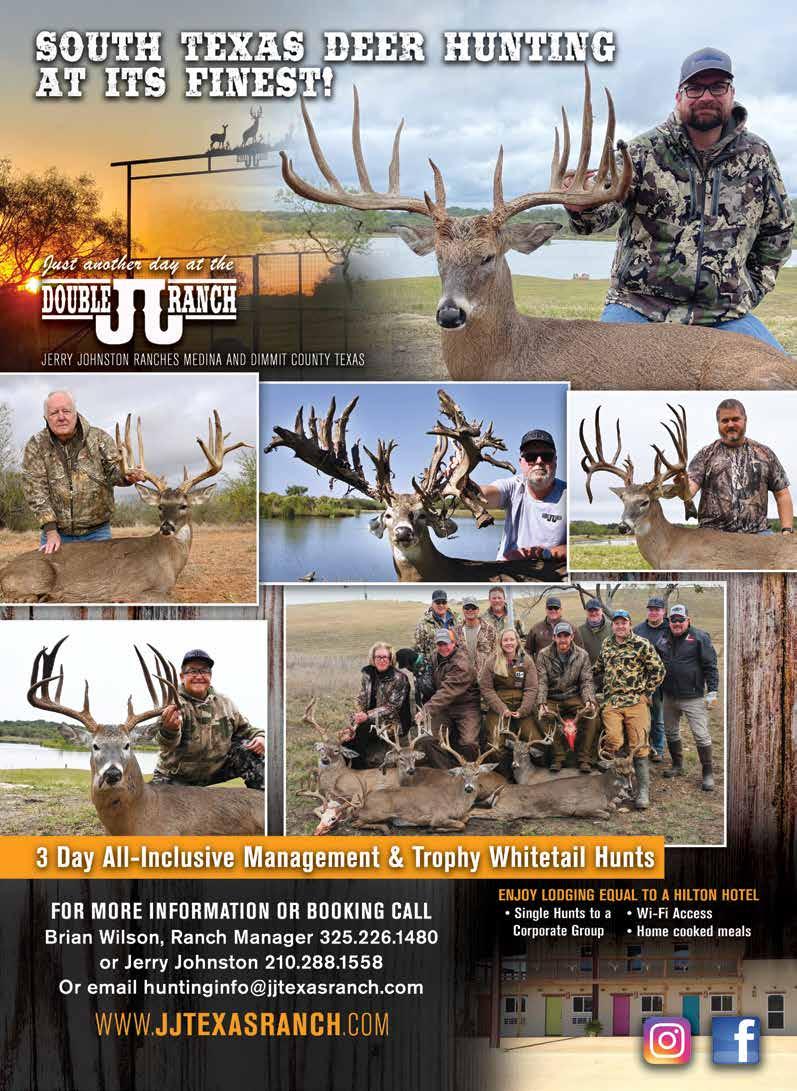
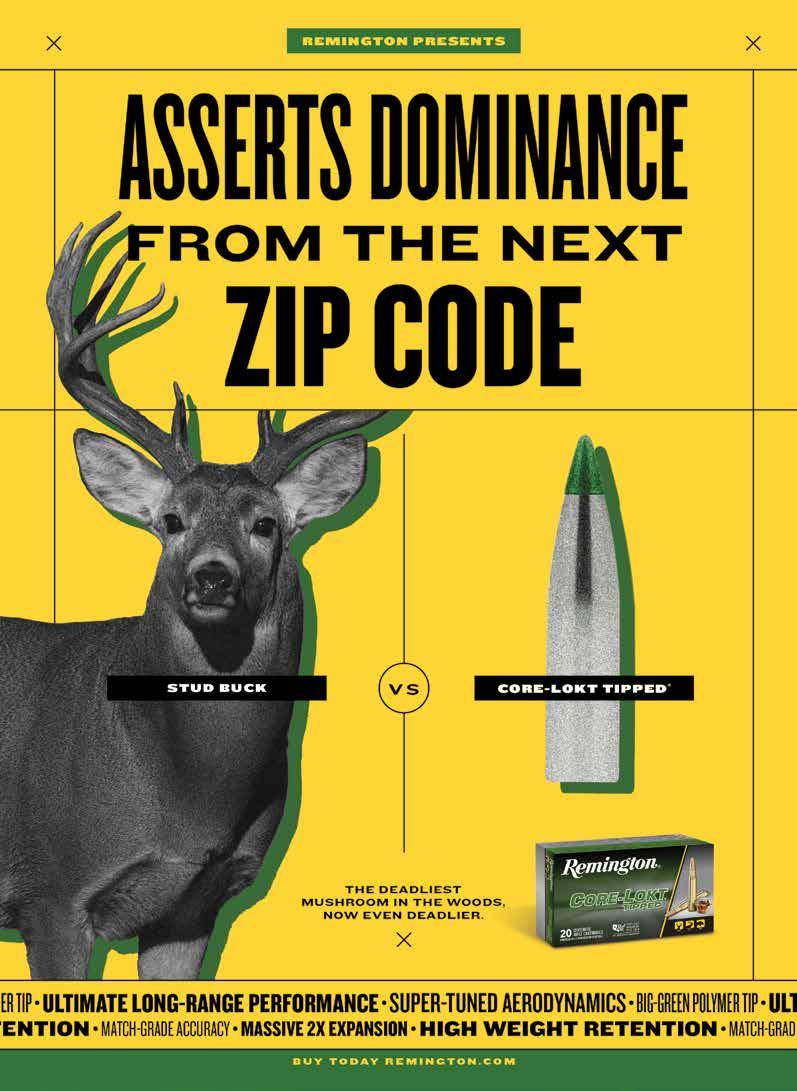
Only about 5% of Americans hunt, but 100% of us have ancestors who were hunters. Hunting is deeply and undeniably programed into our DNA. Even the vegan holding the anti-hunting protest sign is only there because her ancestors killed and ate animals for a couple million years. Our bodies are built to eat and process meat as evidenced by the way we store fat, the structure of our diges -
tive system, our tooth wear patterns, and chemical analyses of old bones. It’s clear we have been hunting and eating meat for a very long time.

Anthropologists have theorized we began to walk upright more than 4 million years ago so we could carry tools and
weapons. Also, the shift to a hunted protein diet fueled the development of our big brains, spurred on by the need to coordinate more elaborate, and sometimes abstract, hunt plans.
than female or young specimens. Researchers concluded the red deer, rhino, bison, and wild cattle skulls were placed in that section of the cave by Neanderthal hunters to display their hunting trophies. As I said, some of the things we like to do have deep genetic programming.
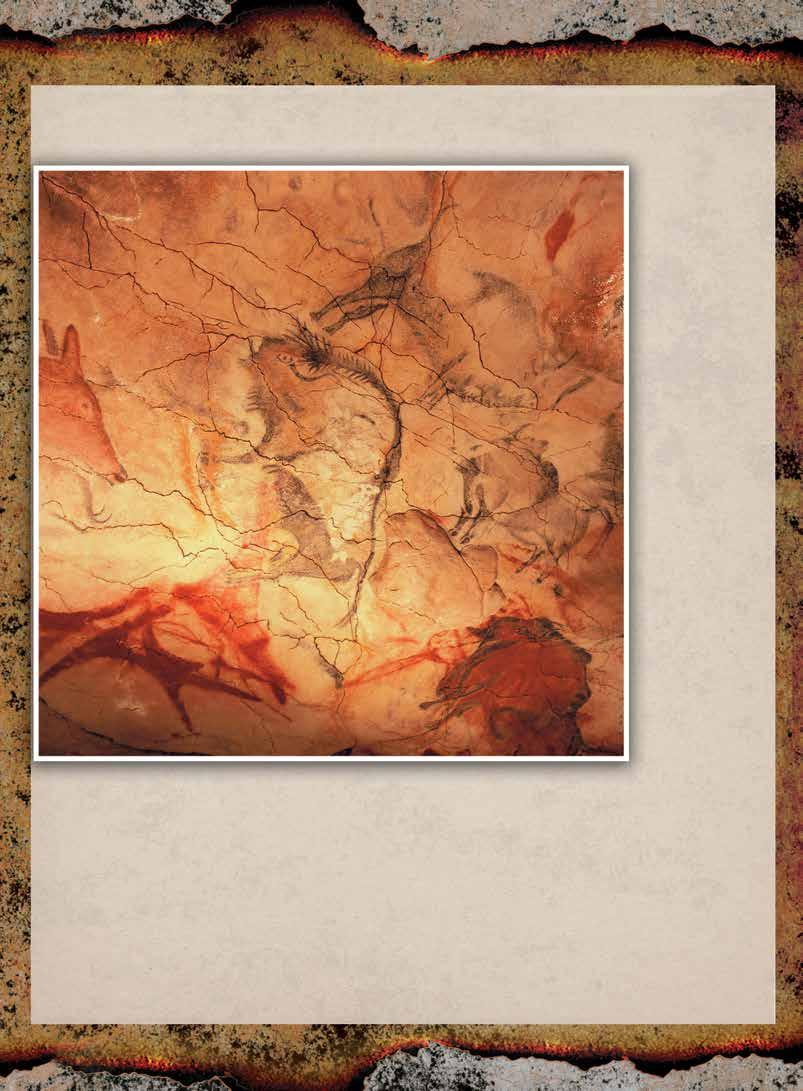
Sometime before 20,000 years ago, small bands of humans crossed the Bering land bridge in what is now Alaska and spread across the continent hunting and gathering their food supplies. These bands moved around to take advantage of seasonal food sources from the oceans or mountains or prairies. It’s hard to piece together details about them because they left very little evidence of their nomadic way of life. Archaeological evidence indicates these hunters had reached the Southwest and northern Mexico by 11,500 years ago.
Language became an important part of human development to tell hunting stories and orchestrate hunts effectively. Cave paintings depict hunting, not gathering, scenes. Hunting drove human evolution to make us who we are and why we have been so successful.
Certainly, early humans hunted for the meat, but we shouldn’t assume they were not admirers of beautiful, mature representatives of these species. Recently, a cave was discovered in Spain that contained an unusual assemblage of animal skulls without the jaws or any other bones from the animals’ bodies. This collection contained skulls that all belonged to individuals and species with large horns or antlers rather
The Clovis Culture, named after Clovis, New Mexico, left behind several big game kill sites that contain spear points and other tools such as scrapers and knives. Clovis definitely hunted some of the biggest game. Two sites in southern Arizona—Murry Springs and Lehner—had mammoth remains with several Clovis points embedded in their skeletons. There is evidence Clovis hunters were already using atlatls, a spear-throwing stick that helped them gain extra leverage for throwing their projectiles much harder and farther.
These early hunters roamed a landscape with the dire wolf, saber-toothed cat, horses, lions, camels, ground sloths, bison, and 100-pound beavers, all of which were native to North America before disappearing at the end of the Pleistocene. Deer were not as common and widespread at this time, but their remains have been found in association with Clovis artifacts. By 10,500 years ago, Clovis points disappear from
A bison depicted on the roof of Altamira Cave in Spain represents a prehistoric Facebook post of a hunt.the archaeological record.
Another hunting society, referred to as the Folsom complex, follows the Clovis culture in the eastern edge of the American Southwest. This culture is named after the Folsom, New Mexico, site that yielded the first distinctively fluted spear points that characterize this culture. The Folsom people were primarily hunters who seemed to concentrate on a now-extinct species of large bison (Bison antiquus). One archaeological site contained many bison skeletons with most missing the tail bones, indicating the hunters had skinned the animals and removed the tails with the hides. Around 4,000-5,000 years ago, this large form of bison evolved into the smaller bison (Bison bison) we know today. At that time, these formerly nomadic
to take advantage of what protein was available in their areas. It was sometimes more profitable to hunt closer to home for rabbits, armadillos, rodents, snakes, lizards, frogs, snails, and seafood. In most societies, men went hunting, while the women and children collected plants, cactus, acorns, mesquite beans, fruits and sometimes hunted small game. The Anasazi culture in the Southwest hunted, but also kept turkeys in a semi-domesticated state for eggs, meat, and feathers to make blankets and for decoration. Deer not only provided important protein and fat, but also raw materials for clothing, tools, jewelry, and ritual objects.
very long time.
Deer hunts were highly ritualized, with special observances beginning days before the hunt. Several different hunting styles have been described and they are all familiar to hunters today: still-hunts, ambushing, stalking, or driving deer. There were many rules and taboos regarding the handling and preparation of meat. For example, in some cultures, fresh deer meat from a mountain lion or wolf kill was considered a gift from the gods and eaten.
hunters began to focus their hunting on the smaller bison and medium-sized game. During this period, deer were beginning to assume a greater importance as a source of food and materials, a trend that continues to this day. From this time forward there appeared many different hunter-gatherer cultures occupying North America after the glaciers receded, until Europeans arrived.
Hunting was done primarily with the atlatl until about 3,000 years ago, when the bow and arrow came into common use. This improvement in weapons undoubtedly increased hunting effectiveness. Agriculture became more common and important, but diets were supplemented extensively with wild plants and animals. Some tribes focused on birds and small game
From the number of arrow and spear heads that have been found, there can be no doubt about the importance of hunting to all the diversified tribal nations spread across the continent. Many archaeological digs have yielded arrowheads embedded in deer bones, shoulder blades, and ribcages. Hunting parties would travel long distances for buffalo, turkey, deer, and elk. On longer trips, meat was dried before being transported home to help preserve it and reduce the packing weight. Some tribes are said to have made a practice of setting fire to the woods to attract animals to the newly burned areas.

These historic people hunted large dangerous game with true primitive weapons. One study of Neanderthal bones found their injuries were similar to the bone breaks suffered by rodeo bull riders. This makes sense when you consider these two groups of people were involved in similar activities around dangerous animals. We all come from a long line of brave hunters, but our hunting activities contribute to so much more now than simply protein for dinner. The future of conservation depends on making sure we are the ancestors to future hunters.

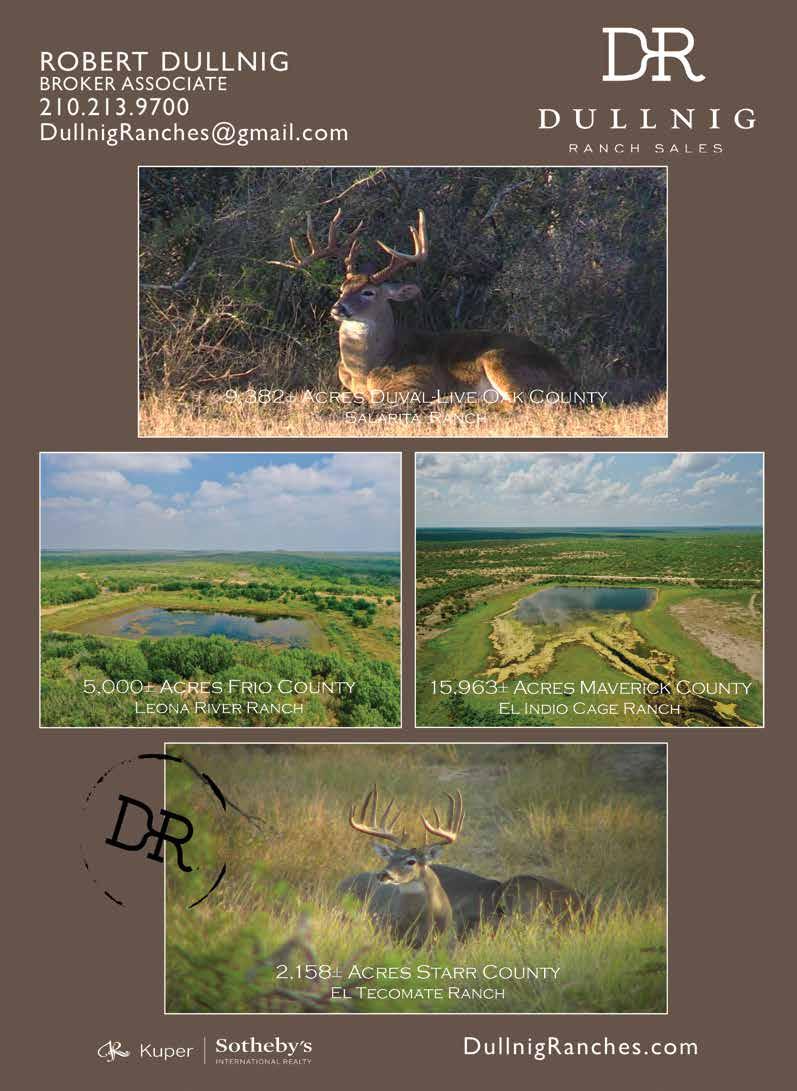

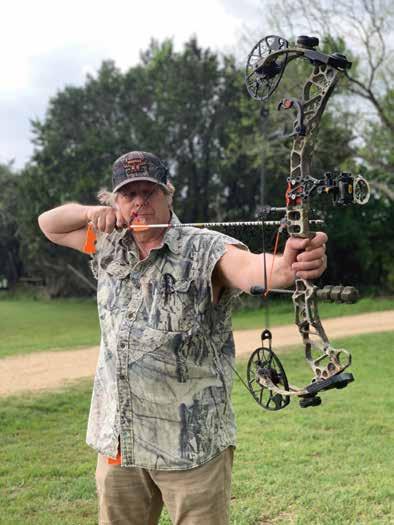

Is life an adventure, or what?
I can promise you the word boredom has never made its way into my adventurous life; you can be sure of that.
I see these poor, pathetic souls hopelessly locked into their handheld electronic zombie devices, and I can only feel sorry for them. Especially so many young people who have intentionally, or just mistakenly limited their view of the world, or worse, bypassed the possibilities that this incredible gift of life can provide.
I’m the first to admit the advantages of runaway technology when implemented intelligently and efficiently. Hell, I drive an 840 horsepower Dodge Challenger Hellcat SuperSport Widebody Redeye fire breathing fighter jet (based on the contents of the trunk) which happens to trounce the very best horsepower beasts of the so-called Muscle Car era of the 1960s and early ’70s.
And of course, I pound away like a madman on my state-of-the-art, pain-in-the-ass cellphone to keep in touch with family, friends, business associates and elected employees, the trick being knowing when to shut it down and escape the mayhem.
Which brings us to the point of this writing—the
healing powers of nature and the soul cleansing great outdoors lifestyle.
I have forever waxed poetic on the sanity safeguards of balancing one’s life’s pursuits between
Ted says he understands many outdoor enthusiasts focus on a few favorite activities. But he believes newcomers will stick with their new passions.
productivity and recreation, and in these crazy, treacherous, trying times in America and around the world, such prioritizing balance could not be more crucial.
The term recreation itself says it all: re-creating our energies, sanity and recharging our spiritual batteries.
Truly the joys of hunting, fishing, trapping, camping, boating and everything outdoors is by my evaluation, the ultimate re-creating powers available to mankind on planet Earth.
Nature certainly heals, but she heals most effectively when we actually participate as hands-on players, which of course is ultimately defined by hunting, fishing and trapping.
As we fight heroically to upright the good ship America, we will only be as effective as we are healthy, grounded, tuned in, and recharged.

I admit to being more gung-ho when it comes to bowhunting than any other outdoor activity, but I do indeed fish, trap, boat, birdwatch and dig my mitts deep into the throbbing heartbeat of the good earth as a farmer and rancher as often as possible.

Just the earthly act of planting food plots and trees each spring takes me far, far away from the increasing goofiness of the world, and as I wrap up each activity out there, I am genuinely rejuvenated and re-energized.
I love fishing for yummy panfish, shooting doves, waterfowl hunting,
small game hunting, big game hunting, turkey hunting, bowfishing, archery, rifles, handguns, shotguns, blowguns, slingshots, pretty much anything and everything out of doors.
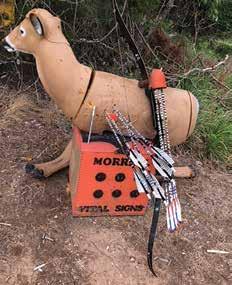
We all have our favorites, but never underestimate the thrills of breaking the mold and trying something new. I would wager that many outdoor enthusiasts focus on a few favorite activities, and in my experience, when seeking new adventure and challenge, nine times out of 10 the newcomers stick with it, and in many instances, discover an exciting new passion that brightens their outdoor life.
Think outside the box as summer winds down and the magic of fall and winter brings us a new day, a new season, a renewed spirit and a much-needed upgraded hope for life, liberty and the pursuit of our favorite happiness.
Talk to your buddies, wander in a sporting goods store, walk up and down some new aisles and go for something new and different. Do it all! You won’t be sorry.

In a misspent life wandering the globe, chasing animals and fish, if I have one regret, it’s waiting till middle-age to set foot in Alaska. Work first brought me to the Great Land 20 years ago, and it remains home today. While I spend much of each fall in Texas and other points south, Alaska is always going to be my happy hunting and fishing ground.
John Muir, father of America’s national parks and the first advocate for wild places from Yellowstone to Alaska, visited Alaska often in the 1870s and 1880s, and wrote eloquently of his experiences. “To the lover of pure wildness Alaska is one of the most wonderful countries in the world. ... it seems as if surely we must at length reach the very paradise of the poets, the abode of the blessed,” he wrote in “Travels in Alaska.”
Alaska of 150 years later remains this place of wildness. So, let’s talk about you make the most of your first trip. To begin, don’t sweat the logistics. Yes, it’s 3,216 miles from San Antonio to Anchorage, but from Anchorage, you can drive north to Denali and eventually the North Slope, or south to the Kenai and Homer. Or you can take a quick flight to Kodiak or Bristol Bay or a million other destinations.
Next, remember every minute in Alaska is its own reward. While a 60-inch bull moose or 10-foot brown bear is still very possible and a worthy goal, the rewards are simpler. Wading in a river choked with salmon, or feeling the immovable force of a halibut as big as a Buick, your first view of a winter sky aflame with the aurora borealis, or seeing your first bear on the mountain side, lit by the sun and long hair blowing in the wind.

So, let’s talk about your first trip. Coming to fish for a week in the summer is a great start.
A week or more is a good idea, because even on a good trip
you’ll have days that are weathered out, or the salmon run is late or slowed by commercial nets. Expect incredible days and days you can’t even fish.
You can go it alone, fish the rivers solo, book your own saltwater charters, camp, or stay in local hotels. Or choose a package trip from one of hundreds of lodges that provides everything.
I recommend three days river fishing for salmon. Timing will determine which species, with late June to August for red salmon, or August and September for silvers.
Sadly, the legendary king salmon runs have so declined in recent years. Most are closed or restricted to catch-and-release, even the Kenai. You can still catch and keep a king in the hatchery runs in downtown Anchorage’s Ship Creek and the Kasilof on the lower Kenai Peninsula.
In addition to salmon, you need to plan a couple days on the saltwater, pursuing silver salmon, halibut, and rockfish, and after July 1, lingcod. Expect to see humpback whales and orcas, sea lions and seals and certainly sea otters. Plus, unique birds from bald eagles to puffins, all while fishing in view of glaciers and around iceberg.
There’s also world-class flyfishing for rainbow trout and Dolly Varden, which grow to almost unbelievable proportion by gorging on salmon fry, salmon eggs, and salmon flesh. Given time to head north to experience Denali National Park, you’ll also find superb grayling fishing throughout Denali country. Almost every trickle of water holds this fabulous fly rod quarry and in more remote fisheries they can grow to 4 pounds.
But enough about fishing. Once you’ve set foot in Alaska, you’ll want to come back to hunt. You need to prepare to pay, either in license and guide fees, or in blood, sweat, tears, and money.
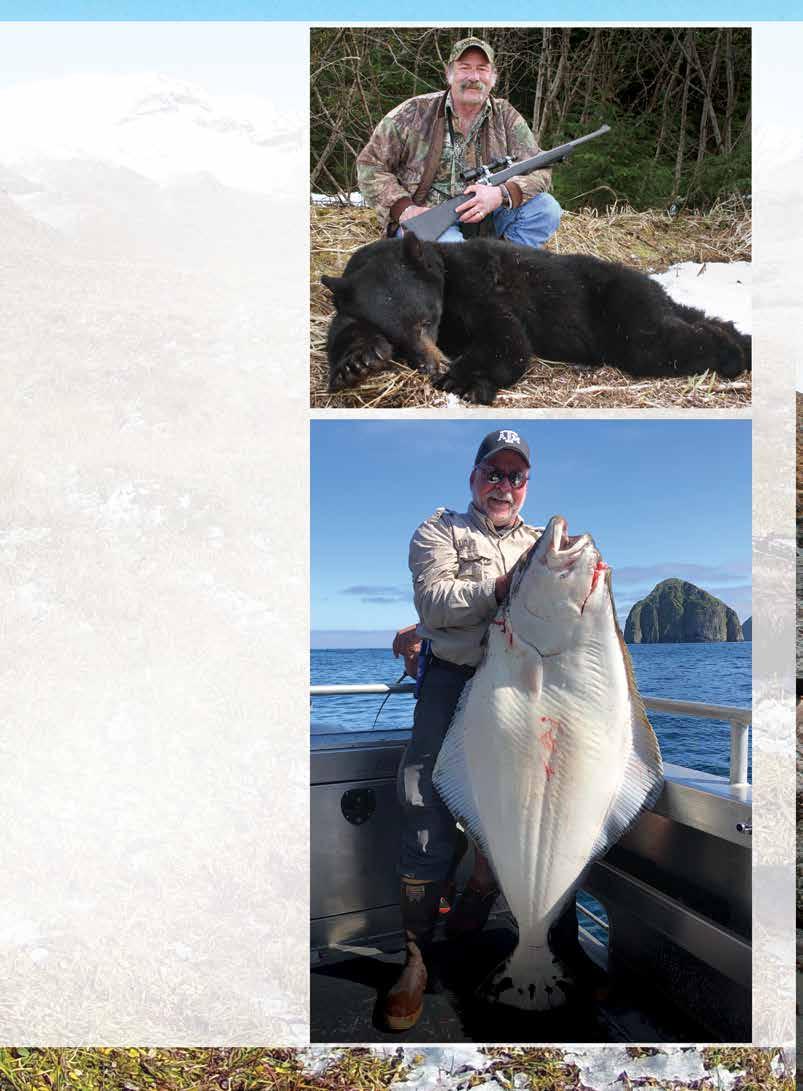
For sheep, goats, and brown bear, nonresidents are legally required to hire a licensed guide. But there are plenty of great do-it-yourself options too, including caribou, moose, and black bear. There are 100 million acres of public land in Alaska you can hunt for little more than the price of transportation to get there.
There are excellent transporters with access to good country, whether by boat or float plane or super cup, that deliver you to the country hill, adventure, or camp, and after you hopefully have a successful hunt, pack your gear and meat, and haul you back to civilization. It does require planning. Starting today, I recommend looking at plans for 2025 or 2026, because the good transporters book up early.
The trip I always recommend for first timers is hunting Kodiak Island with one of the many boat-based operators. For a week, you live on a
Larry Leschper with his first Alaska black bear, one of the species nonresidents can hunt without a guide.boat anchored in a remote cove, and run ashore by skiff each day to the island to spot-and-stalk the abundant and tasty blacktail deer. You can shoot three, while trying to avoid the largest brown bears on Earth.
Kodiak truly is a wildlife wonderland. After you’ve taken the limit on deer, you can hunt sea ducks, fish for halibut, and drop crab traps to catch Dungeness crab for dinner. A Kodiak trip like that costs less than an average Texas deer hunt today.
There’s another boat-based spring option, which is spring black bear hunting by boat in Prince William Sound out of Seward or Kachemak Bay from Homer. This is an April-May hunt for bears just out of hibernation with a big appetite. You base and sleep on the boat, cruise, and glass shorelines by day and when you see a suitable bear, go ashore, and make a stalk. There’s always time to fish midday as well when the bears aren’t active. A spring black bear hunt will cost you less than most exotic game hunts in Texas today.
There’s one other option I can’t close without mentioning. Every conservation organization in Alaska offers dozens of great hunts for auction and raffle fundraisers each year. Alaska Department of Fish and Game now also offers The Alaska Super Seven Big Game Raffle, with seven world-class hunts including

cash for travel or guide fees, with the $20 raffle fee going to Alaska conservation. Learn more at AlaskaSuper7Raffle.com. Somebody has to win, right?
Shopping for airfare will also require some homework. As I’m writing this, airfare remains at its post-pandemic peak, but with time and luck it’ll start to return to something more reasonable. We always recommend getting an airline credit card from one of the major airlines serving Alaska, whether it’s Alaska Airlines, Delta, United, and American, and using that card for a few months or a year to earn enough airline miles to make a trip from Texas to Anchorage.
Frankly, Alaskan airline miles are the true currency of Alaska, and you won’t find many Alaskans who don’t have one or more airline cards and a big bag of miles.
It’s fun to buy new gear for a trip to a new place like Alaska, but your Texas rifle, so long as it’s at least a .270 that you shoot well, will handle 95 percent of hunting in Alaska. As far as apparel, remember waterproof, waterproof, waterproof and layer, layer, layer. And cotton kills! Wet cotton blue jeans will give you hypothermia faster than a swim in Cook Inlet. Alaska is where cheap gear goes to die, so invest in good stuff.
You can find plenty of good reasons to not fish or hunt Alaska. Distance, cost, and those scary bears. But there’s one really good reason you have to go. It’ll change you forever. And you may just experience what John Muir did in southeast Alaska 150 years ago, when he cautioned as a senior citizen himself that a young man should not visit Alaska.
“Because once a man visits this place, he must choose first either to never leave, or second, accept that any place else he goes is going to be something less.”

So many of us look forward to our fall deer hunts, and each spring we fill our feeders with protein and whatever else we can feed to help our whitetails stay healthy. With all the exotics in Texas, we are very fortunate to hunt year-round if we so choose. Over the past 20-plus years, spring means turkey season, which means a lot to me and my crazy friends who like to chase these inconsistent, smart Rios of Texas. I had it said to me that if you’re a turkey hunter, you have to realize you will be unsuccessful more times than you will be successful. There are so many variables to contend with. Spring in Texas can be demanding for hunters, as we get high winds, hot days, cold days, and even sometimes a few rainy days. You are also dealing with turkeys that move from property to property looking for feed and water sources.
In the spring these same turkeys are also looking for romance. Most years we have green grass, blooming trees, and flowers of all kinds popping up on the Texas landscape. Where turkeys spend their winter can be entirely different than where they spend their spring.
One of my favorite things to do is take kids on their first turkey hunt. Our Rio Grande turkeys are typically aggressive birds, and when the time is right, it can be an adrenaline riddled exciting time for anyone new to calling in animals. Their defense mechanisms are

According to the author, if you’re a turkey hunter, you have to realize you’ll be unsuccessful more times than you’ll be successful. That’s why success feels so much sweeter.

their eyes and ears, so gearing up with head-to-toe camo and remaining motionless is an absolute must. That is why turkeys are so hard to get on the ground because they literally have eyes in the back their heads. A lot of times we use pop-up blinds for our first-time turkey hunters to help conceal their movement. It also allows us to sit longer with the kids and more time in the field also lends itself to higher success rates. The Rio Grande turkeys of Texas are beautiful birds and when they go into full strut, they are a site to behold.
Agrilife Extension Wildlife and Fisheries says this about turkeys:
“The bodies of wild turkeys are covered with 5,000 to 6,000 feathers. These feathers provide insulation, lift during flight, and touch sensation and ornamentation. A wild turkey undergoes five molts (feather replacement) during its lifetime: natal, juvenile, first basic, alternate (first winter), and basic (adult plumage). The body feathers of toms are vibrantly colored: iridescent copper, bronze, red, green, and gold.
“While hens have these same colors, they are significantly dulled and muted which causes the female to appear brown. Gobblers have a beard, which is a cluster of long follicles in the center of their chest that can be an inch to 10 inches long. Unlike the rest of the body feathers which undergo five molts throughout a turkeys lifetime, the beard does not molt. It becomes visible when the turkey is 6-7 months of age, and it continues to grow throughout their lifetime.
“Hens may occasionally have beards, although this uncommon event produces much shorter beards than toms.

Both toms and hens have sparsely feathered heads with bare legs and feet that are pink to red in color. Toms grow a spur on the lower third of their leg that starts off small and rounded, but which becomes pointed and about 2 inches long with time.
“Hens also have a spur, although their spurs stay small and blunted. Gobblers weigh 17-21 pounds and attain a height of 40 inches. Hens weigh 8-11 pounds and are 30 inches tall. Poults are relatively small when hatched; they only weigh 2 ounces.”
Over the past few weeks, we have had a lot of success with our first-time turkey hunters. One young man called in his first bird all by himself. Jase Wykoff is starting at a very young age and has already found success with his dad by his side. Adam was watching his son call in the bird and from what I was told it was all he could do not to shoot this trophy gobbler himself.
Hadley got it done on opening day in Missouri. Luck was on her side for sure, as they had wind gusts up to 35 mph in the morning and somehow managed to locate a bird at daybreak. Scrambling unprepared they managed to get masks on, gun loaded, and set up the best they could. After a sequence of calls the bird had covered 40 yards in a matter of minutes. Dad quickly took the safety off and told Hadley to take the best shot possible and the rest is now history. Hadley had taken her first Eastern turkey.
I know from years of hunting with Noah Ledyard he was ready to take his first bird. The turkeys of Mountain Home, Texas, had been eluding him for the past few years. His diligence and hard work finally paid off when
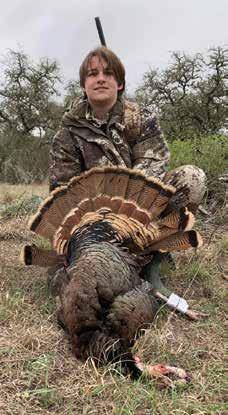

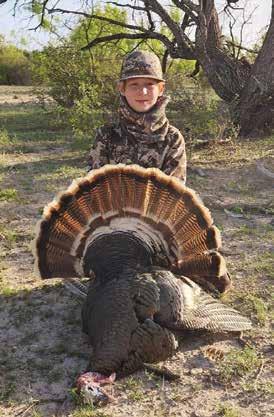
he was able to get that weight off his back. He is such a nice and deserving young man and congratulations are in order.

Elana Herceg made a trip to Texas for the North Zone opener on April 1 near Del Rio, Texas. It took a day or two to figure out the Texas birds for this father-daughter duo from Pennsylvania, but once they did, Elana was not only able to take one, but she took two birds on her trip. That will make a lasting memory for Jim and Elena.

Jaxon Fondren was all smiles with his super fat gobbler from Whitsett, Texas. This was his first bird, and he made a great shot and from the looks of his photos the bird was as tall as he is. I know that his father Brian could not have been prouder of his son.
We are super proud of all these young people as they continue to amaze us with their outdoor exploits. Getting outside with your kids is extremely rewarding and with all the craziness of the world today, I can think of no better way to enjoy the children in your life. I thank the good Lord every day for the opportunities that have been given to me and living the great life in God’s great outdoors.
Michael Marbach is CEO of the Christian Outdoor Alliance, www.mycoa.org; 210-827-9802. COA’s mission is to guide youth and outdoorsmen to a relationship with Jesus Christ through experience in God’s great outdoors.

 By Will Leschper
By Will Leschper
Baffin Bay is unlike any ecosystem in Texas.

The hypersaline bay in what once was considered the Wild Horse Desert on maps is famous for its “rocks” –ancient living structures constructed over thousands of years by tiny tube-building serpulid worms. The bay system also is notable for the prime target of saltwater anglers: huge, speckled trout, aka “gator” trout. However, in recent years, the watershed has brought about concerns from communities and researchers regarding the water quality of the bay, notably from negative manmade interaction with the native habitat in the form of runoff pollution.
Led by Dr. Michael Wetz, Harte Research Institute Chair for Coastal Ecosystem Processes, Bringing Baffin Back is focused on a multi-tiered approach tied to the historically excellent speckled trout fishery. Wetz said researchers have worked for the past 10 years to understand the environmental and socioeconomic drivers of water quality change and assess the health of critical habitat and fish species in the bay. Through that re-
search, they have determined the primary cause of the decline in Baffin’s health is excessive nutrient pollution from the bay’s 1.5-million-acre watershed.
“Over the last three to four decades, Baffin has experienced a significant decline in water quality and in its overall ecosystem health,” Wetz said. “In previous years, we started getting calls from concerned community members about things they were seeing in the bay that were pretty abnormal. They were seeing things like persistent brown tide, algal blooms, fish kills and seagrass die-offs.
“They also noted a weird phenomenon with black drum that were being caught and roughly about three-quarters of them basically had no muscle in them and were essentially starving. After meeting with community members and taking in all this anecdotal evidence, it convinced us we need to do more research and testing on what pointed to a decline in water quality.”
Wetz noted that despite the proximity and notoriety of Baf-
fin, there wasn’t any real data that could be tied into what was being observed. That led to a concerted effort to involve local guides, anglers and others whose livelihoods are tied to the fishery.

“In the beginning, we recruited 18 community members to work as citizen scientists, taking our researchers out every month and helping them to get the hard data that could be used to determine what really was going on down there,” Wetz said. “After years of doing that, we started to be able to intensively study what was happening. We realized that the main issue with the water quality was tied to what’s called nutrient pollution, which boils down to having too much nitrogen and phosphorus going into the bay.
“We found that, in turn, those pollutants can do things such as triggering algal blooms that are not good for the ecosystem as a whole and can cause low oxygen levels in the water that can make it really hard to support a healthy and thriving fishery.”
Wetz said the main driving force with pollutants getting into Baffin Bay continues to be human in nature, though prolonged drought can also have a negative impact on the already highly saline bay system.

“What we have seen is there has basically been a large signa-
Left: Speckled trout continue to be the prime angling target along the Texas coast for most anglers. After the historic freeze in February 2021, much of the coast underwent regulation changes that lowered the daily bag limit to three fish between 17 and 23 inches, with no oversize trout allowed to be kept.
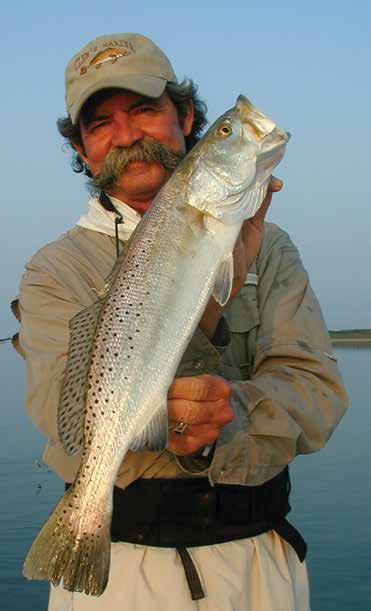
ture of sewage in the water we’ve tested over the years in Baffin,” Wetz said. “What we’ve come to realize is that we’ve got a lot of issues with failing wastewater treatment plants down there. Also, there are issues with septic tanks and stormwater runoff coming from the cities around the watershed that have continued to contribute to more pollutants being distributed into the water column.
“Those pollutants can help drive loss of habitat like seagrass beds and other native areas and there also are erosion issues that seem to be adding sedimentation to the bay and that also changes your bottom habitat in negative ways. There are a lot of things going on both manmade and naturally occurring that definitely have impacted the entire bay system negatively. I do think that Baffin in many ways is kind of like the canary in the coal mine for the rest of the Texas coast in terms of human encroachment and future impacts that are occurring in our bays.”
Wetz said the local community in and around Baffin Bay was vital to helping get the initiative up and running, providing a resource that researchers could rely on. In the years since, the coalition has grown exponentially to include scientists, citizen groups, landowners, philanthropies, policymakers, local municipalities, state officials, non-governmental organizations and private businesses.
“We started off with about 10 people in a room when it began and now we’ve got about 250 people from different agencies and organizations, and walks of life,” Wetz said. “This effort pulls a lot of people together with different backgrounds that are all important and helps lay out a good strategy for dealing with these issues facing Baffin. This has already been a 10-year effort but we’re viewing this as another 20-year project that will ultimately take future generations to help come to fruition.”
More Information:
www.harteresearch.org/collaboration/bringing-baffin-back
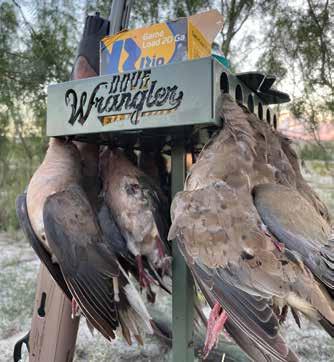




Looking for a way to Show Your Skull? Then make sure you head over to the Hunters Extravaganza shows and visit the TTHA Merchandise Booth to pick up the latest TTHA Gear. Don’t forget we offer members a discount on TTHA gear. Not a member? Join now. See details on page 44.

Introducing the Dove Wrangler—handcrafted in Texas with 100% American made parts. It comes ready to use, so no set-up is required. From holding your favorite beverage to keeping your birds high and dry, it combines functionality and convenience in a compact, sturdy structure. It’s designed to hold your daily bag limits, shells and cell phone, while also providing a dedicated space to lean your firearm. Visit 8gaugeoutdoors.com.
Knives of Alaska’s “Alpha Wolf” combination fielddressing kit contains the popular and time proven Alpha Wolf and Cub Bear knives housed in a beautiful oil finished leather sheath. Both knives are made with D2 tool steel with a HrC of 59—61 resulting in superior edge holding ability. Available in black, or elk stag handles. Made in USA. Lifetime warranty. Visit knivesofalaska.com.
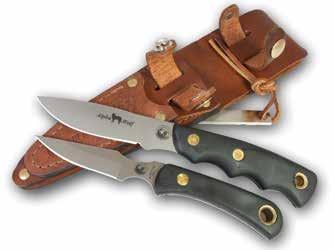
ForEverlast introduces the most practical knife kit for the outdoorsmen or women in your life: a large carving knife, filet knife, and gut hook/caping knife. The kit comes with a cutting board, sharpener, and perfectly constructed case for keeping it all organized. The ergonomic handles along with the forged stainless-steel blades combine for a durable and long-lasting set of knives that can hold an edge for all your cutting needs.

Visit foreverlast.com.
Looking for custom buckles, awards, or a way to display your ranch? Then RB Buckles has what you’re looking for. For years RB Buckles has provided buckles for the champion cowboys and cowgirls, musicians, ranches, business, personal, 4-H, playdays, awards for all events, and more. Stop by the Fort Worth or San Antonio Hunters Extravaganza and visit the RB Buckles booth to see what they can do for you.

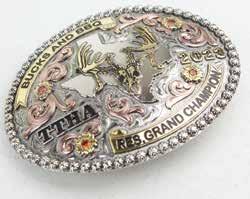
Visit rbcustombuckles.com.


Chas-Mac’s new 5'x7' O.M.D. camo blind comes with 22 gauge galvanized pre-coat O.M.D. camouflage exterior, double wall metal with insulation, marine grade carpet interior, welded steel base with tower and porch sockets, and leak resistant, rodent-proof door and windows. It also comes with exterior window and door rain guards, fully framed, hinged flip-up magnetic windows, composite flooring on top of metal exterior floor liner, carpet lined shooting shelves under each window, one piece pitched roof with gutter, 24" x 70" lockable door, and 81" interior roof height.
Visit chas-mac.com.

SEE THESE PRODUCTS AND VENDORS AT THE 2023 HUNTERS EXTRAVAGANZA® SHOWS.
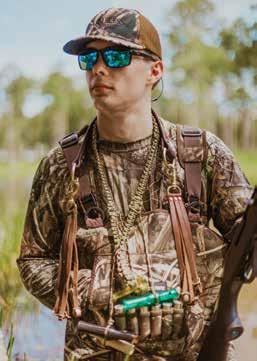


Hand made in America with the finest of materials, with a lifetime warranty, the Guide II Waterfowl Carrier/ Tote is constructed from 1.5-inch stitched English bridal leather strap with solid brass D-rings. Twelve, six on each side, detachable leather drops are made with solid brass detachable snap rings and solid brass cinch rings. Depending on the size of the bird, each drop will hold from two to five birds. This will easily carry all the ducks and geese you can pick up physically.
Visit chamblessgametotes.com.
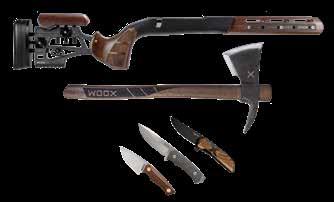
For years, WOOX has quietly crafted and designed the world’s best performing outdoor gear. By doing so, they created a global adjective crisis. Currently, there is no descriptor in any language that captures the timeless fit and finish of their gear. Until there is, WOOX will just have to do.
See their latest creations at WOOXstore.com.
DiamondBlade Knives’ patented “friction forged” award winning blades have proven to have the toughest, sharpest, and longest lasting “shaving sharp” edges as compared to any other knife steel. Winner of Field and Stream’s “Best of the Best” five different years, these knives are truly the best blades money can buy. Products include fixed blade hunters, EDC folders and automatics. Made in USA. Lifetime warranty. Visit diamondbladeknives.com.
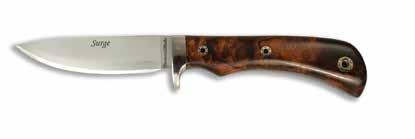
South Texas Slings introduces a handmade leather gun rack for your truck or SUV. Fully adjustable with dual mounting options. Get your firearms off of your seats at the hunting lease or ranch, while keeping them secure and accessible at all times. Proudly made in Texas.
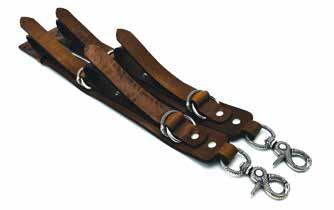
Visit stslings.com.
The Cobb Grill is an innovative and flexible cooking system that enables you to grill, bake, roast, and smoke foods with ease. Its distinctive construction features a stainless-steel mesh base, which promotes efficient and uniform heat distribution. The insulated outer shell traps heat while keeping the exterior cool to the touch. This allows you to cook virtually anywhere, from a plastic tabletop to an ATV or boat, making it an ideal grill for outdoor enthusiasts. The grill’s efficient fuel consumption means you can cook for extended periods with only a small amount of charcoal.

Visit cobbgrillamerica.com.
The Adder thermal imaging scope can be mounted to a weapon using any standard 30mm scope rings, but includes ADM QD mount with purchase. This scope is equipped with an internal rechargeable battery system and secondary battery system with one CR123A replaceable lithium battery. It provides 15 hours of continuous operation. The scope has on-board video recording with audio and onboard wi-fi video streaming via mobile application. It comes in 384×288 or 640×512 resolutions with 12-micron sensors.

Visit feraltexasoutdoors.com.



Clinton had a rough go during his hunt. He endured malfunctioning broadheads, accidental noise from a slipped shoe hitting the blind’s wall, and the top of his bow hitting the window frame when he shot.


Back in the 1940s, my great grandpa moved down from Iowa and purchased 200 acres in Parker County, Texas. He ran a dairy farm, among other things, and never had a lot of time for hunting. My dad grew up hunting and fishing there until I was in elementary school but was told to stop because of unwanted urban encroachment on three sides of the property. We were allowed to dove hunt and fish but no deer hunting, until last year.

My grandma and uncle, now the property owners, agreed to let us deer hunt as long as it was archery only. I’ve been hunting 21 years now on deer leases in Stephenville, Comanche, and now Archer County, but never had the chance to deer hunt on our own property. To say I was excited is an understatement. We promptly put out a feeder, pop-up blind, and a trail camera.
My dad, twin brother and I hunted hard in the 2021 season with no luck. We had pictures of nice deer, and my brother missed a nice eight-point, but the season ended with no deer taken. We decided to get serious for the 2022 season, so my dad purchased a Phantom blind and had a custom tower built. We fed corn all year long and had two very nice bucks and numerous does on camera.
I was excited and called dibs for the first Saturday in October. As the sun came up opening morning, it revealed six does and nothing else. I went home a little disappointed but still highly optimistic about the season. I hunted at my deer lease in Archer County, but wasn’t able to get back to the family property until the morning of Dec. 4.
My alarm went off at 4:30 a.m. and I walked outside to see heavy lightning and thunderstorms. I walked in to my 11-yearold son Carson’s room and informed him about the weather. I asked what he wanted to do. Without hesitation he said, “If you want to go, I’m with you.” I told him to get dressed and meet me at the truck. We had rain and lightning during the 30-minute drive to the old dairy barn where we parked, but thankfully the storm moved out as we walked through the mud to the stand.
The clouds covered the sun, so it took what seemed like forever for shooting light to reveal absolutely nothing. It was almost 70 degrees, with absolutely no wind and so humid, water dripped into the stand from the windows. Eight o’clock rolled around when Carson looked over and informed me how incredibly bored he was, and honestly, I was, too. I told him we’d wait until 9 and if we didn’t see anything, we would get breakfast.
I looked over at my mechanical broadhead to see the rubber ring broke and one of the blades dangling. I looked down into
my quiver and grabbed my fixed blade that I keep for pigs and varmints, and nocked that arrow onto my bow. Around 8:20 a.m. as I looked out the window to the left, I heard Carson say “Dad, there’s one!” I looked out the window to my right and out of nowhere a heavy, dark-antlered eight-point sprinted out of
the brush towards the feeder. I told Carson, “I’m gonna shoot him if he gives me a chance, so watch where the arrow hits, if and how he jumps and kicks, and which way he runs.”
The buck followed the script and ran to the feeder, stopping directly beneath it perfectly broadside. At this point we both had buck fever so severely, the windows in the blind shook! I was in the process of drawing my bow back when my mudcovered shoe slipped forward under me and hit the wall with a loud bang. That buck looked directly into the blind and jumped backwards, but miraculously, he only took a few steps then once again turned perfectly broadside behind the feeder at 28 yards.
I said, “OK, buddy; watch him.” As I released my arrow I heard another loud thump. The top of my bow hit the window frame when I shot! I looked at the deer and saw my arrow lay-
ing on the ground right behind him. No entry wound, no blood—nothing. He just stood there staring into the blind.
I asked Carson, “What happened?” He said, “Dad, you missed!” How could this get any worse? I’d made just about every mistake you can make. The buck stood there for a few more seconds then turned around and started walking towards the brush.
I told Carson to watch him as I reached for another arrow. I looked down into my quiver to see the mechanical broadhead on my next arrow had a broken ring as well. All three of my mechanical broadheads had broken rings with blades dangling, and I just missed with the only arrow I could use!
As I looked at my arrows and contemplated my choices that brought me to this point in my life, the buck had slowly walked to the edge of the brush and was just looking around, flicking his tail like nothing had happened. Suddenly I heard Carson say, “Dad look!” I looked up and saw the bucks legs start to wobble. As he tried to regain balance, he lifted up on his hind legs, flipped over backwards and collapsed into the grass. He fell in clear sight, 22 yards from where I shot him.
Carson stared hugging me and screamed with excitement. He wanted to immediately get down and go look at the buck. I told him I had no idea what happened, so we’d give it some time. We started making phone calls to several family members and friends, informing them of what had just taken place.
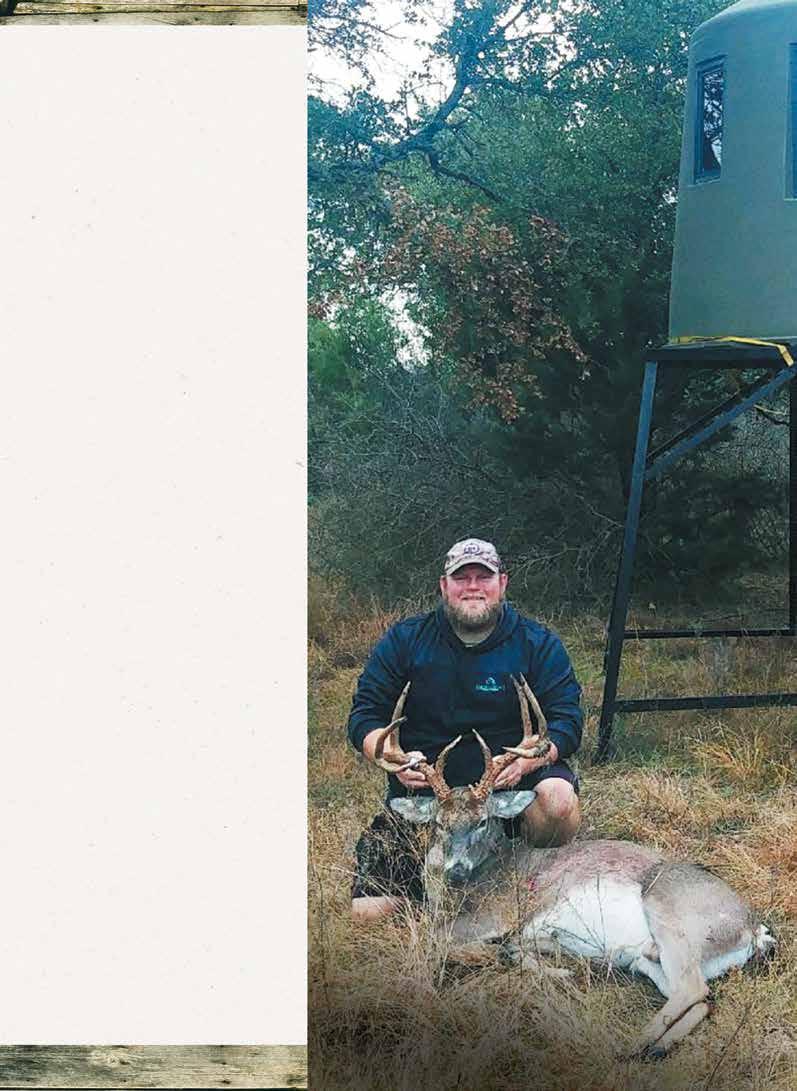
Twenty excruciating minutes later, we got out of the stand and walked up to my buck. I had made a perfect shot right behind the shoulder, but the arrow hit the opposite shoulder blade and deflected upwards upon exiting, hence the lack of blood. I had hit the heart and pierced the lungs. How that deer was able to stand there and act fine is beyond me.
A few minutes later, my dad showed up with the hanger to help out. We took pictures and got the buck loaded into the bed of the truck. On the way to the processor, Carson already informed me this was his favorite hunt he has ever been on, and he wants the shoulder mount to go in his room. He also wants to try and get a doe.
My dad shot a main frame 10-point with a brow tine that split into the separate tines from that same stand two weeks later. My brother somehow missed three different times and got an arrow stuck through a branch, but we don’t talk about that. All in all, this was a great fall with lots of memories made, and next season can’t come quick enough.


“BIG BUCK! Come look!” I hollered to my husband, John. Our four-legged kid, Zuke, came running, too. We were packed and ready to leave at 8 a.m. for a family gathering five hours away.
As I passed by a bedroom window, something caught my eye. Antlers! Tall antlers! Grabbing binoculars, I was astonished to see a good buck previously captured on nocturnal game camera photos.
“Wow! I bet that G2 is 12 inches! Nice 10-pointer!” John said. The buck meandered around the feeder 50 yards from our back door, sniffing the air, looking at does feeding in the nearby food plot and under another feeder farther back from the house.
Watching deer from the bedroom window had turned into a morning ritual. Once the shades were opened, even Zuke would gaze at what was in the pasture. Two feeders, two water tanks, and a green food plot enticed Mills County whitetails to dine on our place just north of the Colorado River.
We have two comfortable deer stands but it was much easier—lazier—staying inside the house. I know, that’s not true hunting but there’s a lot to be said about hunting in your pajamas and house shoes, holding a cup of coffee. Mornings always had the most deer, with evenings dependent on nearby activity.
I’d put a spike in the freezer on opening morning of the season, which allowed time to study what else to take later. We usually try to get two deer to feed us well until the next
season, which leaves some good young bucks.
“We’re not in a hurry to leave,” John said, adding, “That’s a good buck. I’ll take him if you don’t want him.” Once an avid hunter, now it’s only something like this that grabs his attention. I told him to get his rifle. We could take the buck and be on our trip by noon.
Living in a barn-dominium, you walk out of the house and right into the barn. John grabbed his rifle and slowly opened the barn’s back walk-through door just enough to ease his body around to shoulder his gun. The buck had begun walking towards another feeder about 150 yards away.
Suddenly something spooked all the deer.
With their white “flags” flying, they headed full speed into the brush. John closed the door and remarked, “He’ll be back.” We waited nearly an hour, but only a few does and yearlings returned. “Let’s hope he sticks around here for a couple more days,” John said, adding, “Time to hit the road.”
Arriving home from our trip, we both began hunting steady for this buck by sitting in our stands every morning. The rut was on, and several other bucks were around—a few we’d never seen before. But the 10-pointer was nowhere to be found.
After much discussion and going through game camera photos, I discovered we had seen this buck the year before, but only at night. A neighbor captured photos, too, but had never seen the buck in daylight hours. The buck had survived and was hanging out in the brush near our house.

Two weeks later, John was taking steaks off the grill when I picked up my binoculars for a quick look out the bedroom window. It was almost dark, and there he was–the big 10-pointer. Light faded fast, and it would be too dark to shoot by the time I got my rifle. Besides, I knew I couldn’t see the crosshairs as dusk closed and we didn’t want to clean the buck after dark.
Once more, assuming he’d be there in the morning proved wrong. The following morning, I had an early morning appointment, so I didn’t hunt, but John kept his rifle ready. After full daylight. the big buck came out. Quickly putting the crosshairs in the center of its swollen neck, John thought about how much meat he’d damage. Yes, we think about that!
Before John moved the crosshairs behind the buck’s ear, the buck turned and walked into the brush. Several deer were still feeding, but to John’s chagrin, Mr. Big never reappeared.
At this time, John declared there would be no discussion. He wanted me to kill the buck. “It’s a great buck for our area, low fence, and I want you to take him,” John said, wrapping his arm


around my shoulders.
For several days the buck never appeared. One evening we visited with the neighbors, and they showed us a shed antler they had picked up. Seeing the big antler, John exclaimed, “That’s the 10 Judy’s after!” The G2 on the five-point shed measured 11 inches.
Pumped with excitement after seeing the shed antler, I sat in the stand the next morning, well before daylight. On that December 2 morning, the big 10 stood under the far feeder. Two other bucks were present, but all kept wide berths from one another.
The big 10 began walking towards the does grazing on turnips, radishes, oats and wheat. I was ready, and had positioned my rifle as soon as I realized it was him. Stopping to sniff the air, the big 10 offered a good shot. My .223 was on the mark, and the buck fell in a heap. As I opened the pasture gate, Zuke raced by me to be the first to check out my buck.
As we walked up to it, John remarked, “That G2 must be 13 inches long –Wow!” He was close. It measured 127⁄8 inches. The antlers scored 130 4⁄8 B&C and the jaw teeth showed 6½ years. However, the taxidermist believed it was older.
Not bad for a Mills County low fence whitetail and even better for a backyard bedroom window buck. I’m proud of my 10-point.
Gary went out coyote calling, but managed to attract the attention of a female cougar during daylight hours instead.
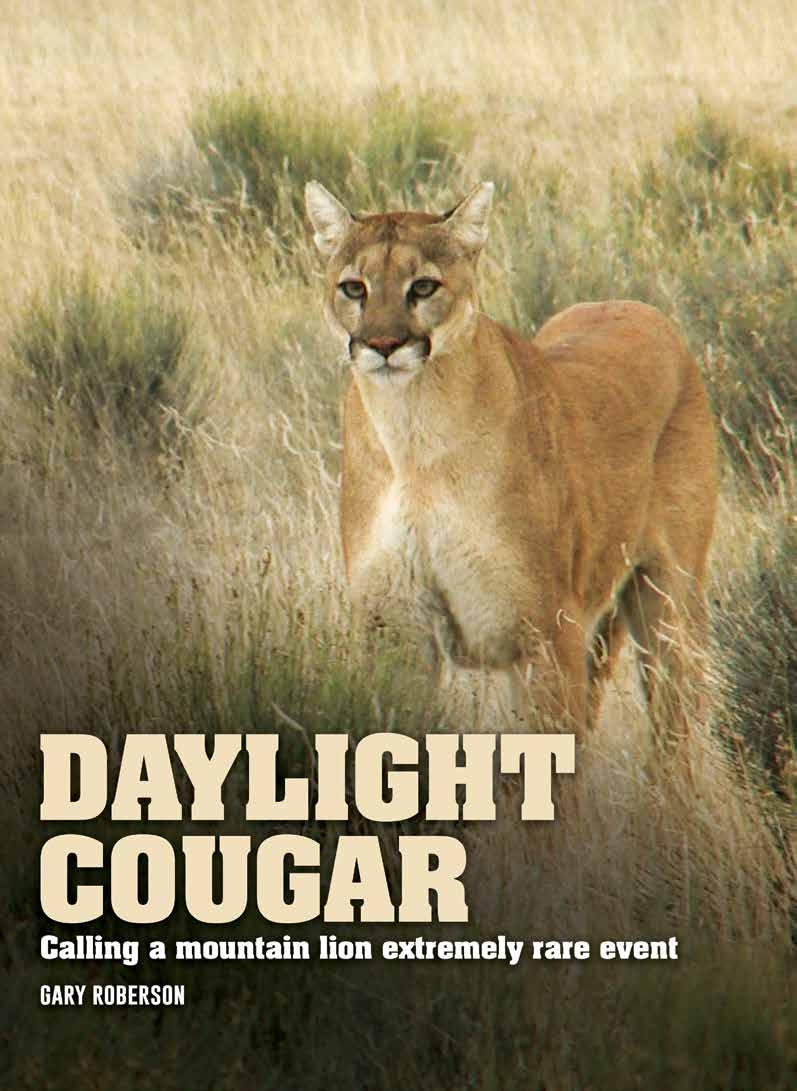
Iwas scheduled to speak at the Navajo Nation Sportsman’s Expo on March 24, so Steve and I decided to leave a few days early and hunt in western New Mexico where we had called quite a few coyotes in the past. We arrived about sundown on Monday evening and the forecast called for a slight chance of rain after midnight, and we got about an inch. The next morning, we found the ranch roads so treacherous, we could not leave the headquarters.
The second morning, we found the ranch roads navigable, and the forecast was for wind later in the day. We made the first stand a couple of miles to the west and called a big male coyote that almost ran over the FREQ electronic caller. Steve was able to video his arrival, but I did not see the coyote because he was behind a juniper. He came into view right at the caller shortly after clearing the dense bush. Two strides later, he picked up my stink on the call and headed away at high speed. I finally got him turned by switching sounds to a “hurt pup” but was unable to connect.
We made one more call before the wind gusted over 30 miles per hour and shut down our calling efforts for the day. Later that afternoon, there were reports of gusts to 55 mph, impossible for us to attempt to call but it also keeps the predators down. We considered the inability of the predators to hunt in the high winds might make them more receptive when the
winds did subside.
The third morning found the roads passable, and the winds calm. A light snow was falling but not enough to hinder our calling efforts. The first call was across a huge meadow but after 20 minutes of searching, I never saw a coyote. Steve and I moved west to an area where I had called coyotes in the past.
We hid my pickup in dense juniper and walked about 300 yards to the edge of where the sage turns to short yellow grass. There were low hills about a half mile to the northwest and two low hills with dense juniper to the south. The wind was westerly, 5 to 10 miles per hour and a light snow was falling. Visibility was excellent, and there was a fair amount of coyote sign.
No coyote showed after 18 minutes of calling, so I slowly turned my head to the left to make eye contact with Steve sitting against a juniper about 10 steps away. Just before making eye contact, I caught a glimpse of something brown trotting through the low sage beyond Steve—a mountain lion. I turned slightly in order to get Steve’s attention and pointed to the lion. She had just cleared a bush, making her visible.
From the time the female cougar appeared, she was in a long trot and in a matter of seconds, she stepped just to the left of the caller that had been silent for the last two minutes. I let her trot from the sage into the yellow grass as I wanted to make

sure Steve had the camera on her before I turned the caller back on.
I knew Steve would have the lion in frame and focused, so I kicked the call back on, causing her to swap ends. She hesitated for just a second and began trotting back to the noise she had just passed. I lowered the volume as she approached in an attempt not to spook the big predator with excessive volume.
The old lion trotted back to within 10 feet of the caller and half-sneaked the remaining distance until she had her nose stuck in the speakers. She walked around the caller, sniffing and trying to figure how to extract breakfast from the camo box. At one time, she appeared to want to roll on the camouflaged caller as a dog rolls on something that smells disgusting, but then she swatted it over.
When the caller tipped over, she retreated a couple of steps, but then went right back. In all, Steve was able to capture 2 minutes and 15 seconds of excellent footage of the big female lion before she retreated near the same patch of juniper where she came from. In all, I was in sight of her for over 4 minutes and she was never beyond 40 yards. Unfortunately, a juniper kept Steve from being able to see her as long as I did.
When the mountain lion first appeared, my thought was, “Here’s a lion in my lap and I don’t have a hunting tag.” After a few seconds, I realized what a rare opportunity to see a mature mountain lion at close range in the daylight. More important, we would be able to observe how she would react to various ultrasonic sounds being produced by the electronic caller.
A couple of things impressed me about the daytime lion sighting. One, I was shocked how boldly she responded to the call. I think this was because she knew she was at the top of the food chain and feared no other predators.
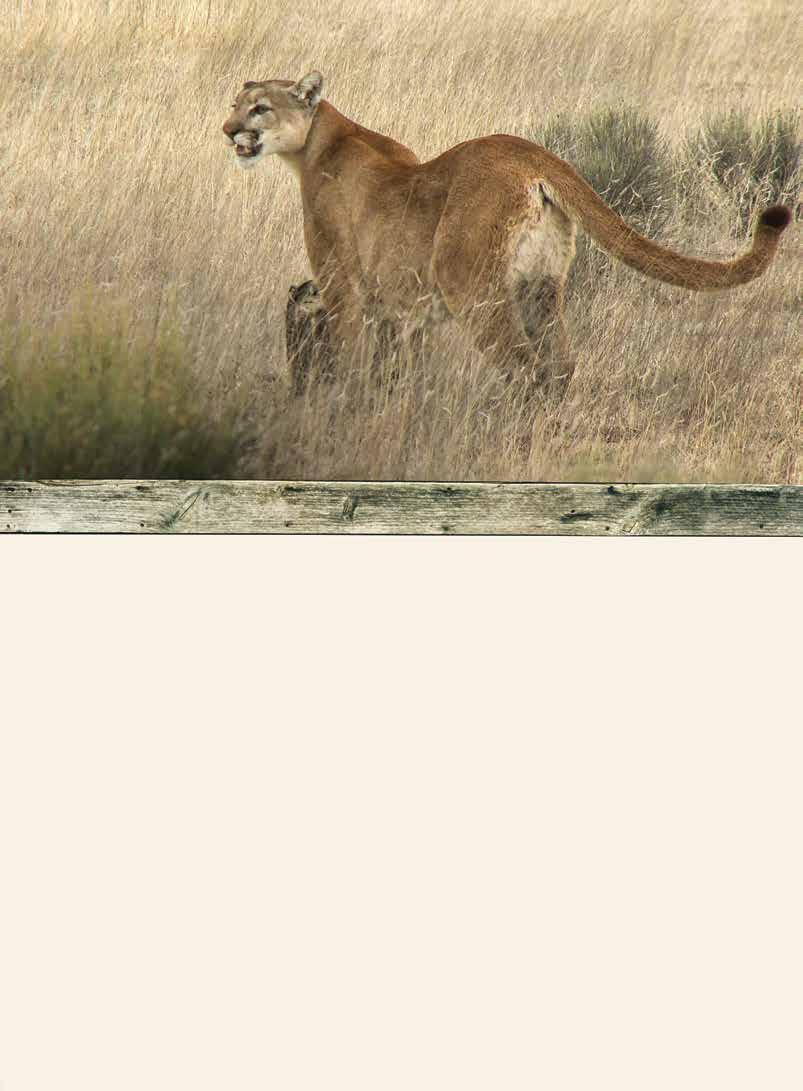
Two, I was amazed with the accuracy she took to the caller, even though the caller had been silent for at least two minutes. If she was trotting at 8 to 10 mph, she was no doubt 200300 yards away when she last heard the calls, and her line of approach caused her to almost step around it.
Three, based on my knowledge of hunting lions with hounds and knowing where to look for sign in lion country, this female came from the low hills. There are not many deer in this country, partially due to lion predation, but there was a fair amount of deer sign in the surrounding hills. When we set up to call, the wind was from the west and the call was facing north, directly away from the big cat. I was shocked she was able to hear the call in this situation.
I was also surprised she smelled my human stink on the caller, as I had set it out just over 20 minutes earlier. I am very aware bobcats don’t have keen olfactory senses, but now I believe a lion’s sense of smell is much better.
Of all the predators I call, I believe the mountain lion possesses the most sophisticated hearing. While a coyote can hear to 45,000 Hz, a lion can hear to 64,000 Hz. Now we have the ability to reach ultrasonic levels with the FREQ electronic caller, does this mean we will be calling more mountain lions? Only time will tell, but one thing is sure. Calling a mature mountain lion in the daylight is an extremely rare event.


Debbie, my wife of 42 years, was the designated hunter for the 2021-2022 deer season. She took her first deer, a doe, in 1982 on our ranch near Johnson City and since that time has taken several more deer, including some nice bucks. Like a true German, she is just as interested in sausage and hamburger meat as she is in Boone and Crockett scores. All kills were made with her favorite rifle, a Remington Model 700, .243, and it was her companion again this deer season in Medina County.
We limit ourselves to one mature trophy buck per year in cooperation with our good neighbors. This agreement has resulted in a significant improvement in the quality of our male deer not only for harvesting, but also for the sheer enjoyment of watching how they fill their niche in Mother Nature. This year, we focused on a wide 10-point buck we had watched progress over the past four seasons from a very respectable eight-point to the wide mature deer he is today. We nicknamed him “W.T.,” short for “Wide Ten” because he was pushing 22 inches in width.
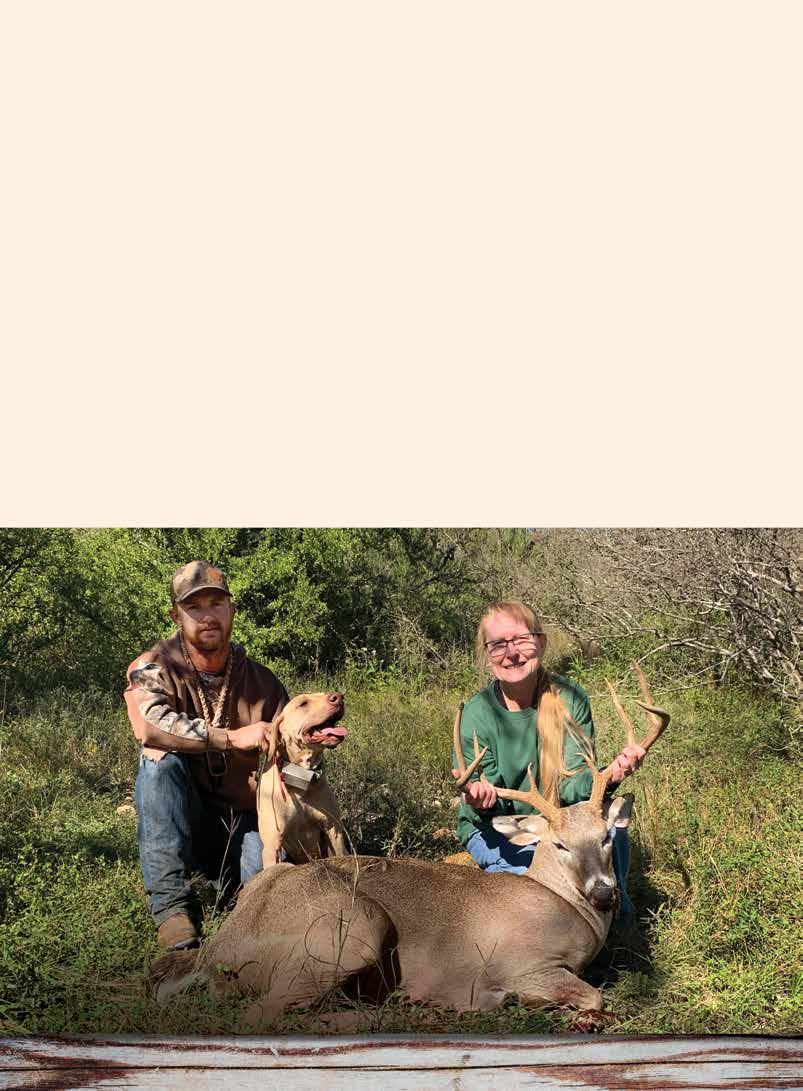
On opening morning, the creek feeder went off at 6:30 and then a dark figure materialized along the back hog panel of the feed pen. We couldn’t tell at this point if he was W.T. Soon, the light of day revealed a mature eight-point buck we had occasionally seen on our game camera. The morning progressed with a variety of young and middle-aged bucks, with does and fawns joining the mature eight. W.T. didn’t show, so we closed up shop and planned our Sunday morning hunt as we walked back to the truck. Debbie still considered her morning hunt a success in spite of not taking a buck, because she got in
4,452 steps en route to closing her exercise ring! No hunt for us Saturday evening because it’s our church night and a great opportunity to speak to “The Heavenly Ranch Manager” about sending W.T. our way in the morning.
Plotting our game plan Saturday night, we again agreed W.T. would be our first choice, but if he didn’t show, we would try to take the mature eight we had seen during the morning hunt. We had just reviewed the trail cam pictures of the eight-pointer and he looked a lot better than we had previously thought. One picture of him revealed the end result of a serious sparing match with some good old South Texas brush, and because of this we tagged him with the name “Seventy-Eight,” the eight points he had naturally grown plus seventy additional brush points. Another picture showed he and W.T. sharing the protein feeder while still in velvet. The comparison showed that either deer would be a great trophy. From that trail cam picture, we also noted the time it was taken, at midnight, and hoped the first day of deer season hadn’t already thrown the two bucks into nocturnal mode.
Sunday morning arrived with heightened anticipation that Seventy-Eight would be a shoo-in with the outside chance W.T. would show his face. Debbie and I settled into our blind at about 5:30 a.m. after making all necessary adjustments to her chair and gun rest location. I even slipped a small step stool under her feet so she would be flat footed for a more stable shot. I sure hoped Zachary, our 4-year-old grandson, wouldn’t need his step stool today.
Daylight came about 6:30 as we glued our attention to the two feeders and the three senderos radiating from our blind.
Cody Brown (left) and his tracking dog, “Tank,” helped Debbie locate her buck in some thick brushAgain, does, fawns and a mixture of bucks arrived on cue as the feeder spun out corn, but saw no sign of either buck. “There’s a big-bodied deer in the brush behind the feed pen,” Debbie said as I immediately glassed the animal. It was Seventy-Eight. He was much more jumpy than yesterday morning as he ate the fringe corn thrown outside the pen, always screening his body with the hog panels. Fifteen minutes passed, unnerving the shooter and guide as the deer’s body language signaled the potential for a quick exit: sudden up-snaps of the head, ongoing reconnaissance with his ears, and sudden changes in body direction. The buck faced the fencing and did pre-jump bobbing, then went up and over into the feed pen.
Debbie was posed for the shot but Seventy-Eight was positioned between the three legs of both the corn and protein feeders. This situation brought back old memories from Dec.10, 1998, while I took aim on a 160-plus B&C 10-point buck on a hunt near Artesia Wells. Tunnel vision to the deer’s shoulder completely blocked out the 1-inch galvanized pipe leg of the feeder as my Sako .270 bullet went through and through the pipe leg, hitting the deer with a non-lethal shot. We definitely did not want to repeat that story!
The deer and the hunter were both tense as Seventy-Eight
finally cleared the feeder legs and presented that long awaited broadside shot. BANG! The buck immediately reversed direction, tail tucked, and jumped the fence. The feed pen is completely surrounded by thick brush, so we lost sight of him after the shot. Debbie said she felt good about the shot as we waited 20 minutes before leaving the blind and heading to the truck. While my daughter Allison and her husband Joseph were in a blind about 700 yards away, we waited an additional 45 minutes so we would not disturb their hunt.
Our excitement went high as we drove to our blind to retrieve Debbie’s deer. That excitement was quickly dampened when we saw no deer, no blood, and no hair in the pen or along the outside perimeter of the hog panels. Debbie and I headed into the brush in the direction Seventy-Eight had taken after jumping out of the feed pen, and found our first drop of blood about 30 yards out. Allison and Joseph soon joined us in the search as we followed a sparse blood trail over the next 100 yards. Another hour passed as we tracked our buck along a brushy ravine, finding a large amount of blood where he had laid, and then we found nothing for the next 30 minutes. At this point we agreed we didn’t want to push the injured animal and we wanted to exhaust all efforts in finding him, so we began the search for a tracking dog.
Joseph called his friend Kailum Rooks with Lone Dove Taxidermy in Devine, who put us in contact with Cody Brown and his dog “Tank.” Cody and Tank met us at our front gate within an hour and we headed to the spot of first blood. Tank is a 4-year-old black mouth cur, lean, fit and ready to roll. The same can be said for Cody—just add 20 years and subtract a couple legs and a tail. Tank worked over the initial blood trail, and then he and Cody headed into the ravine and went quickly out of sight and sound. Because of the thick brush and concern for safety, Cody instructed us to remain with the vehicles in case we got separated and the buck needed to be dispatched. We made small talk as we waited. First 10 minutes slowly dragged by, then 15 minutes, and then at 20 minutes Tank fired up with the steady deep bay of a dog on track. It echoed through the box canyon fed by the ravine as we tried to determine distance and direction. The baying soon changed to rapid barking from one location and the crack of Cody’s open sight lever-action .30-30 soon followed. Cody’s GPS showed Tank had tracked the buck about 800 yards as he crossed the box canyon and then circled back to within 150 yards of the blind where the chase came to its end.
Debbie’s eight-point buck was a beauty, field dressing 151 pounds, with a 21-inch inside spread, and was about 6½ years old. We thanked the Lord for a quick recovery and smiled as we realized it “took a Tank” to successfully end this deer hunt.



Aug. 3, 2022 was 105 degrees, according to the blinking sign in town. I scouted for pronghorns in dusty New Mexico. With a spotting scope clamped on my truck’s window, 10X binoculars in the seat next to me and the truck’s air conditioner on high, I cruised the rocky ranch roads looking for bucks. With no luck in the public draw for a tag, I paid a hefty trespass fee to hunt on private land. Spending money on things like that is why I drive an old Toyota truck with 231,655 miles on it.
So far, the day had produced a few decent bucks and small herds of does. Total numbers were down from the last time I held a tag in this area five years earlier. The desert landscape was as bleak and dehydrated as I’d ever seen it. According to the U.S. Drought Monitor Map, this area was in an exceptional drought, or D4. The colors of the map go from yellow to orange to red to brown, with brown being the driest. This county was dark brown on the map.
Late in the afternoon, nearing a gate to enter the next pasture, a buck trotted into view 300 yards to the south. It took about two seconds looking through the 10X glass to know this buck was a good one. His horns were tall, maybe even 16 inches. When he turned sideways, all you saw above his head was black. His horns were massive with
long prongs jutting out over his nose. I guessed him at 80 inches.
The buck only stared for a few seconds, then galloped to the north. I doubt another pickup had driven through that pasture in a month. I got my 20X spotting scope on him just long enough to confirm my first impression was correct. Even through the shimmering heat waves, I could tell this was no mirage. Horn mass like that is rare and it adds up to a big number.
The windmill I’d just drove past was the only water in the pasture. The pasture was more than 1,000 acres. Due to the drought, the rancher had pulled cows from that area. I only saw the big buck, one small buck, and four does in that entire rectangle-shaped pasture. It was flat and wide open with a few patches of head-high mesquites, yuccas, clumps of grass, and lots of rock. The fences were so jammed full of giant tumbleweeds, the barbed wire fences were almost like walls. It was unlikely the buck would crawl under the bottom strand to switch pastures with so many tumbleweeds in the way. As the sun sank in the west, I set up a pop-up blind halfway down the length of the rock pond next to the windmill. I saw about 20 heartshaped antelope tracks in the soft mud around the pond.
This is the blind and waterhole where the author eventually shot his 2022 New Mexico pronghorn.
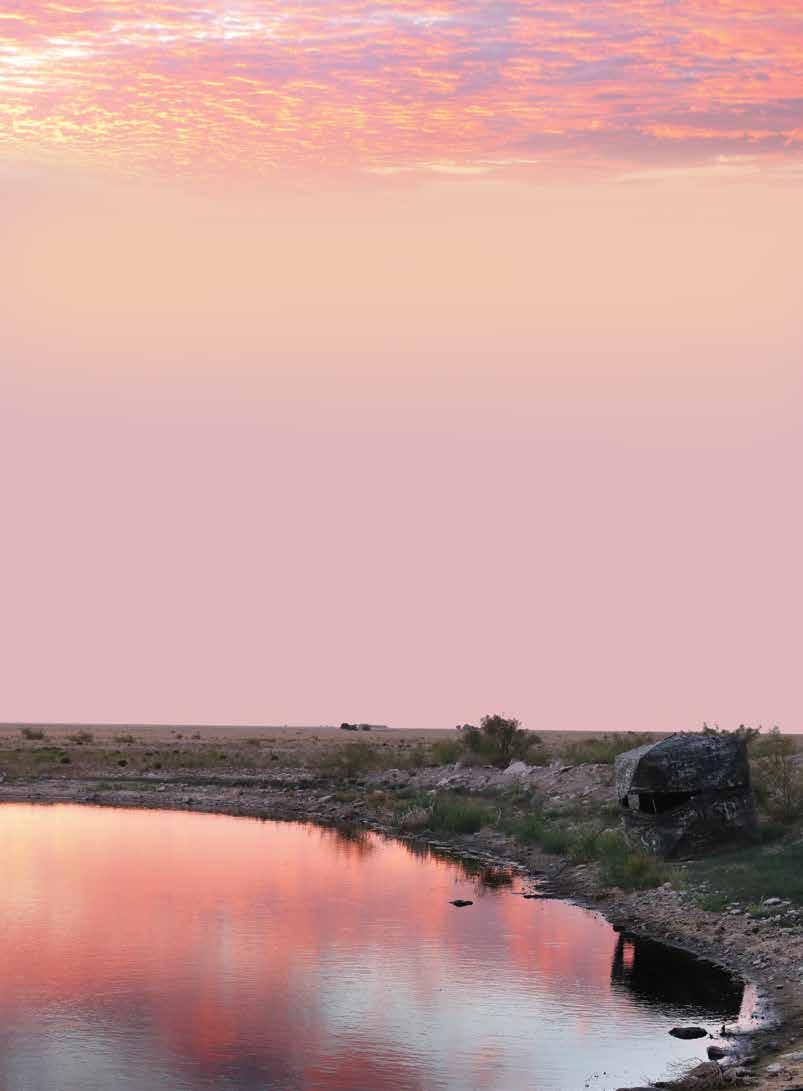
A similar scenario on another world-class buck unfolded in that same area in August 2007. I’d drawn a non-resident tag for public land. After scouting, a couple of friends and I built blinds out of mesquite branches, tumbleweeds and broomweeds at three different ponds. Antelope numbers were high and there were lots of bucks.
On Aug. 20, a heavy-horned buck we’d scouted before the season slowly made his way towards my blind. He circled behind the blind, then walked less than 10 yards from my hideout, lowering his head for a drink in the runoff pond. My arrow blasted through the ribs, he trotted 30 yards and tipped over. At 11 a.m. the temperature was 107 degrees. That buck had horns measuring 161⁄8 inches and 15 6⁄8 inches long. He gross-scored 84 7⁄8 and netted 84 2⁄8 B&C. He was bigger than any of us guessed.
If you’re serious about killing a pronghorn with your bow, you sit all day over water. Pronghorns can water at any time of the day. I’ve had mature bucks water at 7 a.m., noon, and the last blink of legal light. Leaving the blind to go to town for tacos is not smart. Pack lots of water and sports drinks, snacks, a book, and sit all day. That means 12-14 hours, depending on the time of year. But if it’s hot and dry, and you’ve done your scouting and know where the antelope are quenching their thirst, it’s a tactic that rewards patience.
I shot my first pronghorn late in the afternoon over water in northwest Colorado in 1993. Keeping detailed notes in my journal for almost 30 years, I’ve noticed two times stand out. Midday, roughly 10 a.m.-2 p.m., is a high-traffic time at water. The next productive time is late afternoon. In August in New Mexico, it’s usually at 6 p.m. until dark.
I sat at the rock pond all day on opening day. The big buck came by at noon, circled the pond out of range, and gawked at my blind. He came by a second time at 7 p.m., again circling at 100-200 yards, stopping often to stare at the blind. Then he wandered away across the desert. The high temperature was 99.
Day two was a repeat of the first. I sat all day and saw only two antelope. A small buck wandered by at lunchtime, gawked at the blind and left. It was 6:30 p.m. when I glassed the same big, heavy-horned buck I’d scouted before the season coming my way. He circled the pond for an hour, always too far for a shot, then wandered out across the prairie. The high temperature was 100. Physically and mentally exhausted, I told myself on the walk to the truck after dark, “I should have come over here two weeks ago and set this blind.” Rookie mistake.
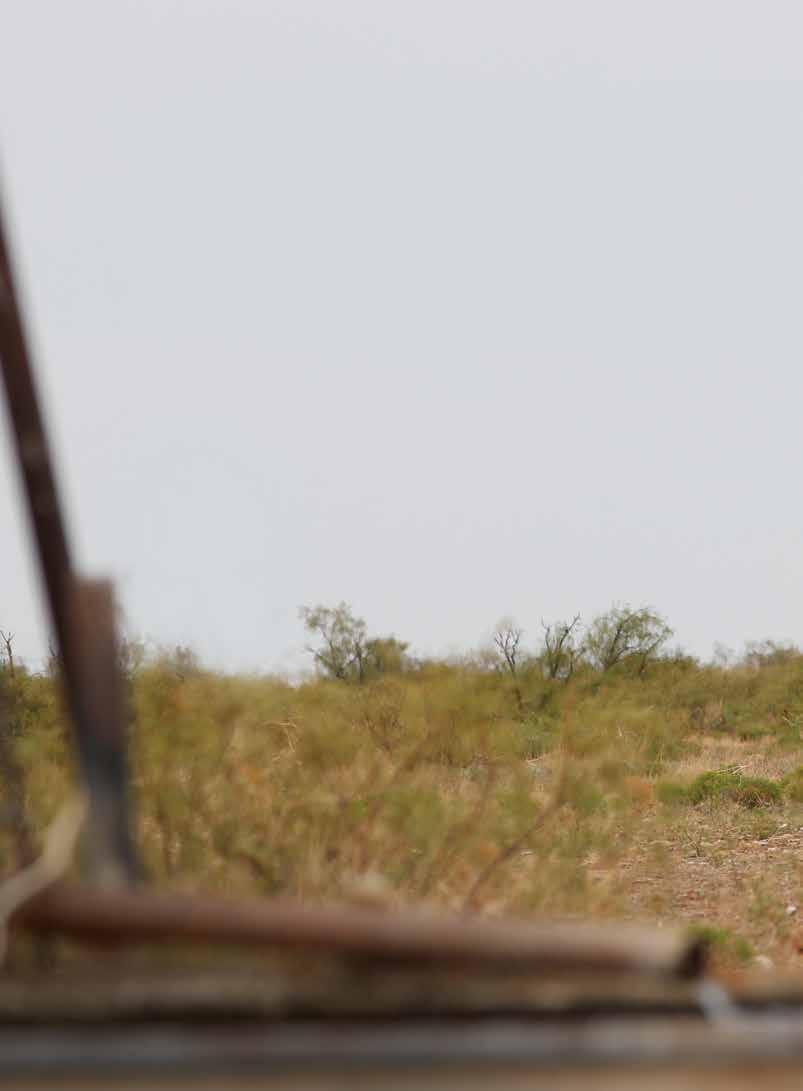
Day three, I changed locations. I needed to see some antelope and maybe change my luck. I sat in a blind concealed in tall cattails at a pond a couple of miles to the north in a different pasture. I saw 11 bucks that day, 10 of them young with promise for the future. The only mature buck I saw came by late in the afternoon, at 6:20 p.m. and drank at 55 yards behind the concrete water tank where I had no clear shot. Another very long day. The high temperature was 98.
If the best hotel is five star, mine was ½ star. That night, I sat in the simple motel room in no-wheres-ville New Mexico, listening to the hum of the old air conditioner, debating my options. I squished a scorpion in the shower, dodged a coiled rattler opening a gate that evening and wondered why I love this sport so much. Quitting and going home crossed my mind. “No, quitting is not an option,” I told myself. It was tempting to go back to the blind where I saw so many bucks, but the idea of taking the big, “loner” buck seemed to call to me. It was the challenge I needed after 30 years of hunting pronghorns. I would sit day four for that specific, big buck, or go home empty.
Maybe he would be accustomed to the blind by now.
At 10:50 a.m., I sat in sock feet in the blind at the rock pond when I saw the big, loner buck coming towards the pond from the east. Clearly, he was still uneasy about the blind. He circled for 10 minutes at 100 yards, stopping downwind often to stare at the hut-like structure. More pacing and more staring.
I sat motionless with my arrow nocked, trying to stay calm. When he paused at a laser-ranged 52 yards, I decided it was time. All the hours spent practicing at 50 and 60 yards during the hot summer months would be tested.
Windmills provide water for livestock and wildlife in times of drought.

I drew the 60-pound bow, stayed in the dark shadows of the back of the blind, then settled the pin. The 400-grain arrow hit the big buck hard mid-body, knocking him to the ground. I unzipped the blind, scurried across the hot rocks in sock feet and put a finished arrow through his heart. I gave him a moment of peace, then knelt beside him and gave thanks.
My 2022 New Mexico buck had the longest horn at 161⁄8 inches. Base measurements on both sides were over 6 inches with 6-inch prongs. His scarred-up, ivory-tipped horns green-scored 844⁄8 gross and netted 83 B&C. Guarding water paid off.
Brandon practiced diligently in the hot summer months on this life-size pronghorn target.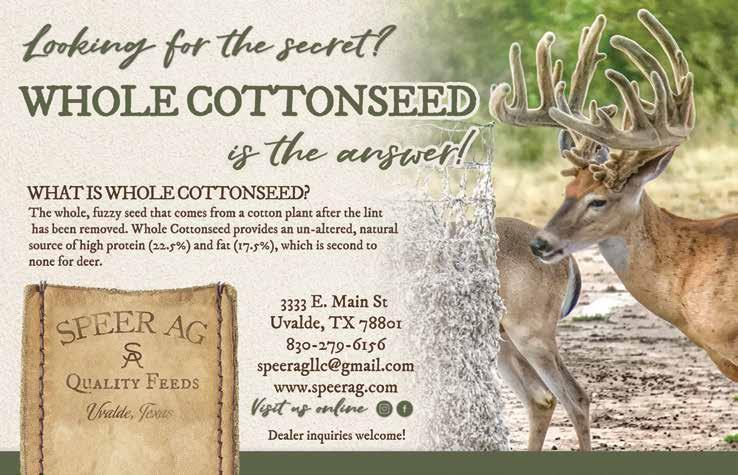

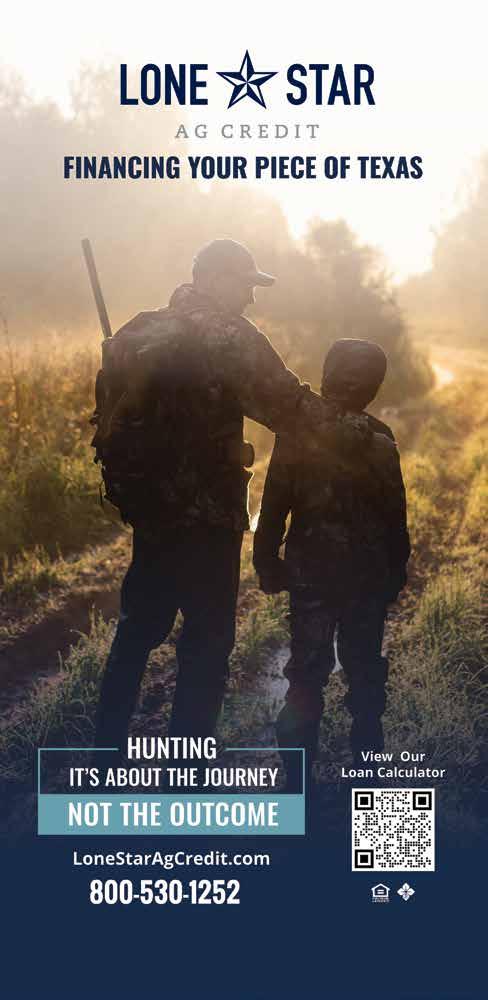

Binoculars and spotting scopes continue to improve with new technologies that start on the high-end models and eventually trickle down to the more budget-friendly items. The least expensive binocular in this roundup, for instance, is a 10X42 priced at $169.95 that comes with some of those higher-end coatings that improve light transmission and low-light performance while reducing glare. On the other end is another 10X42 priced at $3,299. But, of course, it includes a few more items, such as a rangefinder, atmospheric sensors and better optics.
Spotting scopes range from $429 to $2,721. While the budget model is compact and sports ED glass, the top-tier one promises much better optical performance

in a slightly bigger package. Another new spotting scope uses the same mil-based reticle as the company’s first-focal-plane tactical riflescope, making it ideal to pair them for long-range shooting.
The abbreviations below include ED glass, or an extra-low-dispersion lens that reduces chromatic aberration and enhances color, resolution, sharpness and contrast, especially in low-light conditions; HD, or high definition, meaning special coatings or lenses; and FOV stands for field of view at 1,000 yards.
All are waterproof and filled with gases such as nitrogen to prevent internal lens fogging. Most carry a lifetime warranty. Prices are manufacturers’ suggested retail prices.
ZEISS SFL 10X30, $1,499.99
Zeiss is going small with the latest addition to the SF line. The lightest model in the family also comes in an 8X30 for the same price. Both weigh 16.2 ounces, are 4.7 inches long and transmit 90 percent of the light. Their ultra-high-definition concept ensures greater detail and color fidelity thanks to special coatings, high-quality glass types and an improved optical design. Focusing even while wearing gloves is quick because of SmartFocus and a larger focusing wheel. For the 10X30 and 8X30 respectively, exit pupil is 3.75mm and 3mm and FOV is 426 and 360 feet.
or shoulder bag. The magnification range spans binoculars to the low side of larger spotting scopes while the 56mm objective lens can gather a lot of light. ED glass transmits sharp, clear images with accurate colors. Lenses are multi-coated. Close focusing is 9.8 feet while FOV is 216 to 98 feet. Eye relief is 15mm. Exit pupil ranges from 6.2mm to 2mm. The Hummingbird can be mounted to a tripod, monopod or vehicle window.
Known for telescopes, Celestron also manufactures hunting optics, such as this new model with ED objective lenses, multicoatings and phase and dielectric-coated BAK-4 prisms for true colors. Tripod adaptable, it’s 5½ inches long and weighs 23½ ounces. Specifications include 340-foot FOV, 4.27mm exit pupil, 15mm eye relief and 8.2-foot close focus. The body is magnesium alloy. It comes with a soft case, carrying harness, neck strap, objective lens and eyepiece caps and a lens cloth.

Weighing 20.8 ounces and measuring 8.2 inches long, this angled spotting scope can be carried in a coat pocket, belt pack
feradyne.com/covert-optics
10X42 binoculars, $549.99

Also available in an 8X42 model for the same price, these binoculars feature ED objective lenses, a BAK-4 roof-prism lens system and Diamond Bright multi-coating, which maximizes light transmission, reduces glare and resists scratches. The aluminum housings are covered in rubber moldings. Both models are 5.35 inches long. The 10X42 weighs 24 ounces while the 8X42 tips the scales at 23½ ounces. Included are a semi-hard case with strap, neck strap, eye cups, lens cloth and instructions. They’re covered by a three-year warranty.


gpo-usa.com
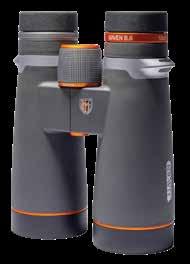

Customers requested more colors. So two new ones were introduced, Desert Sand, shown here, and Dark Brown Earth. Before, these colors were only available in the 8X32 ED and 10X32 ED models. Now all four ED models — including the 8x42 ($549.99) — will be available in Black, Deep Green, Desert Sand and Dark Brown Earth. Beneath the cosmetics, the line continues to feature a compact, lightweight body with magnesium micro-bridge, ED glass and GPObright lens coatings. For the 10X42, FOV is 340 feet, exit pupil is 4.2mm, eye relief is 16mm and close focus is 82 feet.
This new model uses the same mil-based reticle as the firstfocal-plane GPOTAC 4.5-27X50i FFP Tactical riflescope. That makes it ideal to use with that scope for longrange shooting. It also is relatively compact at 10.95 inches and 2¾ pounds. FOV is 180 feet to 60 feet. Eye relief is 27mm. Exit pupil ranges from 4mm to 1.3mm. Close focus is 34½ feet. It includes GPObright lens coatings, a double HD objective lens, picatinny rails and a honeycomb objective filter lens cap that minimizes reflections.
us.leica-camera.com/sport-optics
Pro
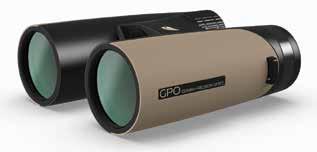
Following last year’s Geovid Pro 32 compact rangefinding binoculars, Leica introduces the flagship Pro 42, which uses Bluetooth connectivity with the new Leica Ballistics App. It can range up to 3,226 yards. With atmospheric sensors combined with Applied Ballistics, it also features GPS mapping integration through BaseMap and Google Maps. The Leica ProTrack takes tracking, surveying and game
recovery to a new level with the ability to guide the user to the target based on the last range. The patented Perger-Porro optical system delivers a high level of light transmission, resolution, contrast and a sharp edge-to-edge image.
leupold.com
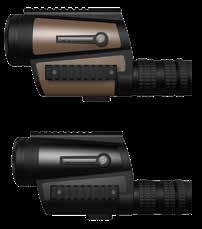

This Leupold model won’t bust the budget, but its Advanced Optical System still delivers the light transmission, glare reduction and resolution. The 52mm objective lens is the largest in the line. Lens coatings include one for scratch and smudge resistance. Features include an armor-coated magnesium body and precision focus. It’s 5.4 inches long and weighs 30.3 ounces. Eye relief is 16mm. Exit pupil is 4.3 mm. FOV is 261 feet. Close focus is 12½ feet. It comes tripod ready with a harness, lens covers and a lens cloth.
This is the first in the B series with 50mm objective lenses. It also is among the brightest mid-sized binoculars Maven offers thanks to its SchmidtPechan prism, ED glass and upgraded coatings, including one that is scratch and oil resistant. It weighs 30.6 ounces and measures 6½ inches long. The same specifications go for another new model, the B.6 12X50 ($1,100). For the 10X50, exit pupil is 5mm while eye relief is 18.1mm. FOV is 341 feet. Light transmission is rated at 94.75 percent. Near focus is 7½ feet. It is tripod adaptable.
Maven expanded its spotting scope lineup to offer a straight version of the C series angled spotter. It uses the same ED Glass as the C Series binoculars and features multi-coated lenses. It also uses a Schmidt-Pechan prism. It weighs 40.4 ounces and measures 11.4 inches long. Exit pupil is 4.3mm while eye relief ranges
a tripod adapter, a soft case, detachable lens covers and neoprene neck strap.
Sightron
sightronusa.com
SII BL HD 20-60X85 Spotting Scope, $739.99

Known for quality riflescopes at attractive prices, Sightron’s latest spotting scope packs in such features as ED glass, multicoated lenses and dual-focus adjustment, which allows the user to quickly zero in. The 85mm objective lens on this angled spotter is designed to gather a lot of light. A three-inch sunshade is built in. It comes with a codura field cover.
from 16mm to 19mm. FOV ranges from 174 feet to 81 feet. Near focus is 12 feet. It comes with lens caps and microfiber storage bag. Like all Maven products, it sells directly to consumers.
nikonsportoptics.com

Two additions to the ProStaff series are the P7 and P3. The P7 improves upon the previous P7S models with better color fidelity, wide FOV and more brightness with a dielectric prism coating and a phase correction coating. Features include oil and water repellent coating and a locking diopter ring. Other P7 models are the 8X30 ($149.95), 10X30 ($159.95) and 8X42 ($159.95). The P3 is the successor of the 3S series. The lineup expanded with 8X30 ($109.95) and 10X30 ($119.95).
The P7 and P3 binoculars share a lightweight body of fiberglassreinforced polycarbonate resin, multi-coated lenses, rubber armor and a new green body.
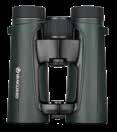
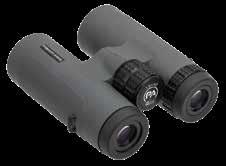
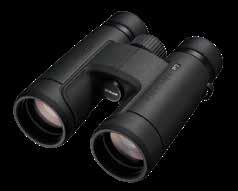
This new model is part of Primary Arms’ mid-tier line GLx, which boasts premium technology and materials at an affordable price. Features include ED glass, lightweight magnesium body with rubber armor and multi-coated lenses. They are 5½ inches long and weigh 23¾ ounces. Eye relief is 15.2mm while the exit pupil is 4.3 mm. FOV is 341 feet. Close focus is 6½ feet. They come with
North America
swarovskioptik.com
ATC 17-40X56 Compact Spotting Scope, $2,721
This new line offers an angled spotting scope with the ATC or a straight spotter with the STC. Both come in burnt orange or green armor. The ATC is 10.2 inches long while the STC is 11.2 inches long. Otherwise, they share the same specifications. A removable piece on the bottom allows use with or without a tripod. They weigh less than 35 ounces. The company promises Swarovision delivers pin-sharp contours and high-contrast images. Eye relief is 20mm while exit pupil ranges from 3.4mm to 1.4 mm. FOV is from 186 feet to 102 feet. Close focus is 11.2 feet.

vanguardworld.com
VEO HD IV 10X42 binoculars bundle, $599.99
Vanguard is packaging its latest optics as a bundle to provide more value. The bundle includes VEO Optic Guard Deluxe binocular chest harness, a digiscoping adapter and a tripod adapter. Also included are a case, neck strap and lens covers. The VEO HD IV is the next evolu-
tion in the line with Hoya ED glass, phase-corrected SK-15 prisms and multi-coatings. Eye relief is 19mm and exit pupil is 4.2mm. FOV is 340 feet. They are 5.9 inches long and weigh 27.7 ounces.
VEO HD 20-60X80
The newest spotting scope is bundled with a travel tripod with pan head and a digiscoping adapter. Also included are a lens covers and carrying case with shoulder strap. Its compositecarbon housing reduces vibration. The multi-coated lenses also increase light transmittance and makes images clearer and brighter. Eye relief varies from 19mm to 20 mm while exit pupil ranges from 4mm to 1.33mm. Near focus goes from 19.7 feet to 21.3 feet. FOV is from 110 feet to 52 feet. It is 14.8 inches long and weighs 54.7 ounces
Razor UHD 10X50, $2,499.99
Vortex says its ultra-high-definition system cuts chromatic aberration and provides top-shelf color fidelity and edge-to-edge sharpness. It’s built around a larger, phase corrected Abbe-Koenig

prism for better resolution with advanced lens coatings. Features include an armored magnesium chassis, ArmorTec coating to protect from scratches, oil and dirt. Plasma Tech is a coating process to increase durability and performance. Eye relief is 18mm. FOV is 341 feet. Close focus is 6.6 feet. They are 7.6 inches long and weigh 36½ ounces. Included are a case, harness, ammo pouch, neck strap, lens covers and a lens cloth.
Diamondback HD 20-60X85
Angled Spotting Scope, $599.99


This model was redesigned to excel in low light with the HD optical system and streamlined for a sleeker, snag-free profile including a helical focus wheel. Other models are a straight spotter ($599.99) and 1648x65 straight or angled, $499.99. The angled 20-60x85 is 16 inches long and weighs 60.9 ounces while the straight spotter is 15.8 inches long and weighs 61.3 ounces. The 16-48X65 is a tad more petite at around 14 inches long and weighs about 50 ounces. They come with a neoprene cover, tethered lens caps and a lens cloth.
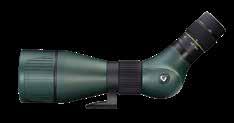
Our hunting party drove red dirt roads in the Waterberg Mountains of South Africa to an area known to have a small herd of golden wildebeests. I’ve taken blue wildebeest in the past but was now smitten by the goldens.
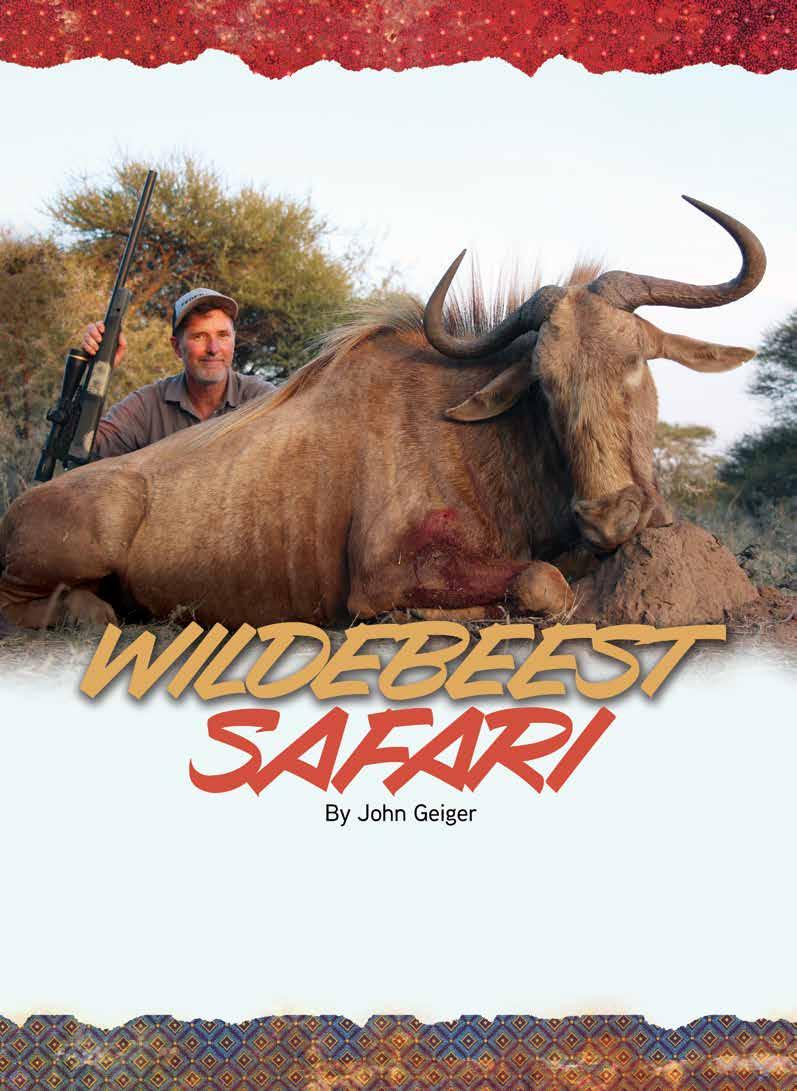
If you’ve never seen one in the wild, their color is magnificent, very un-wildebeest-ish. The most common wildebeest colors are gray-blue or black-brown found in the blue and the black wildebeests, respectively. But a golden’s flaxen coat and
mane do not fit the character of an animal known to roll in its own dung.
Whether caked in dung or not, the herd was invisible. We are pretty sure we saw the herd boss’ tracks, but we did not see one blonde lock. Gerrie Theron, professional hunter and owner of Theron Safaris, said he had seen a boss bull in the area. This was, in fact, the fifth time he had tried to get a hunter close enough for a shot.
It was possible we were on a fool’s errand: Maybe it had been killed by another hunter, or it might have left the area altogether. But Gerrie, his son Mikyle, trackers KJ and Jans, and I were counting on it still being around.
I did get a glimpse of the blonde coat the next day, but it was there and gone in a flash. It had been an epic rainy season in the Limpopo area, and vegetation was dense.
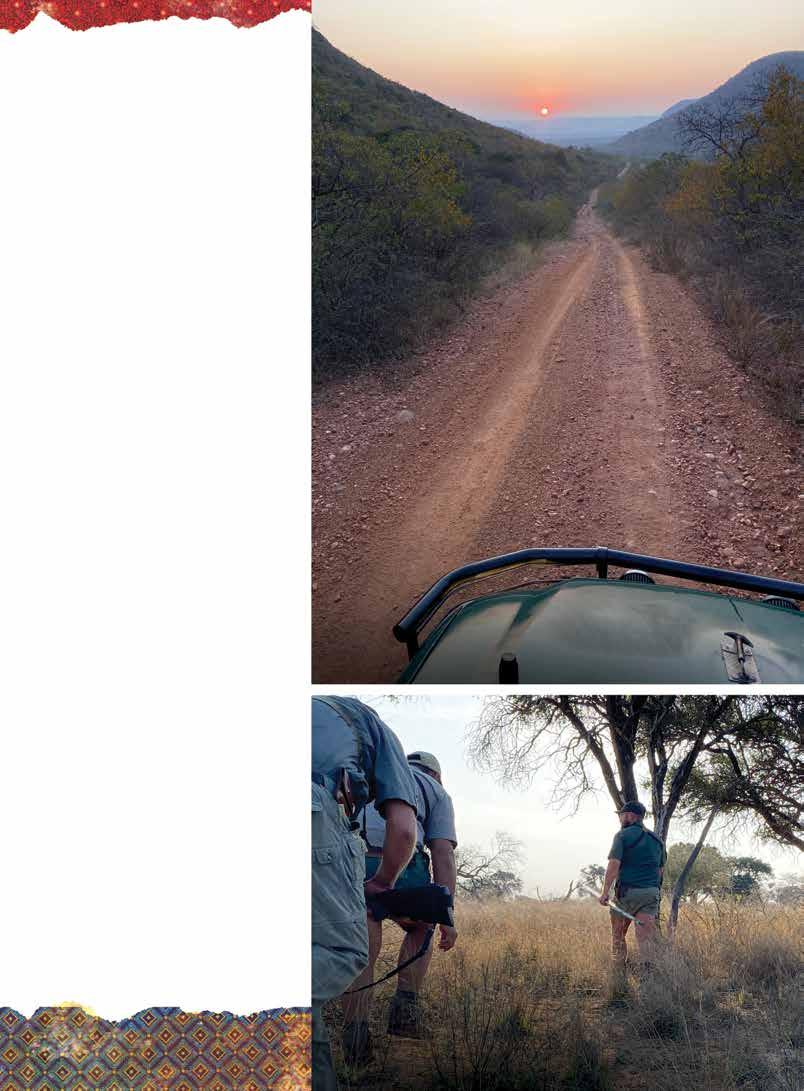
On Day 3, guides Mikyle, Tiaan van der Westhuizen, and I slowly snuck up to an open pan, glassed and saw a yellow tail flick in the buffalo thorn. He was 400 yards deep into the trees.
“I can’t let you take that shot, John,” Mikyle said, whispering while looking through a pair of Swarovski EL Ranges. “There are just too many branches between us. I’d hate to wound him if the bullet deflects. We can get you a better shot.”
We waited, but the golden didn’t.
We kept at it, following tracks and hope to reach them before they reached their sanctuary. And finally, our luck changed. We nearly stumbled upon a fine mature bull. He stood just 75 yards away and let me get my gun up. I acquired him in the scope as he stepped out from behind a buffalo thorn tree, and I slipped the 200-grain Terminal Ascent bullet into his chest. He kicked, ran 50 yards and hit the dirt. He was majestic.
Back in camp, I helped prepare the meat that would go into our traditional South African bobotie dinner the next day. The balance of the protein would go to a village near Phalaborwa. The Theron family had made a commitment to support the destitute families there.
The shot was a quartering-to, and I was excited to see if we could recover the bullet. Sure enough, it was up against the far-side skin. It was one deadly mushroom. Later at camp, I cleaned and weighed the bullet. It retained 85.6 percent of its 200 grains.
“I am very satisfied with that,” said Michael Holm of Federal Premium who had invited me on this hunt. “For that close a shot, with all that energy, that bullet performed very well.”
At 100 yards, that bullet was sizzling along at 2,660 feet per second or 1,813 mph, and it walloped the animal with 3,000-plus footpounds of force. With the bullet ending on the far side.
That’s why it’s important to bring quality ammo that performs when the shot is close as well as when the shot needs to be a long one. Federal Premium’s Terminal Ascent car-
Driving towards the sun along a picturesque South African trail.tridges are at the top of a very short list of bullets designed perform close up or way out.
What’s interesting about the bullet I used is that it’s topped with a polymer tip and is hollow, which makes it come apart easily at low velocities. Tips that are too tough can actually hinder expansion.
Accuracy also needs to be baked into any quality hunting bullet. Look for bullets with high ballistic coefficients, which indicate how aerodynamic, or put another way, slippery, the bullet will be in mid-flight. The higher the BC, the sleeker the bullet. Bullets in or near the .600 range are a good standard. The .300 Win. Mag. Terminal Ascent bullet has a BC of .604. The same caliber and weight Barnes LRX is .546, and Hornaday’s fine ELD-X is .597.
The Terminal Ascent I used performed very well on the wildebeest, as well as a white blesbok (6.5 Creedmoor, 130 grains) and boss waterbuck (.300 Win. Mag., 200 grains). Both were broadside, so no bullet was recovered, and neither required tracking. I also took a bush pig at 100 yards with a new Remington cartridge that they’ve asked me to keep under wraps until early 2023. You’ll want to check out SAFARI Magazine then. But that golden wildebeest will remain one of my favorite hunts with one of my favorite bullets.
Five years ago, I took my first wildebeest, a blue gnu on the edge of the Kalahari in Namibia. Interestingly, it was also 75 yards away, quartering-to. I also recovered the bullet on
the far shoulder, weighed it and proclaimed that the bullet performed beautifully close-in. A long shot at a red hartebeest later on assured me that the bullet was also a long-distance stud. That bullet was Federal’s Edge TLR — Terminal Ascent’s predecessor.
The Edge was an excellent bullet and everyone who shot it knew it. But Federal improved it with one main modification: They added one more groove around the belly of the bullet. Grooves give minuscule shavings and artifacts a place to go when that bullet grinds its way through the lands and grooves of the barrel. According to engineers, that change increased accuracy. Terminal Ascent was born. By getting it right, they took the bullet to the next level.
The evolution of this bullet to its present state ensured that I shot accurately, recovered all the game I aimed at and thoroughly enjoyed my experience in the Southern Hemisphere, below the Southern Cross and in the company of new lifelong friends.
It took a flight nearly halfway around the world and three days in the bush for me to get a shot at the plains game animal of my dreams. When the golden opportunity popped up, my gear and I were ready.
John Geiger is the managing editor for SCI’s Safari Magazine. If you want to learn more about SCI, please check out their booth at any one of our Hunters Extravaganza shows in Houston, Fort Worth, or San Antonio



Like most of you reading this, hunting season can’t get here fast enough. Especially for a displaced Texan living in Indiana, I count down the weeks until I can go on my annual pilgrimage to Texas to hunt. As for many of us during the last couple of years, COVID had wreaked havoc on some planned hunting trips, and often the anticipation of just being able to keep myself and my family well enough to go is a victory in itself.
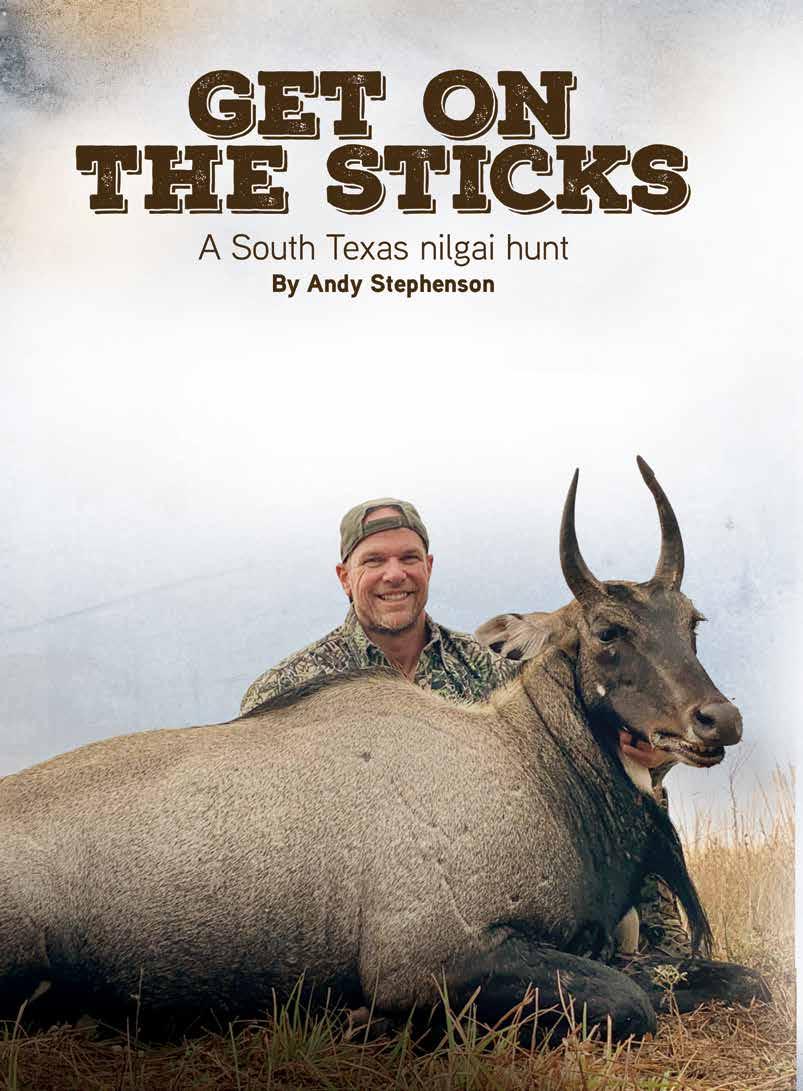
I have fond memories of hunting with my dad in South Texas years ago as a boy starting at age seven. I remember one of the first times I was in a blind and sleeping on the floor. My dad told me to stay still as he shot a deer out of the blind window above me. Many years have passed and there have been many incredible memories since those early days, but the joy of getting to hunt with my dad is always a highlight. In the last 20-plus years, we have gone hunting in North Texas together,

but have only gone to hunt South Texas once together in the last couple of decades.
If you have ever hunted in South Texas, you know it’s a unique experience, almost like being in a separate country. It’s wild, rugged, and whatever doesn’t stick you will probably bite you. You never know what you will see when you’re sitting in a blind looking at a sendero: deer, hogs, coyotes, bobcats, armadillos, badgers, green jays, turkeys, mountain lions, racoons, sandhill cranes, rattlesnakes, and the list goes on. We believe we even saw a black panther years ago.
My dad, who lives in Dallas, is now 83 years old, and as Father Time ticks on, I wanted to be able to hunt with him in South Texas once again. We have had so many great memories of years ago and I had always dreamed of hunting on the famous King Ranch. A good friend, a pastor from Ohio, had hunted there in 2021 and shot two huge nilgai, and had a great experience.
Nilgai originate from India and were brought to the United States as zoo animals. In the late 1920s, the King Ranch acquired some brood stock and the ranch’s first nilgai were released in South Texas. They did extremely well in the South Texas climate and now the King Ranch estimates around 12,000 nilgai on the low fence property. They have also populated all over parts of South Texas, with as many as 30,000 estimated to roam the costal prairies. These animals are excellent table fare. The Hindi world nilgaw—blue bull—is where we get the term blue bulls from the bluish color of the big males. The big bulls can weigh close to 500-600 pounds and are known to be elusive, cagey, and hard to bring down.
I ended up booking a hunt on the King Ranch for January 2022. My dad; his buddy Ron from Dallas; Steve, my friend who shot the nilgai the year before; and I would meet in Harlingen. We met on a Tuesday afternoon and got settled in, anticipating the hunt the next day.

It was hard to sleep that night as I dreamed of a huge nilgai bull and getting to be on one of the most famous ranches in Texas. We woke up well before daylight and drove the 20 or so miles to the gate to meet our guide Steven on the low fenced Norias Division, which consists of over 200,000 acres of the famed King Ranch. We exchanged greetings and we four piled
into the ranch truck. We drove probably 30 minutes through various parts of the King Ranch to get to the pasture where we would hunt. As daylight appeared, we saw deer, hogs, and turkeys. It didn’t disappoint.
We finally arrived at the pastures where we would be hunting. They were open like the savanna grasslands in Africa with some brush here and there. I got out with Steven and my friend Steve to start a stalk. At first, Steven didn’t want anyone to go except me, but we convinced him to let Steve go if we stayed close together. Dad and Ron stayed at the truck. We would call them to bring the truck if we took any game.
We started walking a couple hundred yards into a little flat of trees and we’re pegged by a couple of whitetail does. We stayed as still as possible as they came within 20 yards, but they moved on and we continued looking for that big nilgai bull. What I didn’t know at the time is that the freeze in February 2021 had taken a toll on the big nilgai bulls. Many had died during that freeze. Bulls were being shot on the ranch, but according to Steven, there seemed to be more of the young to middle-aged class and the old mature blue bulls were harder to come by.
We walked to a spot that overlooked a flat and we stood still for a long time. Steven was determined a bull was in the area, but after probably five or so minutes of nothing appearing, we started to move. But suddenly, right under us, a big bull tore out at about 50 yards. Steven was right! But it was too late, and even though we went to where the bull had run, he disappeared into thin air.
I have no idea how an animal close to 500 pounds can just vanish. Steven and I continued to glass with our binoculars and at about 1,000-1,500 yards we saw a bull on a fence line. We made a plan to try to make a move on him and left Steve up on a hill to keep an eye on the bull he had spotted as Steven and I tried to move in.

We had to walk towards some cattle congregated between us and the bull and hoped they didn’t spook the bull to make him aware someone was headed his way. We navigated around them and were at 500-600 yards away. The pasture the bull was in looked like something you would see in the African plains with a lot of grass and a few small scrub brush trees. We tried to stay low and close the distance as much as we could with Steven looking and signaling to me to stop every time the nilgai would look up.
It was a cat-and-mouse game because the big bulls are super wary. But we closed the distance to 224 yards. I didn’t love the location and asked if we could try to get closer. We tried to shorten the distance, but at 214 yards, Steven said this was as close as we could get. The bull was in the next pasture, and I would have to shoot through the squares of the fence.
Steven said he thought the odds of not hitting the wire were in our favor. He set up the African shooting sticks and I got down on one knee and remembered Steven’s earlier
coaching advice: Find the spot and shoot, don’t over think it, and make sure it was perfect.
KABOOM!
The .30-06 with 180-grain Barnes handloads went off. The nilgai dropped and Steven yelled, “Get up and get on the sticks. Stay on him!” I jumped up and had my gun on the bull. He was still down but Steven wasn’t convinced because most nilgai are hard to bring down and usually get up and often run away. We waited a couple minutes and then Steven said, “Let’s go,” and we ran 214 yards to where the nilgai was. We got around 40 yards, and breathing hard, Steven threw the sticks up again and told me, “Get on the sticks! Get on him!” The nilgai went down but still moved. When we realized he was down for good, we climbed over the fence.
He was a true trophy, a huge body and horns that measured 10 inches and 9.5 inches. Steven went back to call my dad and Ron at the truck to come get us. They brought the truck and we got to experience the hunt together. As we were taking pictures, a flock of turkeys walked right down the fence line we had just climbed over.
We got many pictures and got to experience God’s amazing creation together. Dad and I got to experience one of our best days together in South Texas, with new memories, a huge blue bull, and one of dozens of memories in God’s great creation that we will remember forever.
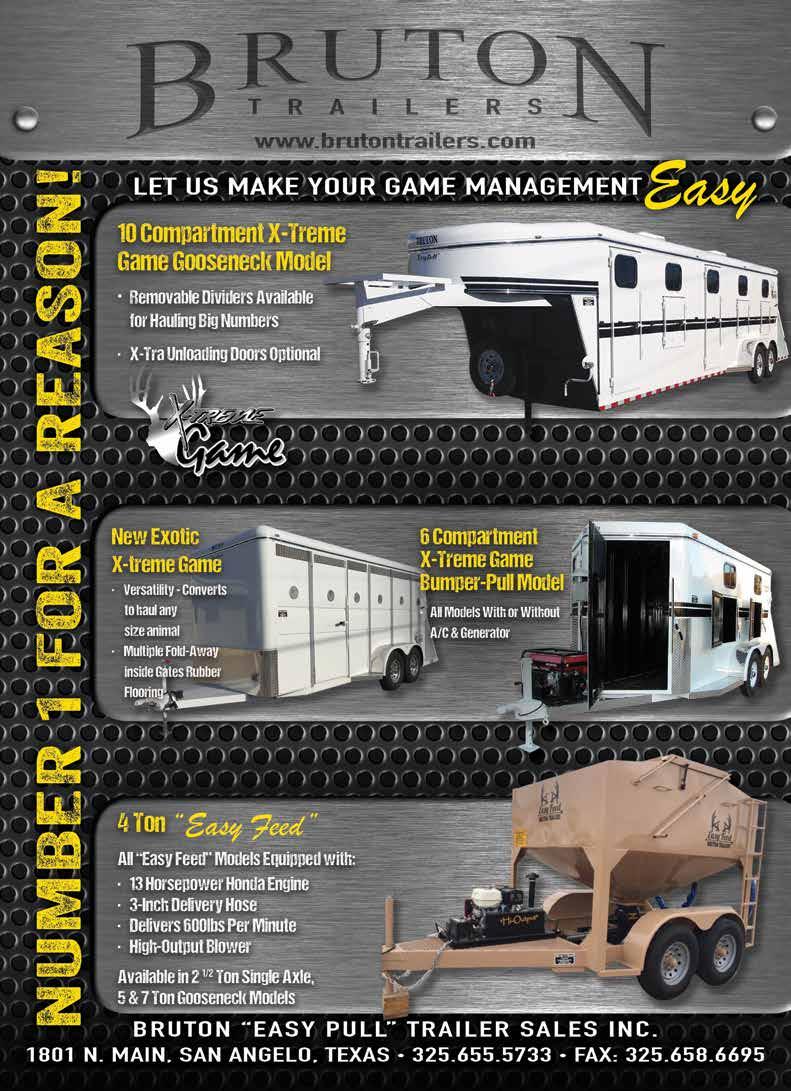

It’s a fine swine time to be a feral hog in the Lone Star state. According to the Texas Parks and Wildlife Department, the invasive animals prone to causing huge destruction to native habitat and crops can now be found in 253 of Texas’ 254 counties. Here’s a quick piece of trivia: What county have the critters not been documented in — yet?
If you said El Paso County, you are correct! However, that literature and sourcing is “as of 2021.” For all biologists know, we may have a 100% pig situation across the board, and if you know just how prolific these critters are, that’s where I’d put my money.
Simply put, we Texans have a huge hog problem and there’s literally nothing we can do about it, as wild swine—classified as feral pigs, Eurasian wild boar and hybrid populations resulting from crossbreeding of Eurasian wild boar and feral pigs—are the country’s most abundant free-ranging introduced ungulate: a fancy word for animals that have hooves.
The overall U.S. wild pig figure is estimated to have grown exponentially in the past four decades. From 1982 to 2016, the number in the United States increased from 2.4 million to an estimated 6.9 million, with 2.6 million estimated to be residing in Texas alone, according to TPWD. Again, note that that figure in the state is higher simply because “pigs have the highest reproductive rate of any ungulate.”
While pigs naturally are inclined to increase their numbers, human introduction of pigs to native habitats for hunting purposes also has been a large driver in propping up a burgeoning swine number. Wild pigs in Texas and elsewhere will eat anything and everything they can find, forage or flay, and studies have documented “intentional predation of various vertebrate including juvenile domestic livestock, white-tailed deer fawns,
ground-nesting bird nests and various species of reptiles and amphibians,” according to TPWD.
And, in all reality, there is only one real predator efficient at taking down scores of wild hogs: You, me and anyone else with firepower and time on their hands. TPWD does note that in places where alligators, mountain lions and black bears exist in Texas, some of these apex predators will snipe some hogs intentionally. However, it’s rare, and those meals don’t put any kind of dent in the local or statewide swine figure. And, if you know about basic habitat needs of those somewhat hog-killing machines, you quickly realize they aren’t going to do much damage to wild pigs.
In terms of habitat and agricultural damage, feral hogs are proficient at ruining anything and everything they can find. In
 Feral hogs are the most destructive creatures in Texas. They root around and tear up the native landscape no matter where they reside.
Feral hogs are the most destructive creatures in Texas. They root around and tear up the native landscape no matter where they reside.
2007, researchers estimated that “each wild pig carried an associated (damage plus control) cost of $300 per year, and at an estimated five million wild pigs in the population at the time, Americans spent over $1.5 billion annually in damages and control costs. Assuming that the cost-per-wild-pig estimate has remained constant, the annual costs associated with wild pigs in the United States are likely closer to $2.1 billion today,” TPWD notes.
A 2006 publication reported that wild pigs caused approximately $52 million in agricultural damage annually, but more recent studies published in 2016 and 2019 estimate that the annual loss to agriculture in Texas is approximately $118.8 million, again according to TPWD. Another negative aspect of the expanding wild pig problem here in Texas is akin to the prevalence of our native white-tailed deer herd that numbers more than four million: vehicle collisions. According to TPWD, researchers conservatively estimate damages associated with wild pig-vehicle collisions to be $36 million annually in the United States, and that figure will only increase. A family friend who is a priest here in South Texas hit a wild hog while driving at night near Tivoli and though the impact totaled the vehicle and caused it to flip, he came away without serious injury. The same can’t be said for the 200-pound pig that ran onto the highway.

As if all these factors add up to enough issues on our native landscape, wild pigs can carry dozens of diseases that can be transmitted to domestic livestock and humans. Among those are brucellosis, leptospirosis, toxoplasmosis and trichinosis. If you’re field dressing wild pigs, definitely be vigilant with your cleaning routine.
To shed more light on just how prevalent hogs are, researchers at the University of Georgia conducted a comprehensive three-year trapping study in recent years to determine wild hog fertility and mobility at the Savannah River Site, a U.S. Department of Energy installation in South Carolina. The findings proved just how prolific wild pigs are, no matter where they call home, and highlight just how hard it is to knock them back.
According to the data:
A female wild piglet can reach sexual maturity at 3 months of age given exceptional conditions and nutrition; 5 to 6 months old is typical under lesser conditions.
Wild sows bear about six piglets per litter on average, with a range of one to 12. By comparison, an average adult whitetail doe produces one to two fawns per birth, averaging between two and three only at mature ages under the absolute best range conditions.
Unlike whitetails that breed once annually, wild hogs breed all year long, at any time.
After giving birth, a sow can go into estrus again and become pregnant in as little as three months, but an average of five to six months; by those figures, the average sow can produce two full litters in a year-and-a-half.
If a sow loses its litter to predation, it will compensate by going into estrus again in about two weeks.
A previous report compiled by Texas A&M University researchers that’s now more than a decade old had predicted what we already know now: No matter where feral hogs are
found, they are winning the war that continues to be waged on them. That study deciphered that if left unchecked, the state’s feral hog tally would more than triple in five years.
It’s a good bet that it probably has despite trapping and other efforts that don’t put much of a dent into a breeding population that is simply prolific, as researchers across multiple states have found.
The most glaring figure from the Texas A&M report was the reduction rate necessary to keep the population in check. Roughly 66 percent of the animals must be taken off the range annually to keep their ranks from growing—something that’s never going to happen by any means or methods.
Simply put, feral hogs are here to stay, and they can live and even thrive in places other critters can’t.
The lone positive when talking wild pigs is they have gained notoriety in recent years as more emphasis is put on hunters procuring their own protein in the quest to go from field to table. Some of the animals simply aren’t fit to eat based on size or the condition they’re in, but most of them are downright tasty cooked up in myriad ways.
Another similarly appealing aspect of pursuing wild hogs is they can be killed in numerous means and methods, and while many landowners will charge to hunt, some may be willing to let you come out to hunt under a gentleman’s agreement for much less. That could especially be true if wild pigs are decimating the native landscape and any valuable crops.
More information: https://wildlife.onlinelibrary.wiley.com/ doi/full/10.1002/jwmg.22304


For about 15 years, trail cameras have been the best tools for getting a good buck, and managing the deer on your property or lease. The phrase “A picture is worth a thousand words” is still true today, and trail cameras are useful in showing what you have, and when you have it. I doubt there’s any deer habitat in Texas that doesn’t have a string of cameras, especially for bowhunters.
I can remember many years ago when James Kroll—Dr. Deer—used crude, experimental apparatuses he called “trail cameras,” and we all wondered if such cameras would work. Time and experience have shown us trail cameras do work, and very effectively. Many hunters who couldn’t have killed a spike before cameras are now taking big bucks.
When commercial trail cameras first came on the scene, they were mostly used to see what was coming to the feeder or water hole. Some areas of North and East Texas have shown some monster bucks in the harvest, all because of cameras. Many of these big bucks would go unnoticed if not for trail cameras, and the cameras have made some “expert” deer hunters.
Although cameras are still primarily used for harvest purposes, many landowners and game managers now use cameras to provide picture data on their deer herds, and help show what to kill and what to keep. The result is a wide variety of quality deer being harvested in Texas, as compared to 20 years ago.
The most useful cameras are at feeders, and if enough cameras are used, the general trend of the deer herd—bucks and does—can be obtained and used for management. Families can look at camera cards and decide which buck will stay and which will go. The same is true of does, where a certain number of deer need to be removed from the herd.
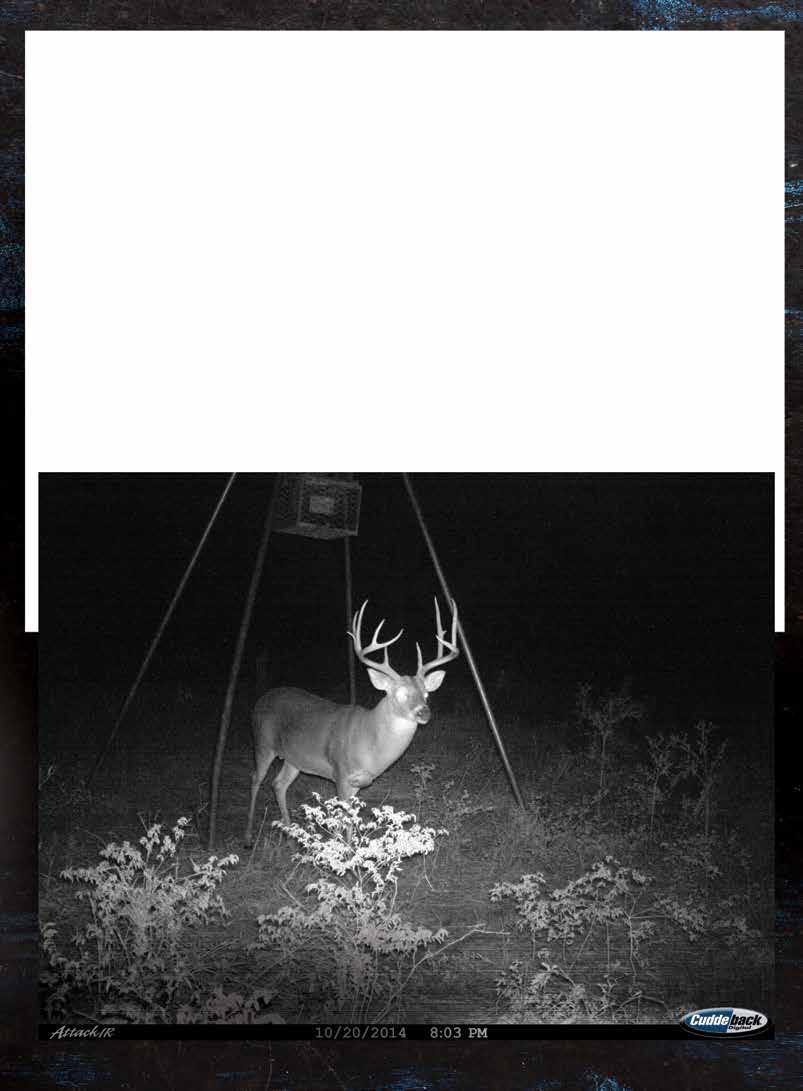
Properties with extensive management and hunting programs would be hard pressed without cameras. Private biologists, as well as family member managers use cameras as management tools on a regular basis. The result is more quality bucks, and a harvest strategy that works from camera photos. Some camera pictures that show deer on TV screens as well as showing hunters when and where big bucks are feeding or bedding, appear to be just short of cheating. There are no official rules for using cameras, and in some cases, it sets up scenarios that are like shooting fish in a barrel. However, a quality mature buck or hog is of little value unless harvested, and cameras do the trick in getting some excellent trophies. Consequently, I’m surprised Boone and Crockett has not outlawed cameras. Many, if not all B&C bucks taken in Texas are seen on camera.
In North and East Texas, where few, big mature bucks were killed before trail cameras, bowhunters now bring in some monster bucks. In three or four counties where gun hunting is
not allowed, the few bow hunters in the woods pull the string on some good bucks. I hear stories about how good hunters are at killing bucks with a bow, they have forgotten how much the camera helps them get the deer. Take down the cameras, and you have no more good bucks!
I have talked to several landowners and their families about how they use cameras to determine which bucks will be on the “shooting list.” In larger families, certain bucks will be claimed by “Joe” or “Janice,” or the family may designate a certain buck for the preacher. It’s all in fun, and a way of harvesting bucks that’s compatible to management—all because of cameras.

The greatest improvement in big buck harvest is coming from North and East Texas, where cameras are revealing bucks that would never have been seen 20 years ago. Deep East Texas is showing big bucks in the harvest like never before, and several outstanding bucks have been taken in North Texas near the larger lakes that have state and federal managed lands. The big bucks have always been there in East Texas, but thick timber and brush had kept the harvest of old bucks at a minimum until the advent of trail cameras.
I used five cameras with five corn spinner feeders on the 2,000-acre Kokernot Ranch in East Gonzales County for several years. The ranch had uplands, Peach Creek, and Guadalupe River bottom. I had two feeders in uplands, one fenced, and three in the edge of the river bottom, one fenced. All feeders were used by deer and turkeys, and hogs came regularly to the three unfenced feeders. My hunting at the feeders was always for hogs, but the deer leasers used all feeders and cameras, and my daughter Donna was allowed to kill eight-point bucks at two feeders on the far north end of the ranch.
I set my spinner feeders to run 3 to 5 seconds, morning and evening, depending on how many deer, turkeys and hogs came to each feeder. The three feeders without a fence would require moving a few feet every month because the hogs would root out a wide hole under each feeder that held water during rainy periods. Trail cameras set about 12-15 feet from the feeder revealed all wildlife that came to the
feeder, or that could be recorded by the camera at a distance. Deer, hogs, ’coons, coyotes, bobcats, turkeys, crows, doves and rabbits were recorded.
I can recall many times when I called Donna, who lived in Austin, saying, “Bring your gun as soon as you can. I saw a big eight-point on your Mesquite Pasture camera.” The calls usually resulted in a nice buck or hog that probably would not have been taken without the camera. They may take away a little of the hunt, but a camera helps put a lot of bucks and hogs in the pickup.
One of the biggest improvements in trophy bucks has come with the Hunters Extravaganza deer contests, where bucks are entered for prizes from all over the state. In recent years, the use of cameras has increased the number and quality of bucks brought to the contests in the Houston, Fort Worth and San Antonio shows. Also, most of the big bucks in stories of The Journal are killed with the aid of a trail camera. Times have changed, and so has the way we hunt and manage deer and hogs with trail cameras in Texas.


Brandon with the 13-year-old ram he arrowed from a blind in fall 2022. The ram’s horns were 32x31 inches long. Live weight was 308 pounds.
September, October prime months to witness aoudad rut
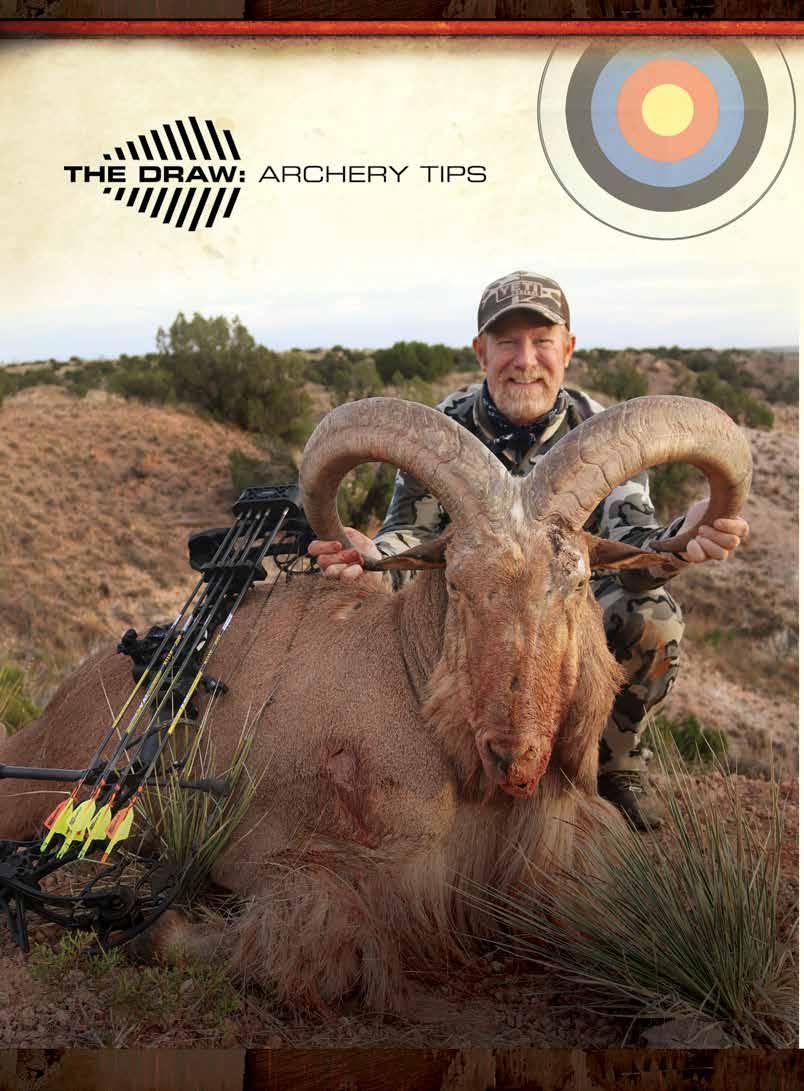 By Brandon Ray
By Brandon Ray
The September sun was red hot. Heat waves shimmered off the rocks and the prickly pear cactus quills were razor sharp, poking at my shins as I glassed the steep canyon. There below me, framed in the slanting light of late afternoon, stood a giant aoudad ram with a herd of ewes. His wide-flaring horns looked like handlebars on a custom chopper. The old ram tilted his head, his upper lip curled, inhaling the scent of a nearby female. I guessed each horn at 33 inches, maybe more, and an outside spread over 30 inches. A dream ram. I saw the same ram in the same ravine one year earlier. With aoudad clients set to arrive soon, I hoped one of my clients would get a crack at “Handlebar” in the coming weeks.
There’s no better time to arrow a big aoudad ram than during the rut. Normally loners the rest of the year, mature rams come out of their hiding places when it’s time to breed. While aoudad can and do breed year-round, peak breeding occurs in September and October. During this time frame, I see mature rams I never see the rest of the year. One research paper I have from the 1980s documents radio-collared rams in rough canyon country. Rams moved up to 10 miles during the rut.
My approach to bowhunting aoudad is a little different. Spot-and-stalk is the traditional tactic, but most of those stalks end with spooked animals or missed shots. Another option is
sitting blinds and being patient. Aoudad pay little attention to a pop-up blind set near a cedar tree. At these blinds, I set salt blocks, alfalfa hay, and a trough with corn. A trail camera on a post monitors the activity. The blind must be in the right spot, usually near a cliff edge or on the end of a well-traveled mesa, for the animals to find it and use it often. If you hunt such a setup sparingly and only when the wind is right, it’s a very effective way to get a close shot.
A mature ram is a tough target. Live weights of 250-300 pounds are common and hides are thick. The heaviest ram I ever put on a good scale was 340 pounds, live weight. Choose your bow rig wisely and set it up for maximum penetration. I recommend clients shoot 60 pounds of draw weight or more, although I have seen a couple bow rigs pulling only 50 pounds get deep penetration. The secret on those kills was using the right broadhead, waiting for a close 20 yard or less shot and a broadside to slight quartering away angle. I prefer skinny, micro diameter arrow shafts with a high front-of-center (FOC) and fixed-blade broadheads with a conservative cutting diameter. Iron Will makes excellent heads for thick-skinned game. A Slick Trick standard, Slick Trick Vipertrick and the Wasp Dart are other favorites that repeatedly perform well. A finished arrow weight of 450-500 grains is ideal for decent speed and energy for deep penetration. Quality optics and good boots are other essentials.

Here are a few highlights from my guiding duties last fall. Jeff Kelley returned for his third hunt with me. Late in the afternoon on day two, a herd of 10 aoudad came from a cedarchoked canyon. An old ram with mud-covered horns was bringing up the rear. When the ram was broadside at only 13 yards, Jeff put an arrow in the ribs. The ram’s longest horn measured 31½ inches with 14-inch bases. It was Jeff’s third big archery ram in as many hunts. His wife, Kristy, also killed a fine ram.
Houston Campbell traveled all the way from his home in the Midwest to hunt in Texas. On the first morning, a big ram ghosted into the bait alone, but just before shooting light at the South Mesa. Waiting on the rising sun seemed to take forever. At the first hint of legal light, Houston made the 10-yard shot and claimed his first aoudad. The old ram had 30-inch horns and a unique tuft of white hair between both horns. Scrolling through trail camera images from the day before, Houston’s ram was at a feed trough the previous afternoon: that trough being two miles to the north. Houston’s white-haired ram

was obviously a traveler. Houston’s buddy, Freddy, also killed a bomber ram at the same blind. Freddy’s trophy had 32½inch horns.

My old friend Clint Hukill booked a hunt and the pressure was on. The first day, we passed a decent 27-inch ram under 30 yards. Mostly, we laughed and whispered in the blind, reminiscing about kudu, eland and impalas on our 2009 safari together in Africa. Life would be boring without such adventures to remember.

It was 8:30 in the morning of day two when a herd of 18 aoudads came over the mesa at Windy Point. Each aoudad’s horns were lit by the rising sun. There were two good rams in the bunch. Clint said, “I’ll take whichever one gives me the shot first.”
At only 12 yards, the ram with the heavier bases turned broadside amongst a mob of sand-colored bodies. When the ram was clear, Clint dumped the string and the Iron Will broadhead shaved the monarch’s heart, the arrow burying to the fletching. The heavy-horned, 29-inch ram only went 20 yards before going down. It’s always nice when you can drive a truck to retrieve a big ram rather than strapping the cape to your backpack and climbing up through rocks and biting cactus.
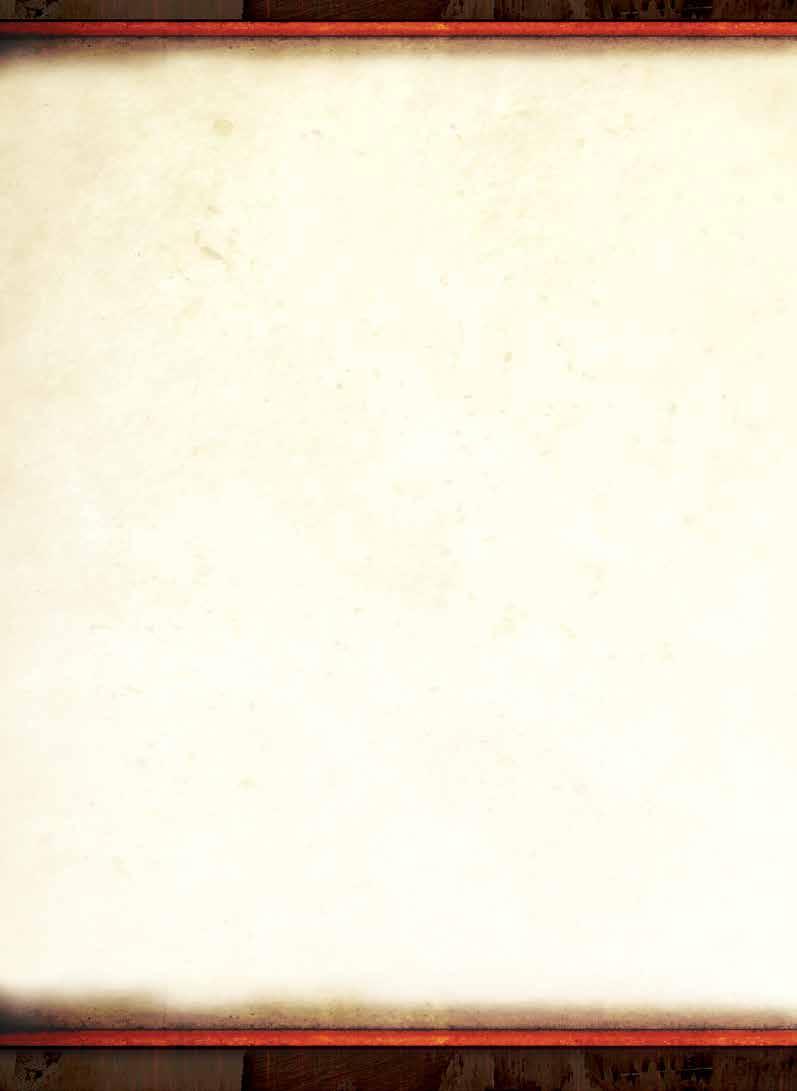
With all my clients tagged out and lots of mature rams still on the cameras, I decided to sit in a blind in early November. The rut was waning, but the big rams were still hanging with the ewes. My daughter, Emma, sat with me on Nov. 5.
It was 4:30 in the afternoon when a herd came from the west. A dozen ewes came first then Emma said, “Dad, look at those two in the back!” Two jumbo-sized rams, one with wide horns and the other with a tighter curl and scarred-up face, were trailing the mob. I examined both rams closely through my 10X binoculars and decided the scarred-up ram was the older of the two. I had seen him on the trail camera two weeks earlier at a different blind, but today he had even more scars on his rut-weary face.
I snapped many pictures of the two prehistoric-looking beasts at less than 20 yards. After all, how often do you get such an opportunity? I thought Emma was going to have a stroke. She said, “Dad, stop taking pictures and shoot one!”
To Emma’s relief, I finally traded my camera for my bow. When the scar-faced, antique ram cleared the herd at close range, I slipped a skinny carbon arrow tipped with an Iron Will Single Bevel broadhead through the ram’s ribs on a slight quartering away angle. It was everything Emma and I could do to load him whole in the truck, even with my truck parked in a low spot. The ram later weighed 308 pounds live weight. Age rings indicate he was 13 years old. His horns were 32x31 inches long with 13-inch bases.
We never saw Handlebar while hunting from a blind, but he was on my trail camera a couple more times after the hunts were over. If he makes it through another tough Panhandle winter, what a special trophy he will be. Maybe he will resurface in the rut. And maybe one lucky hunter will get to tell that special story for the rest of their life.
Jeff Kelley with his big 31½-inch aoudad ram from October 2022.

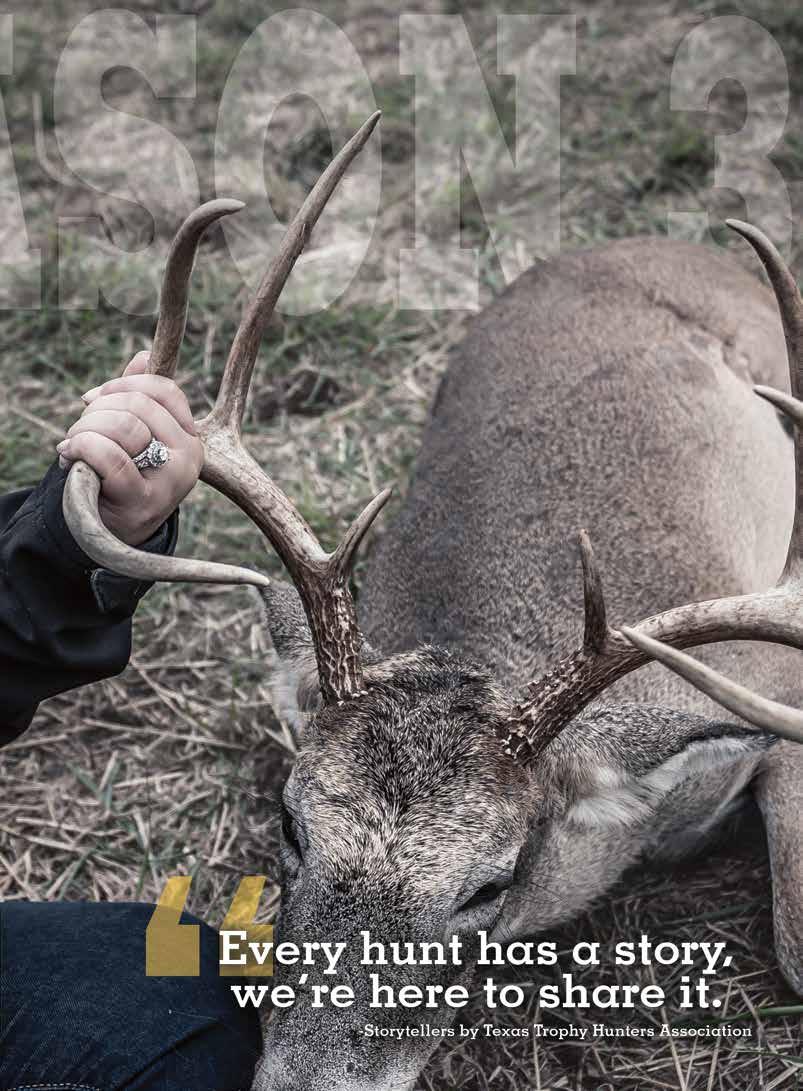
Adiminutive species in the southern half of Texas has been virtually dismissed as a game animal by today’s hunting fraternity. The collared peccary, or javelina, is hardly ever seen on the skinning rack, or in the back of a pickup anymore. I can remember when deer hunters, and especially bowhunters would bring in a young javelina to cook over the campfire, or an old boar to be mounted with mouth open to show the long, razor-sharp teeth. Those days are about over for several reasons that we will discuss in this satirical medley of time when the javelina was a treasured game animal.
Many years ago, stories were told of javelinas putting a hunter up a tree, or guarding their young while a hunter sat on a high rock, afraid to come down. Jack O’Connor, gun editor for Outdoor Life, used to write tongue-in-cheek stories of his young days in Arizona, and some wild stories about javelina. Those myths have gone out with skating rinks, but as a quail hunter I can tell you that javelinas are bad for bird dogs. A mature animal will not tolerate a dog, and my pointers have come back several times with a large gash in their rear-end. However, the tales of javelinas chasing hunters is hogwash. Deer hunters used to take a javelina or two during the season as an extra species on the hunt. Some were eaten, and some were mounted, but this interest in javelina goes back when the bag limit for deer was one or two forked-antler bucks—no does or spikes. In many areas where javelina were plentiful and forked bucks were few, hunters would shoot a

javelina just to salve their need to kill something. Of course, those times are gone, and today’s deer hunter has a five-month season with multiple bag limits, with no need to waste a bullet on a flea-ridden, stinking javelina.
There are no license tags for javelina, but the on-your-honor bag limit is two per hunter with a hunting license. Most Texas counties have no season, but the best time to hunt javelinas is the winter months. Good cooks can broil steaks, make stews, and butterfly young javelinas for the grill or baking. Javelina reminds me of eating carp fish. If you don’t have any bass or catfish, carp is pretty good. The same is true for javelina when you don’t have any venison, quail or dove.
I’ve never killed a javelina, nor had any desire to kill one. I’ve shot at them to scare them away when they were eating the corn I had scattered in a sendero. Javelinas are real pests to deer hunters who use corn feeders, or other methods of scattering corn as deer bait. They always come in a group of 10 to 20, and they can devour all the corn from under a feeder in minutes.
I suppose times have come and gone for javelina hunting in Texas. The only reason to even take a mature male javelina would be to enter into a deer contest, where javelina are one of the categories, or to enter a javelina in the Texas Big Game Awards. As a rule, many hunters don’t shoot but one, and after they fight the fleas and the stinking musk gland, they skip the javelina during future hunts.


Brandie Harris has been a park ranger and office manager at Colorado Bend State Park (CBSP) for five years. “It’s a great job! You never know what a new day will bring,” she said.

“I agree,” said park ranger and customer service representative Kayla Reaves. “There’s so much always going on. We stay busy. We’re gearing up for summer now.”
Colorado Bend State Park, west of Lampasas, is one of Texas’ most popular state parks and offers many activities depending on your energy level. The large park covers 5,328 acres, with six miles of Colorado River.
Fishing, hiking, mountain biking, kayaking, and swimming are supplemented with camping along the winding, ever flowing Colorado. Gorman Falls, coming out of the rocks, features a picturesque 70-foot waterfall, while Spicewood Springs offers a cool dip for energetic hikers trekking there. Get wet and dirty with guided cave tours for underground explorers.
The park has 35 miles of various type trails for nature lovers and birders as 155 species of birds, including bald eagles, have been sighted. Guadalupe bass, as well as an annual white bass run draw anglers from all over. Wildlife is abundant, although visitors need to be aware of snakes, feral hogs, and food-seeking masked bandits—raccoons—when camping.
“We try to educate all campers about sealing food tightly due to nocturnal marauding raccoons. We’ve had some funny adventures over the years,” Brandie said. “We’ve always been a busy park, but it seems since COVID-19 more people are getting outdoors and engaging in outside activities. We’ve seen an increase here and in other state parks.”
Brandie grew up in Dallas, but moved to Bend 20 years ago. She thrives in the office environment. The mother of three,
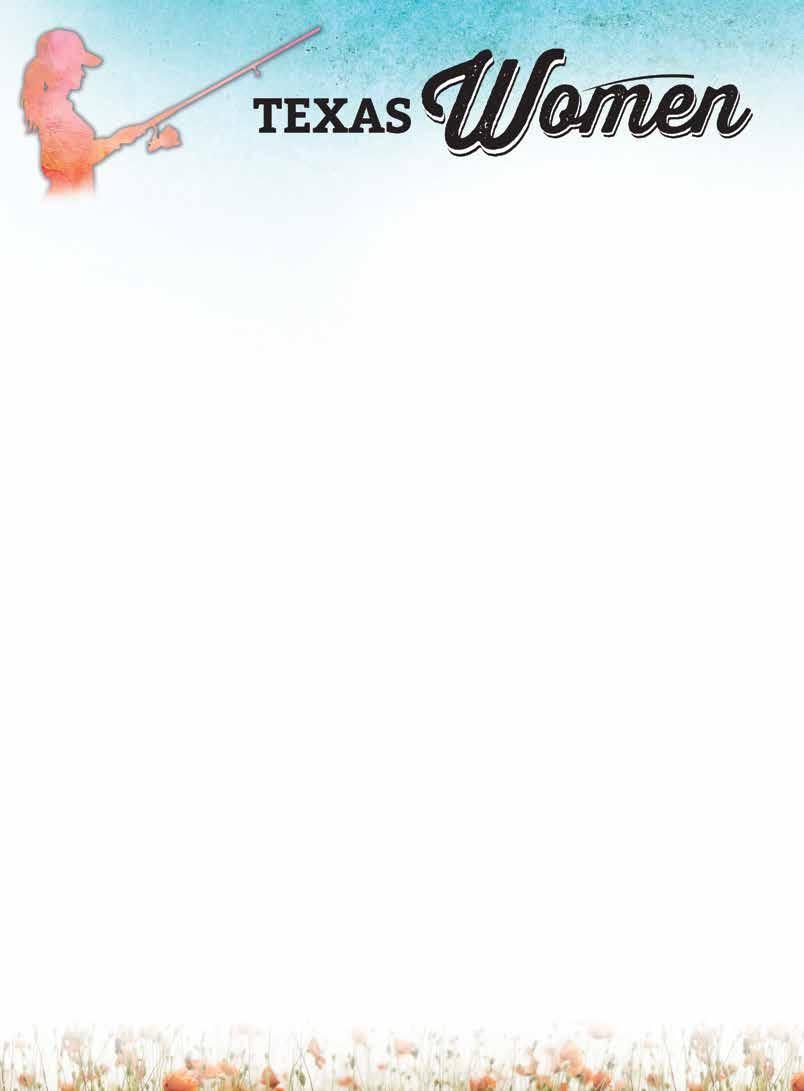
Brandie said her youngsters volunteer at the park when they’re not in school. “They’re growing up learning every day. There are so many diverse tree and plant species, rock formations, wildlife in the park,” she said. “I’m constantly learning myself!”
“We’re a bit different than Texas’ other parks as we’re more primitive camper oriented,” she added. “We have few RVs here. Rigs over 30 feet have trouble negotiating sharp road curves getting here, plus we have no RV hookups. The Colorado does flood on occasion.”
The last big river rise happened in 2018. The park closes during and after such events. Heavy rains may dislodge rocks requiring trails being checked and repaired in addition to debris removal in camping areas. The lady rangers are part of the cleaning/clearing team.
“We do a bit of everything around here,” Brandie said. “It’s part of the job. Piles of decaying brush are waiting for the right time to do controlled burning. Monitoring and maintaining healthy habitat for wildlife is something we do. Two years ago, we had a project to eliminate some ash juniper (cedar) to enable native grasses and bring back the post oak savannah like it was 100 years ago.”
Another CBSP mainstay is park ranger Debbie Hicks, the park’s interpreter. Her duties involve planning and coordinating park programs for visitors’ well-being. Many diverse groups spend time exploring CBSP’s vast acreage and offerings. Debbie has been busy this year with the 100-year celebration of Texas State Parks events. The next Centennial event at CBSP is A Day
in the Life of a Cedar Chopper.
Growing up in nearby Lampasas and now part of the tiny Bend community for 16 years, Debbie began her TPWD career at the park over 10 years ago. “I began as the park’s office manager and have been an interpreter for three years. I impart CBSP’s history, types of plants edible and medicinal, teach casting for fish, archery, atlatl (the oldest hunting form), and Dutch oven cooking,” she said. With a laugh, Debbie added, “I’ve made many a batch of biscuits and other good food. Many aspects of my job bring me joy. Seeing smiles as someone gains a new skill set or their confidence level rise is immeasurable.”
Kayla Reaves is the newest ranger who began as a seasonal employee, but became full time. She grew up in Copperas Cove but graduated from San Saba High School. This enthusiastic young lady ranger is working on an animal science degree.
“There’s so much to learn here. The teamwork aspect is amazing,” Kayla said. She’s considering taking training to become an interpreter, having worked with Debbie and Brandie nearly two years. “This job is a constant learning experience. I love it!” she said.

“We have visitors from all over: Spain, England, Japan. Communication can sometimes be challenging,” Kayla said, smiling. “Seeing families making memories reminds me of my own fishing adventures here with my grandfather. To be a part of their experiences and memories is rewarding.”
All rangers agreed their work is somewhat similar to game wardens because you never know what each day may bring. It makes their jobs fun and exciting, albeit somewhat dramatic, with possible life-changing events. Each lady recalled different situations affecting them personally: a rattlesnake-bit youngster; an injured hiker in rugged terrain; a camper suffering a heart attack.
Rescues are part of their duties. Dehydration and heat exhaustion are big issues for hikers and bikers. Slips, falls, and medical issues account for other life-saving endeavors. It’s part of the rangers’ job and not unusual for air medics to arrive on scene due to the park’s remote location.
The role of a TPWD park ranger may not be for everyone, but it fits perfectly with the CBSP’s lady ranger trio. Plan a visit and meet these dynamic rangers yourself.
 Brandie Harris (left) and Kayla Reaves greet visitors to Colorado Bend State Park.
Brandie Harris (left) and Kayla Reaves greet visitors to Colorado Bend State Park.
In every cadre of hunting and fishing aficionados there is at least one compadre who is a planner extraordinaire. No trip is too small or adventure too grand that the outdoor excursion can’t be thought through and scrutinized to the finest detail. Execution of that plan, however, is quite a different story.

Assuming the role of perfect planner in our little band of outdoor brothers was Pincher. He was tagged with this nickname because, as one campmate pointed out: “He pinches his pennies so hard, by the time they leave his hand, Lincoln’s beard is worn off.” One particularly memorable adventure began with the simple suggestion: “Let’s go wade fishing on the Guadalupe River!” The plan was to wade fish, skirting pockets of deeper water that most certainly were filled with catfish and Guadalupe bass, from a step-in point at Roadrunner
Road downstream to the bridge at Sisterdale. Most of the trip would feature an easy-walking gravel bottom, he said. “It will only take about six or seven hours and we could end up with a nice string of cats and bass,” Pincher beamed with a sly smile stretching across his face. Pincher was always such a positive, convincing fellow.
After parking my truck near Sisterdale in the pre-dawn and riding in Pincher’s ancient Jeep to a small grocery store and gas station just off U.S. 281, we wolfed down a sausage biscuit and savored a stale, lukewarm cup of coffee while Pincher carefully detailed the expedition. “No need to carry any food or water with us,” Pincher said with an air of absolute certainty about his pre-trip preparation. Food, water and other basic necessities would only be unnecessary weight and would impede our angling action. Pincher also had devoted some careful consideration to what he was convinced was a perfect solution to utilizing personal flotation devices for those rare occasions when we might encounter deep water.
A few days before the trip, Pincher had broken out his dusty wallet and purchased a trailer tire inner tube. It was the 8-inch size. It was also the cheapest model in stock. As for yours truly, Pincher suggested gathering several gallon milk jugs from my home recycling bin. Attaching them in an improvised rope/jug belt that could be tied around my waist and thus keeping me afloat in deep water was much more logical than spending money on any commercially available personal flotation device, he said, once again flashing that grin.
With fishing gear in hand, we stepped off into the cool waters of the Guadalupe just as the rising sun scattered its rays through the trees lining the waterway. A flaw in Pincher’s perfect plan quickly raised its ugly head. In order to make any progress at all through water that was often waist-high or higher, the jugs had to be controlled with one hand while the other hand and both feet were required for frantic paddling.
Skirting the riverbank in shallow stretches of the waterway provided relatively safe footing, although most of the river bottom appeared to be covered in limb-filled muck rather than the gravel bottom described in Pincher’s pre-trip plan. Meanwhile, Pincher seemed to be maintaining a comfortable, but unexpectedly rapid pace, as he floated downstream well ahead of me. As the trip ordeal dragged on to near the noon hour, yours truly came across the sun-bleached skull of an axis deer resting at the river’s edge.
Pincher, who was just barely within sight, shouted back: “Saw that earlier but did not have time to pick it up. Bring it along with you, won’t you?” Grudgingly and with much trepidation, the skull sporting 18-inch antlers was tied to my rope/jug belt.
With the antler tines now jabbing into my ribs with every step, we did encounter several spots where we managed to catch a few fish. Naturally, they were tied to a stringer also dangling from my rope/jug belt. On more than one occasion, what appeared to be knee-deep water suddenly dropped off into a deep hole that swallowed me, despite my Pincher-
recommended flotation belt.
Boiling to the surface and gasping for air time after time –losing my wide-brimmed camouflaged hat somewhere along the nightmare trip – my thoughts turned to forlorn hopes of a quick end to the ordeal. About 10 hours into the excursion of horribleness and nearing the point of exhaustion, the sound of highway traffic was discernible just off in the distance.
“The Sisterdale bridge is just around the bend,” Pincher yelled back at me. It was impossible to tell if he was smiling or not. During the last 100-yard stretch of the journey, I discovered the picked-clean skull of an eight-point white-tailed buck on the bank. “No point in asking. Pincher will want it,” was the only thought that went through my sun-baked noggin—just another attachment to my belt.

Finally reaching a spot that would allow me to safety exit the river, my eyes fell upon a Suburban parked beside my truck. Sitting on a blanket was a young family obviously enjoying a Sunday picnic. The father, mother and two youngsters stopped in mid-bite of their sandwiches to glare at what must have appeared to be a demon of the depths emerging through a patch of head-high thistles. It was a moment frozen in time.
Their eyes seemed to open wider and wider as the apparition approached them. Glancing at the dead deer skulls and dead fish dangling from my belt to my mud-streaked clothes and dirty matted hair partially covering one eye, they stared in motionless disbelief. Suddenly, the parents burst into action. They gathered up their youngsters, threw their picnic lunch trappings into the back of their vehicle and jumped into their Suburban, spinning off in a shower of dust and flying gravel. They vamoosed without hearing my shout: “Sorry to give you all such a scare. How about some fresh fish?”
Pincher just smiled, apparently preoccupied with planning his next perfect adventure.
A normal fishing adventure on the Guadalupe River—not involving deer skulls, dead fish and a horrifying encounter for a picnicking family—can be a scenic and enjoyable experience for anglers. By Horace Gore
By Horace Gore
Ikilled my first pronghorn near Roswell, New Mexico, in 1975. A nephew of the rancher got me a landowner permit, and I went alone to the Martin Ranch and took a fine 14-inch heart-shaped trophy. That hunt was the first of several with Charlie Martin, who grew up on the ranch and knew everything about pronghorns.
On my last hunt with Charlie, we were in his pickup, glassing the open plains of the ranch, looking for a good trophy. Shortly after lunch—about 2 p.m., we were glassing the outlying terrain with binos when Charlie pointed in the direction of some faraway pronghorns. I aimed the binoculars in that direction and saw six white rear ends: a buck and five does.
“How far are they—a half-mile?” I asked Charlie. “Close to that; 800 to 900 yards,” Charlie replied. “Do you want to go get that buck? He looks pretty good.” Charlie looked at my clothes. I wore nothing bright that would spook the curious animals.
Our hats could be discarded, as well as anything else we didn’t need.

New Mexico game laws prohibit driving the open plains chasing pronghorns, which meant we would have to leave the truck and walk the long distance for a shot at the buck. “You mean, leave the truck and walk in the open close enough to get a shot?” I asked. I couldn’t imagine covering open ground and getting that close.
Charlie smiled and said, “We can walk straight up for about 400 yards, stop and sit for 3-4 minutes, then walk another 200250 yards bent over, and sit some more. The last 100-150 yards will be duck-walking with no hats. Pronghorn antelope have a security zone of about 200 yards before they decide to run, and we might get lucky. I’ll show you how to stalk a pronghorn.”
When we left the truck, I didn’t have much faith in Charlie’s plan. A pronghorn can count the buttons on your shirt at 300
yards, and I had no confidence we could stalk close enough for the .270 and 4-power Weaver. After about 400 yards of fast walking, we stopped and sat on the ground. Charlie glassed the animal, and we slowly crouch-walked for about 250 yards, and sat down again.
Charlie glassed the pronghorns to detect if they were getting nervous. I glassed the group, which looked to be about 300 yards. “Take off your hat and leave your binoculars. Swing your rifle around to your chest. We will crawl another 50 to 100 yards. Don’t you look. I will tell you when to shoot.”
I left my binos in my hat, got to my hands and knees (good thing I had gloves), rifle slung underneath, and followed behind Charlie for a short distance. We stopped, and while we laid on the ground, Charlie looked at the buck. “He’s getting nervous,” Charlie whispered.
The buck looked to be about 200 yards away, and when I took aim with the .270, the tall grama grass covered my scope. “I can’t get a shot for the grass,” I whispered, and Charlie turned around on the ground so I could take a rest off his back. No good. “Come up on my butt,” Charlie whispered. The scope was now clear enough, with the crosshairs behind the buck’s shoulder, as I pulled the trigger. The .270 roared, and I could
see the does running.

“Where is the buck?” I was still on the ground, but Charlie was standing. “He’s down.” I stood up, and Charlie said, “Go take a look. I’ll get our hats and things.”
I walked upon a good, 15-inch pronghorn, admiring the horns and prongs. By that time, Charlie returned, and asked, “Where did you hit him?” I was looking for the bullet hole, when Charlie remarked,” No wonder he fell so quick. You hit him in the head!”

“In the head? I aimed behind the shoulder.” Charlie grinned and replied, “Well, you didn’t do bad—you just missed your mark by about 20 inches.” I was thinking, “Dang grama grass!” We left the buck and headed back to the truck. When we got there, I looked at my watch—4:30 p.m.
Charlie drove the truck to the pronghorn. When we got back to camp, everyone ribbed me about shooting him in the head. After they had salved their amusement, I said, “I have witnessed the longest pronghorn stalk in New Mexico history.” We bragged on Charlie for his guiding ability, but he pushed back his Stetson and smiled. “It was nothing. You just need to know your antelope.” And Charlie Martin knows his pronghorn antelope!
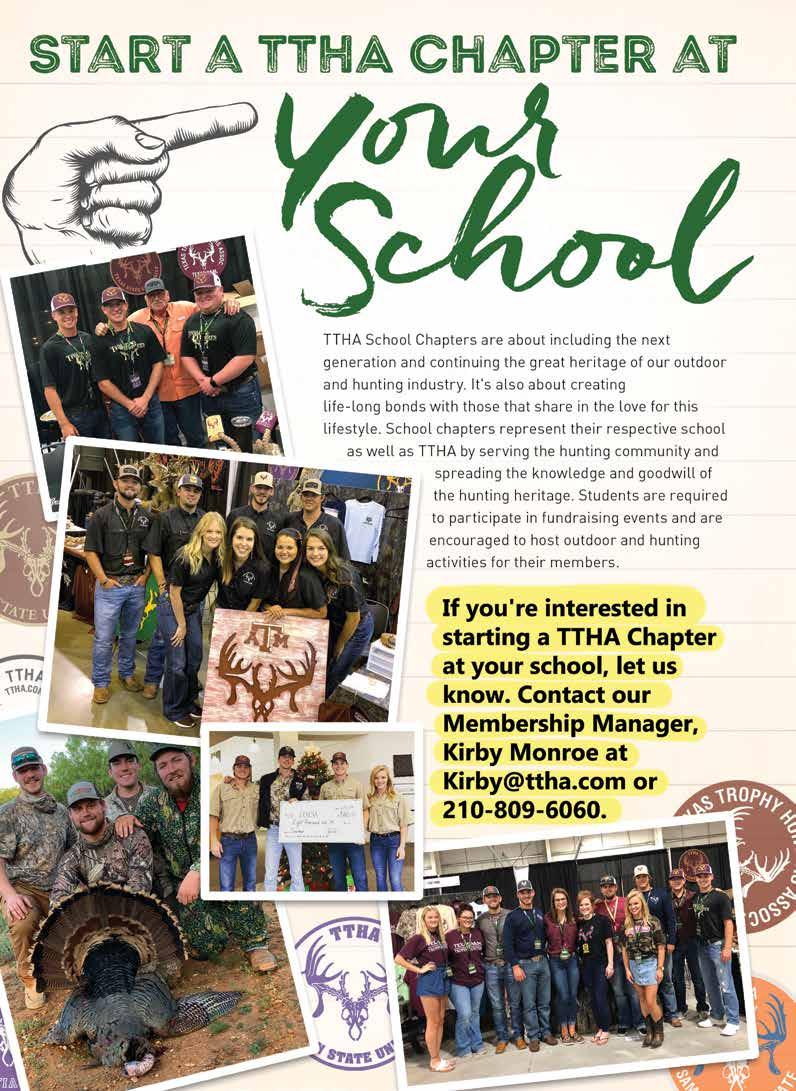





YOU WILL NEED:
• 1 pound medium shrimp, peeled
• 2 cups Clamato juice
• 2 tablespoons Worcestershire sauce
• 1 teaspoon Chef Ralph’s Super Seasoning (or your seasoning of choice)
• 2 green onions, including tops, chopped
• 1⁄4 cup celery, chopped
• Several dashes bottled hot sauce, to taste
• 1 cup uncooked white rice
Rinse peeled shrimp in cold water and pat dry with a paper towel. In a saucepan, add Clamato juice (tomato juice can be substituted) Worcestershire sauce and Chef Ralph’s. Bring to a boil over medium heat. Add shrimp (I season them with a little Chef Ralph’s before adding them to the pan) and remaining ingredients except rice. Shrimp should be cooked in about three or four minutes. Stir in rice, reduce heat to low, cover and simmer for about 20 minutes or until rice is cooked. Most of the liquid should be absorbed by the rice. —Ralph
WininghamDo you have a favorite Wild Game recipe that you would like to share with our readers? If so, please type or print recipe and send to:

Texas Trophy Hunters Association, ATTN: Editor 700 E. Sonterra Blvd., Suite 1206
San Antonio, TX 78258
This recipe was featured in Ralph Winingham’s second outdoor cookbook, “The Revenge of Old Boots & Bacon Grease.” The collection of simple, tasty dishes and wingshooting tips is among several outdoor cooking items available at ralphwiningham.com.

Fish and game move in search of food in cycles relative to the moon’s location to the Earth. The time spans listed are the prime or major period times to start each day and along each time zone meridian of longitude 75° (Eastern), 90° (Central), 105° (Mountain) and 120° (Pacific). To determine the feeding cycle time for fishing and hunting in the area you plan to fish or hunt, advance the sum of 4 minutes for each degree west and back up 4 minutes for each degree east. The next prime feeding cycle (not listed on the calendar) will be approximately 121⁄2 hours later. There are minor periods that occur between the prime or major periods. The moon’s phases are shown as New, First Quarter (FQ), Full and Last Quarter (LQ). The feeding times are not a cure-all. Weather and other environmental conditions affect wildlife feeding activity.

JULY 2023
AUGUST 2023
20 21 22 23 24 25 26
27 28 29 30 31
BEST GOOD FAIR POOR
Annual vest pocket books, which show all the major and minor periods, can be ordered by sending a check or money order for $19.95 per book. For shipping and handling, please add $4.95 to an order of 1 to 4 books. Make check or money order payable to Feeding Times. Send to Feeding Times, P.O. Box 2240, Covington, GA 30015. After October 1, please indicate book year in your order. For questions or comments, call 404-373-7151.
AUGUST

BUBBA BROUGHTON: whitetail 10-point taken 12/18/22 in Zapata County.
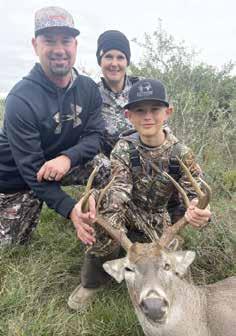

GEAR: rifle.
OUTFITTER: family lease.

CANNON KLOSTERMANN: whitetail seven-point taken 12/21/22 in Duval County.
GEAR: rifle.
OUTFITTER: Mom and Dad.
CHARLOTTE COOKE: whitetail eight-point taken 12/15/22 in La Salle County.


GEAR: .270.

OUTFITTER: family ranch.
COLE RHODES: whitetail five-point (first buck) taken 12/11/22 in Webb County.
GEAR: rifle.
CONNOR KLOSTERMANN: whitetail 10-point taken 12/21/22 in Duval County.
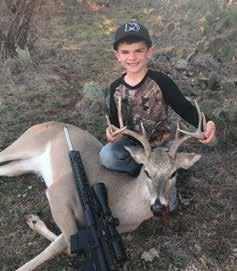

GEAR: rifle.
OUTFITTER: Silverhorn Ranch.
JERRY VILLARREAL: whitetail 10-point with 17½-inch inside spread taken 11/8/22 in Maverick County.
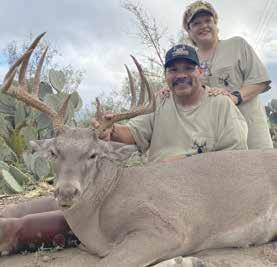
GEAR: .270 WSM, 140-grain ammo, Leupold scope.
OUTFITTER: Holden Pasture.
LUKE DANIEL MARY: whitetail eightpoint (first buck) with 14 ½-inch inside spread taken 1/13/23 in Coleman County.
GEAR: .224 Valkyrie, Hornady 62-grain Vmax ammo, Weaver scope.
OUTFITTER: Gary Martel (Paw Paw).
ZARA SHANI: whitetail doe (first deer) taken 12/24/22 in Kerr County.
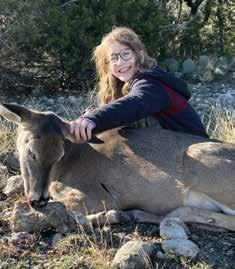
GEAR: 7mm-08.
OUTFITTER: Geggy (Y.O. Ranch).
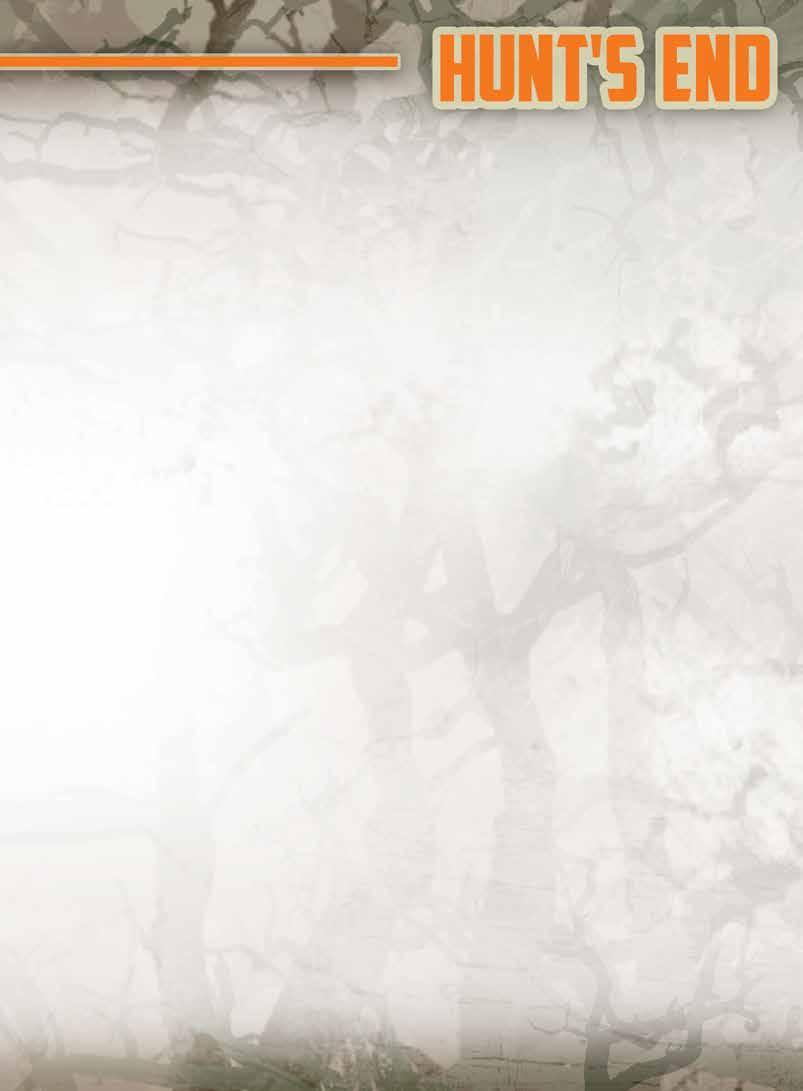
NOTE: Only members of Texas Trophy Hunters Association or immediate family may submit photos. Out of fairness to all members, only one photo of each family member will be accepted each year. Do not paperclip or staple photos as this can damage them. Prints must be no larger than 4x6 inches and printed on photo-quality paper. No photos will be returned. Photos may also be e-mailed to HuntsEnd@ttha.com. If sent by e-mail, please make sure to include all information from the form below and limit your photo size to less than 5MB. Send a separate e-mail for each entry. NO ENTRIES WILL BE ACCEPTED UNLESS THIS FORM IS COMPLETED PROPERLY.
___________________________________________ Comments: ___________________________________________________________
Send To: Hunt’s End, 700 E. Sonterra Blvd., Suite 1206, San Antonio, TX 78258




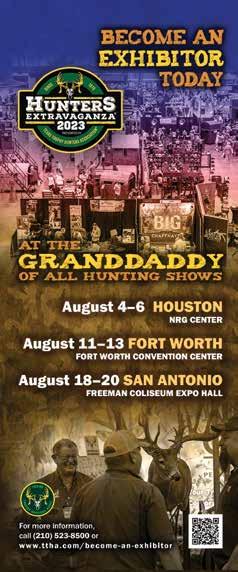



 Texas Trophy Hunters Association Round-Up ads provide excellent exposure at a minimal cost. For more information on placing your ad in the Round-Up, please contact Debbie Keene at 210-288-9491 or deborah@ttha.com.
Texas Trophy Hunters Association Round-Up ads provide excellent exposure at a minimal cost. For more information on placing your ad in the Round-Up, please contact Debbie Keene at 210-288-9491 or deborah@ttha.com.
Don’t forget to use your free classified ad!
It’s once per year and you must have an active membership in good standing. Send to:
TTHA Classified
700 E. Sonterra Blvd., Suite 1206, San Antonio, TX 78258
You may fax your ad to (210) 523-8871, Attn: Debbie Keene or e-mail to Deborah@ttha.com. Send your ad in by July 14 to run in the next issue!
Available to current members of Texas Trophy Hunters Association only! Limit 25 words per ad. Each member may run 1 FREE ad in one issue per year. 25 word ads after FREE issue are $40 each. WE RESERVE THE RIGHT TO EDIT OR REFUSE ANY AD.
CEDAR CREEK CAMO – Own your own camo company. $30,000… First and Only Cedar Pattern. LETS TALK, Kris 210.772.0803. PRICED TO SELL FAST!!!
GUIDED MANAGEMENT DEER HUNTS
Leifeste Ranch, Mason, Tx.Only Mature Deer Harvested. Lodging available upon request. Limited Trophies are available. For more info call Michael Freeman 512-633-4924. Please leave a message/text.
WANTED: South Texas Deer Lease (400-500 + acres) for 3-4 experienced, responsible adult family members. Recently lost our long term deer lease. Call Bubba (713) 398-6090.
RUSTY HINGE Ranch offers whitetail, hogs, squirrels, rabbits, coon, fox, duck hunting, fishing. Blinds, treestands, feeders & water yearround. 70 mi. north of Houston. $100/ day or $800/year. 713-823-7139.
MEXICO RANCH 8,500 ac. Trophy whitetail, protein program. 4-Day Hunt Pkgs for 2023/2024 Season. All Inclusive – transportation, permits, lodging/meals! 210-379-7510, email jharlan29@gmail.com.
VETERANS CREED OUTDOORS Team Texas. Outdoor Trips for Veterans and First Responders. Find us on Facebook on our page and group.
TEXAS LAND ASSOCIATES, INC, Representing Buyers and Sellers of Hunting Properties Across Texas. Contact Dillon Varner, Sales Agent/ Ranch Land specialist at 210-4266332 or dillon@txlandassociates.com.
C4 RANCH - WHITETAIL & Exotic Hunts. Cull, Management & Trophies up to 300”. Duval County, TX. High Fenced & MLD Managed 10+ Years. Vernon Carr (361) 774-2442.

SM FENCING, Welding and Dozing. Net wire, Barbed wire & Game Fencing. Contact Shawn Mangham 325-4517120.
CAPTAIN SCOTT’S ADVENTURES
- 956 Glenn Dr., Canyon Lake Texas 78133. Port O’Connor or Local lakes. Call 830-456-6061 for information or to book your trip.
AFRICAN SAFARI $2,995 3 animals in 1 week. Lodging, meals, open bar, guide, airport transfers and trophy fees included!! Call 956-867-4964 for details. www.matorisafaris.com.
28 YR. OUTFITTER in search of more land to outfit and hunt in Central TX. Looking for high fence with deer from 150-200”. We are outgrowing ourselves! Will also consider So. TX. Call Dale 325-642-7596 SDWhitetails. com.
MAP MY RANCH specializes in developing printed maps for all your outdoor needs. We can create basic boundary maps, or those with customized features - locations of deer blinds, feeders, food plots, ponds, etc. Contact today to get started! www. MapMyRanch.com or 713-302-2028.
RUSTY HINGE Ranch offers whitetail, hogs, squirrels, rabbits, coon, fox, duck hunting, fishing. Blinds, treestands, feeders & water yearround. 70 mi. north of Houston. $100/ day or $800/year. 713-823-7139.
HELP FEED THE HOMELESS –donate excess game animals to feed the homeless, orphans, and needy families. Go to www.trinityoaks.org “contact us” tab.
WILDLIFE & HABITAT Consulting. Commercial hunts available. Contact Certified Wildlife Biologist Jason Shipman 210-508-8447 or jasonashipman@gmail.com.
THE LONE STAR Bowhunters Association. Preserving and Promoting bow hunting in Texas since 1974. Join today at www.lonestarbowhunter.com. Take a kid hunting.
S & D WHITETAILS – Limited hunts avail. Booking 2021 now. All native S TX deer from 140-230 class. Deer & Dove hunts Central TX. Over 7500 ac. 24-yrs experience. 5 Star rating. 325642-7596.
TEXAS HUNTER FISH FEEDERS create ‘feeding zones’ that make catching fish fun for the whole family. Project fish feed up to 45ft. into the water to feed fish on a regular basis which helps you grow bigger fish faster. Call 800-969-3337 or www. TexasHunter.com.
TEXANS ARCHERY CLUB wants to expand our state’s archery range infrastructure. Looking for local partners/land to expand our network. www.TexasArchery.info 501c3.
GUIDED MANAGEMENT DEER HUNTS
Leifeste Ranch, Mason, Tx.Only Mature Deer Harvested. Lodging available upon request. Limited Trophies are available. For more info call Michael Freeman 512-633-4924. Please leave a message/text.




